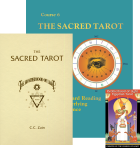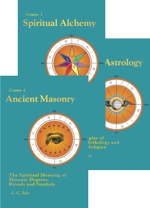|
Online Store Directory
Spiritual Meditations and Exercises
Who We Are and What We Teach
Brotherhood of Light Lessons: Course Books on Astrology, Alchemy and Tarot
Astrology Software
Calendar of Activities
Astrological Sunday Services
Church of Light TV
Classes
Quarterly
Support Us
| |
 |
|

| |
|
|
| |
 |
|
| |
 |
|
| |
 |
|
| |
 |
|
The Decanates: Brotherhood of Light Serials 103-104
A Background Briefing and Data Update
First published in Australia, 2011,
DW Sutton
Copyright 2011, The Church of Light
Contents
Part 1 – The Decanates: A Background Briefing
Author's note
At the Start
Modern Astrology – 1881 - 1924
1001 Notable Nativities
Measuring Time
Old Birth Data
Socially Significant One Day
A Summary Assessment
The Evolution of Serials 103-104
Part 2 – The Decanates: A Data Update
Aries Decanates
Taurus Decanates
Gemini Decanates
Cancer Decanates
Leo Decanates
Virgo Decanates
Libra Decanates
Scorpio Decanates
Sagittarius Decanates
Capricorn Decanates
Aquarius Decanates
Pisces Decanates
Index to charts and/or commentaries:
Henry Cornelius Agrippa
Alexander the Great
Marie Antoinette
Elbert Benjamine (CC Zain)
Elizabeth D Benjamine
Maria M Benjamine
Annie Besant
Otto Von Bismark
William Blake
HP Blavatsky
Luke D Broughton
William Jennings Bryan
Lord Bulwer-Lytton
TH Burgoyne
Sir Richard Burton
Hiram Butler
Lord Byron
Jerome Cardan
Joseph Chamberlain
W H Chaney
Charubel (John Thomas)
Chopin
Marcus Tullius Cicero
Georges Clemenceau
James Coates
Samuel Taylor Coleridge
Mabel Collins
Florence Cook
John Cooper
Nicolaus Copernicus
Nicholas Culpepper
Henrich Daath
Alighieri Dante
Charles Dickens
Benjamin Disraeli
Albert Edelfelt
Thomas A Edison
King Edward V11
George Eliot
Havelock Ellis
Camille Flammarion
Lorenzo Niles Fowler
Emperor Franz Joseph of Austria
Empress Frederick of Germany
William Ewart Gladstone
Samuel Gompers
Jay Gould
Ulysses S Grant
Sarah M Grimke
Nell Gwyn
H Rider Haggard
Franz Hartmann
Sven Hedin
Henry 1V
John Heydon
Richard Hodgson
Thomas H Huxley
Joan of Arc
William Q Judge
Emanuel Kant
Anna B Kingsford
Krishnamurti
SJ Paul Kruger
Rajendralala Mitra
Augustus Le Plongeon
Alice Le Plongeon
CW Leadbeater
Alan Leo
Bessie Leo
William Lilly
Abraham Lincoln
Louis X11
Martin Luther
Maurice Maeterlinck
George Robert Stowe Mead
Michelangelo
J Malcolm Mitchell
Thomas Moore
Alfred de Musset
Napoleon 1
Nero
Sir Isaac Newton
Henry Steel Olcott
Adelina Patti
Emperor Paul of Russia
Dr J M Peebles
Proclus
Ramakrishna
Theodore Roosevelt
George Sand
Girolamo Savonarola
Robert Schumann
George Bernard Shaw
Fred H Skinner
WT Stead
Robert Louis Stevenson
William Howard Taft
Evelyn Nesbitt Thaw
Swami Triganiteti
Leo Tolstoy
Swami Vivekananda
Richard Wagner
Alfred Russell Wallace
George Washington
Woodrow Wilson
W B Yates
CC Zain (Elbert Benjamine)
Dr Ludwig Zamenhoff
Magi Zariel
Brotherhood of Light Serials 103 – 104: A Background Briefing and Data Update
Part 1 – The Decanates: A Background Briefing

Author's Note
There are currently – in 2011 – seven billion human souls attending Aquarian Age personal development classes on planet Earth. The classroom is jam-packed with false teachings, misguided beliefs and untrue doctrines – and making sense of what's going on is not easy. You need to know that the soul uplifting teachings of CC Zain and the Brotherhood of Light provide alternative insights and critically examine all the available data. They provide you with evidence based facts and logical answers to impossible questions.
The information you get in Course 10-1 – Serials 103 and 104 – relates to the decanates. They're an important part of the astrological story, and even though these serials were written in 1922 time has not affected the authenticity of the information. But astrology is changing and during the twentieth century these changes mainly concerned the recording, documenting and gathering of birth-data.
Birth-data – the time, date and place of birth – is vital to astrological research. It's needed to validate astrological theories and to discover new astrological facts and only very accurate birth-data can be relied upon to provide authentic astrological information. But accurately documented birth-data was not readily available in 1922 and this situation not only limited the capacity to validate astrological theory it compromised the functional integrity of newly discovered astro-data. So when CC Zain provided real life evidence to support the astro-data pertaining to each decanate in Serials 103 and 104 he was relying on birth-data that very often had an uncertain or dubious level of accuracy.
So this book - The Decanates: A Background Briefing and Data Update – re-visits Serials 103 and 104 to examine the accuracy and authenticity of the example decanate references that CC Zain used. The original birth-data and its source is presented and data updates provided. The accuracy of the birth-data is rated using the Rodden Rating System. The authenticity of the reference is rated as correct, uncertain or incorrect. And finally a brief biographical sketch for each reference connects a life story to an obscure or unknown name.
The book is a companion to Serials 103 and 104 and by explaining the circumstances under which CC Zain worked in 1922 it seeks to build a bridge between then and now. My thanks to David S Braumann. He checked the words, the punctuation and the numbers.
Dennis Sutton
March 2011

At the Start
CC Zain – Elbert Benjamine – commenced writing the Brotherhood of Light lessons in March 1914. Typed pages of notes were mimeographed and made available to students attending Brotherhood of Light classes in Los Angeles. These (private) classes commenced in May 1915.
The Courses were written in sequence and in March and April 1922 CC Zain wrote serial 103, ‘The First Eighteen Decanates Analyzed’ and serial 104 ‘The Last Eighteen Decanates Analyzed.’ These were immediately made available to students in mimeographed (manuscript) form. They were the first two lessons in Brotherhood of Light Course 10-1, Natal Astrology (Hermetic System), the final section, serial 110 ‘How to Delineate a Horoscope’ being written in October 1922.
Then, in November 1922, serial 103 was published in booklet form. CC Zain explained that: ‘After having used it in class work I have somewhat revised it, and it is now made available ….that it might be presented in better form, and thus find a wider circulation.’ In December 1922 serial 104 was published in booklet form too – ’as a companion to the ‘First Eighteen Decanates Analyzed’."
The original edition of Spiritual Astrology – written in 1919-20 – did not contain the spiritual texts associated with the 48 constellations. These were first presented to students in the 1929 edition of the Brotherhood of Light Annual where CC Zain wrote:
‘It gives me great pleasure to present what I believe to be an accurate rendering of the spiritual teaching associated by the ancients with each of the 48 constellations. I have been striving for this end since writing the Course on Spiritual Astrology in 1919-1920. We have here, then, as I believe for the first time, a translation of stellar texts giving the spiritual ideals, the moral conceptions, and the practical religious doctrine of the wise men of old.’
These ‘wise men of old’; – who outlined these 48 constellations in the sky - were specialists in spiritual verities. The language they used was universal symbolism and the task of translating their message has been made a little easier by myths, legends and traditions that have been associated with the celestial signs. Most of us rely on CC Zain to explain the message. In 1935 a new revised version of Spiritual Astrology complete with spiritual texts was published. It's the version you study today.

Modern Astrology – 1881-1924
The commencement of the Age of Aquarius in 1881 instigated an astrological revival and a flood of weird and wonderful astrological notions.
The Theosophical Society had already been founded in New York in September 1875 by Helena Blavatsky, Henry Steel Alcott and William Q Judge. Then – in England – in 1884 Max Theon, Peter Davidson and Thomas H Burgoyne founded the Hermetic Brotherhood of Luxor. In 1885 they published The Occult Magazine. The practical occult information the Brotherhood offered provided an alternative viewpoint to that being presented by the Theosophical Society. The two organizations became rivals.
In 1886 Thomas Burgoyne traveled to America. There he commenced writing lessons on the occult and in 1889 these were published as Light of Egypt. In 1890 WH Chaney published Chaney's Primer of Astrology and American Urania – an important astrological text that emphasized major progressions, which Chaney called primary directions. In the same year Alan Leo – in England – joined the Theosophical Society and started Modern Astrology. Modern Astrology stood for Sun-sign astrology and the mass production of cheap Sun-sign horoscopes. In his astrological texts he explained the planets and their sign and house positions in generic terms. He contradicted everything the ancients thought and taught and by 1895 was the most popular and influential astrologer in the world.
In 1898 Luke D Broughton – who engaged in an all-out attack on incompetent astrologers for 30 years – published Elements of Astrology. And in the same year Alan Leo's Astrological Manual No. V11 published Degrees of the Zodiac Symbolized by Charubel. The degree descriptions were found psychically and have never been scientifically tested to confirm their authenticity. (Charubel's symbolic astrological degrees later influenced Marc Edmund Jones and his Sabian Symbols of Astrology.)
In 1898 Elbert Benjamine – a fifteen year old teenager – began his occult studies. At the start he was skeptical of astrology – ’the idea that orbs at such distances could have any significance over human lives was the craziest he had so far run across in his occult reading.’ But in 1899 he purchased Burgoyne's Light of Egypt and ‘the book stated astrology to be true.’ He then sent for Lily's Introduction to Astrology and an ephemeris for the year of his birth. His great adventure had begun and in 1900 – at a critical moment in time – he contacted the Brotherhood of Light. Ten years later – in 1910 – he gave his promise to write the 21 Courses of Brotherhood of Light lessons. He had given Alan Leo and all the other guys a big start, but was about to revolutionize modern astrology.
In March 1914 Elbert Benjamine commenced writing the Brotherhood of Light lessons and in May 1915 he started teaching private classes in Los Angeles. In 1922 when he wrote and published Delineating the Horoscope – originally entitled Natal Astrology (Hermetic System) – there were so many astrological systems available that he was compelled to explain: ‘The Hermetic System of Astrology is different from the systems that today find favour with the vast majority of astrologers only in that it embraces additional features. It departs from prevalent methods seldom. And then only when experience proves those methods in error. But, in addition to the factors commonly employed by the most successful astrologers, it contains others which promote greater precision, and which give to the science far greater practical utility.’
He was also compelled to clarify a number of erroneous astrological notions that had gained popular acceptance. ‘In reference to this matter of alleged good and bad signs and decanates, I wish I might impress it indelibly upon the mind of every inexperienced astrological student that every degree and decanate of the zodiac offers equal opportunity for nobility and greatness. The greatness that more easily may be attained by a person born under one decanate, however, is not the kind of greatness that may be grasped readily by one born in another.’
In the mean time Alan Leo's simple and easy to understand version of astrology, which placed the Sun-sign as the universal factor, was going gang busters. He saw astrology as a coded language that only theosophical teachings could comprehend so in 1911, when he traveled to India, he studied Indian Astrology and on his return to England attempted to merge portions of Indian astrology into his western astrological model. That's when he introduced reincarnation, karma and the evolution of the soul into the astrological chart: And in his Dictionary of Astrology he presented the Symbolism of the Decanates according to the Hindu.
In 1922 CC Zain was operating in a competitive astrological environment where many popular astrological notions were contradicted by the book of nature and logical thinking. New systems – the weirder the better – were coming thick and fast. Alan Leo had died five years earlier – in 1917 – but his astrological legacy maintained a high-public profile through the efforts of his wife, Bessie. By 1924 Astrology was at a critical crossroad. Mystical thinking was running riot and the need to place Aquarian Age Astrology on a scientific footing inspired Elbert Benjamine and Lenora Conwell to launch phase 2 of the astrological revolution – the statistical investigation of birthcharts.

1001 Notable Nativities – Alan Leo – 1911 – second edition 1916
At the start of the 20th Century the public's interest in astrology was on the rise and Alan Leo, operating out of London, was astrology's star performer providing 'modern astrology' to a public eager to know.
His data collection – 1001 Notable Nativities – published in 1911 was the first to present the house cusps and planet positions of a large number of charts which – as a ready reference – permitted their quick construction by student astrologers. These days students are more familiar with Lois Rodden's data collections and her chart data accuracy rating system, but Alan Leo's 1001 Notable Nativities set a precedent that in many ways has been followed by his contemporaries.
The book's title is a little misleading and right at the start Alan Leo explained that the title – 1001 Notable Nativities – does not signify 1001 nativities (birthcharts) of notable people. It is best described as a broad collection of important, interesting, odd and really weird birthcharts.
The book commences with an explanation to the reader regarding the arrangement of the birth data and how it is matched with the chart-data; and a note from Alan Leo – 'This book has been advertised as 'A Thousand and One Notable Nativities, compiled from authentic sources': And no doubt the compiler did his best to authenticate the source of the data he presents. But the notes accompanying the alphabetical listing of names provides very few clues as to the original source of each chart's data.
Astrological data collections are nothing new – they're as old as astrology – and Alan Leo often sourced the chart data he presented in 1001 Notable Nativities to one of these older collections or a contemporary astrological publication. These older collections include Collectio Genituranum by John Gadbury published in 1662, Tractatus Astrologicus by Gauricus Lucas published in 1542, and 'A Collection of 30 Remarkable Nativities' by Placidus de Titus revised in 1789 by Manoah Sibly.
The contemporary publications include: The Astrologer's Annual, Modern Astrology, Old Moore's Monthly Messenger and other publications such as Raphael's Prophetic Messenger and the Sphinx. But when a data collection or magazine is quoted without naming the original source of the data it can only be considered a reference. It tells us nothing about the original source of the birth data.
1001 Notable Nativities presents one (1) constructed chart and the chart data for 1000 birthcharts. The first person listed is a luckless youth who was accident prone and the second is a Prince who became a musician – Prince George. Both charts are referenced to MV accompanied by a reference to MA – which stands for Modern Astrology. They're followed by a stunning variety of Kings, Queens, Princes, paupers, Prime Ministers, celebrities, poets, artists, murderers, oddities and countries. There's the precisely timed chart of King Edward V11 of England – the chart of Yum, Yum – the well-known Theosophical dog – and the incorrect charts for the USA and Australia. The one (1) constructed chart belongs to Sven Hedin – a Swedish explorer. Judging by Alan Leo's notes the same problems that confront astrologers today were around a hundred years ago. Celebrities, in particular, had conflicting birth data which prompted a student to write: 'It is considerations such as these (conflicting birth times) that make the investigator very cautious in accepting reputed birth-times of celebrities'.
A data accuracy rating system did not exist then, but in 1001 Notable Nativities Leo does clarify the birth information. He identified the birth time as speculative (spec hor), approximate (ta) or uncertain (tu); and sourced the data to other data collections, the family bible or private sources. If necessary the birthplace was identified as approximate (ba).
Leo even comments that: 'Most medieval writers, and some modern ones, in publishing a horoscope merely state that the native was born at such and such a place and time, omitting all reference to the source of their information, and leaving it to the reader's inductive powers to discover that too often the horoscope is based upon some more or less trustworthy process of rectification!'
He also states that 'comparatively few of these medieval horoscopes can be regarded as entirely authentic in the sense we are now accustomed to employ the word. The nativities of Nero, Alexander the Great, Cicero and others dating from times BC are given for what they are worth, as interesting subjects for study in the way of research. But the young student may perhaps need to be reminded that such horoscopes will almost certainly have been calculated in comparatively recent times and based on documentary evidence that is possibly of questionable value, and he should therefore regard them as not above suspicion.'
1001 Notable Nativities does not give the time, date or place of birth. Alan Leo stated that 'they can if necessary be ascertained from the sources given'. The positions of the planets and house cusps are given in degrees – the minutes being omitted. The nearest degree is most often given, but in some instances Leo gives the nearest half degree.
Leo's comments regarding the general accuracy of birth times in 1916 are well worth noting. He wrote: '….But there is another factor, and that is the accuracy of the stated birth time. General experience in connection with the varied work of 'Modern Astrology' office shows that the average recorded birth time may be presumed correct within ten minutes or a quarter of an hour – i.e. within three or four degrees of the MC. The reader may therefore feel quite safe in allowing (but not exceeding) a similar margin in regard to most of the horoscopes in this book, remembering that time is likely to be more accurately known when birth takes place during the day than during the night.'
He concludes; 'It is quite true it is very difficult to obtain perfectly accurate birth times, and that in consequence most published nativities must be regarded as more or less approximate.' And this situation resulted in the widespread practice of rectifying the birth time. In fact rectifying the chart, due to doubts about the accuracy of the birth time, became an accepted astrological practice engaged in by all astrologers at the time, including the Church of Light.
The accuracy of the birth time was always the problem and as new birth times surfaced Leo provided data updates. In the second edition of 1001 Notable Nativities he updates the data for Bulwer-Lytton, Franz Hartmann, Annie Besant and George Bernard Shaw all of whom were used as decanate references by CC Zain.
With regard to George Bernard Shaw Alan Leo explained that he got the data from Miss I M Pagan who stated: 'I had the information about Mr Shaw's birth from his older sister who declared she remembered most distinctly being told the hour when the arrival of a baby brother was told to her on awakening in the morning. Her mother corroborated; but was less certain. It was thereabouts, i.e. about 12.40am, 26th July 1856, Dublin. Miss Shaw was very young at the time.' But the time given by Bernard Shaw's sister wasn't quite right. A chart timed for 12.25am is presented on page 100 of B of L Course X-1 – and Shaw participated in the Church of Light's writer research project. In the end a note in the Family Bible stated that George Bernard Shaw was born at 12.55am.
It is interesting to note that Alan Leo concluded 1001 Notable Nativities with a comment on statistical astrology. 'It is a simple matter' he wrote 'to go through the list of names (in the book) and collect together those that have any characteristics in common – e.g. royalty, artistic genius, administrative ability, self-improvement as regards social position, unhappy married life, etc, etc.' But his 'simple matter' was not as simple as it seemed and astrology still lacks a comprehensive foundation of statistically proven scientific facts.
1001 Notable Nativities has a special place in astrological history. It's a very important collection of charts, but over time its inadequacies have become more and more apparent. The time of birth is rarely given and can only be deduced from the chart – after it is calculated, which is not difficult with a computer. But by not noting the time, date or place of birth or stating the source of the birth data the book has lost its credibility as a data collection. In fact a number of commentators now dismiss the collection as next to useless. But in 1922 when CC Zain desired to give students practical examples of how the decanates influenced the life 1001 Notable Nativities was the best data collection available.
In 1922 and 1923 when CC Zain wrote Serial – 103 – First Eighteen Decanates Analyzed – and Serial 104 – Last Eighteen Decanates Analyzed – he needed a ready reference that students could easily access and at the end of each of these serials he stated: 'With a few exceptions, so that students may have easy access to the charts cited and thus study the other factors contributing to character and accomplishment, I have used as examples persons whose charts may be found in the book 'Thousand and One Nativities,' by Leo, which we can supply for 65 cents.' Constrained by his environment he only had one option – he had to go with the best that was available.
The Brotherhood of Light text that relies most heavily on the presentation of example charts is Course 16 – Stellar Healing. There the house cusps and planet positions of the charts used as references are listed in a manner similar to that adopted by Alan Leo. But this was a different time and place and while the method of presentation was the only way to provide students with chart data necessary for study and reference purposes the computer age has revolutionized all that. Since then all the charts presented in Course 16 have been made available – with their aspect grids and astrodyne reports – in the two-volume set The Stellar Healing Chart Book by David S Braumann.

Measuring Time
There's no doubt that the astrologer, more than any other member of the community, has a vested interested in time: And while every one knows their date of birth the astrologer knows that this bit of personal information means very little unless it's accompanied by an accurate birth time (and place).
The guy who divided up the day into hours and the hours into minutes did the astrological community a very big favor, but the accuracy of the astrological data provided by your birthchart and the accurate timing of the events and conditions it displays depends upon an accurate birth time – and this depends upon the accuracy of the clock that timed the event and the attention to detail of the person doing the timing.
The time on your wrist watch is determined by the sun's position in the sky. It's set to standard time – and all the cities and towns in the state or region where you live have been using this standard time since who knows when: And while there's no doubt that the clock that timed your birth was set to standard time – or daylight saving time - it's not precise enough for an accurate birthchart. The difference in degrees and minutes between your birthplace longitude and the degree of longitude that determines the standard time meridian represents a small time correction that must be made to convert the standard clock time to Local Mean Time – the time needed to calculate an accurate birthchart.
Local Mean Time came before Standard Time. It was very convenient for astrologers, but not for modern life and if you had been born in the nineteenth century chances are your birth moment would have been recorded in Local Mean Time.
Local Apparent Time came before Local Mean Time. It's the time as shown by the sun at a location – so all the nearby towns in a region had slightly different times. Local Apparent Time (LAT) was replaced by Local Mean Time (LMT) in England in 1792 and its safe to say that any birth – anywhere – that occurred before this date would have been recorded in LAT. George Washington's birth in 1732 was recorded in Local Apparent Time – and his birth would have been timed by a clock or sundial. The birth times of the twenty-one (21) identities born before 1792 who were used as example decanate references by CC Zain were recorded in Local Apparent Time. Each needs a Local Mean Time correction and when researching these charts it was difficult to know if the correction had already been made or not. Working with older birth data - originally recorded in Local Apparent Time - has now become an astrologer's nightmare.

Old Birth Data Can Be Very Unreliable
Twenty one (21) of the one hundred and eight (108) birthcharts used as example decanate references by CC Zain were of 'personalities' born before 1732 – and working with older birth data is a very risky business. The oldest reference was Alexander the Great born in 357 BC: And you may well ask what are the chances of having a reliable time for a birth that occurred so long ago – and the answer is nil! Astro Databank gives Alexander four different dates in three different years so CC Zain's reference to the great military leader being born with the Moon in the first decanate of Virgo is incorrect. The most recent decanate reference was Evelyn Nesbitt Thaw – born December 25, 1884 – but it too is incorrect. The Moon in her birthchart was not in the third decanate of Pisces.
Of the twenty one older birthcharts used as decanate references by CC Zain eight (8) are correct, four (4) are uncertain and nine (9) are incorrect. Since then, seventeen (17) of these charts have had a data update which means that the original chart-data presented in Notable Nativities was the problem. Of the four (4) charts that didn't have a data update one has a B – for biography – rating; two have a C – for caution – rating; and one – the chart for Nicholas Copernicus – has a AA rating. The current state of play regarding the accuracy rating of these twenty-one older birth charts reveals that:
Three (3) have a AA rating; three (3) have an A rating; four (4) have a B rating; five (5) have a C rating; five (5) have a Dirty Data rating; and one (1) has an XX rating – birth date unknown.
A calendar allows the birth date to be recorded but the birth time requires a clock - and there wasn't one on the delivery room wall to time Alexander the Great's birth. Time measuring devices were available – a sundial or water clock could have been used, but spring driven portable clocks were not produced by clock-makers till the 1500's and the electric clock was not invented till 1840. This explains why so many births were recorded as having occurred at sunrise or sunset.
Then with the introduction of the Gregorian Calendar by Pope Gregory on October 15, 1582 ten calendar days instantly vanished and every birth date – prior to this date - required a New Style correction to bring it up to date. But the New Style Gregorian Calendar was not universally adopted on October 15, 1582. England, for example did not adopt it till 1752. So – since then - astrologers have been plagued by two messy problems: Was the birth date recorded in old style or new and did it require a new style correction or had the correction already been made?

Socially Significant one day – Forgotten the Next
The now moment is very temporary – and the current headline makers on the world stage are here today and gone tomorrow. Using their birthcharts to reveal and explain the real-life influence of an astrological marker has risks and limitations, but during the 20th Century modern technology permitted this new and innovative practice. That's when the presentation of 'celebrity' birthcharts to facilitate the learning of a particular astrological idea or theory became popular. It was a major astrological advancement, but the practice had a down side and in the end most of these publications had a short run on the world stage - just like the celebrity personalities they profiled.
Before the computer age – in 1922 – CC Zain wrote two serials on the decanates and to help students understand their 'real-life' influence he presented one hundred and eight example decanate references. The chart-data for ninety-five (95) of these contemporary and historical figures was presented in 1001 Notable Nativities and students who owned this data-collection could access the charts easily: But time flies and since then many of these well-known personalities have faded away. 21C readers can't help wondering: 'who are these people?'
Dr JM Peebles, William Q Judge, Augustus Le Plongeon, Dr Rajendra Lal Mitra, GRS Mead, Jerome Cardan, Florence Cook, Jay Gould, Nell Gwyn, WT Stead, Luke D Broughton, Albert Edelfelt, Lorenzo Niles Fowler, Anna B Kingsford, Adelina Patti, J Malcolm Mitchell, Mabel Collins, Magi Zariel, Dr Sven Hedin, James Coats, John Cooper and Dr Richard Hodgson – just to name a few - were once well known personalities that time has now forgotten.
On the other hand some of the personalities selected by CC Zain have retained their historical significance. They include: Nero – Emperor of Rome, Michelangelo – painter and sculptor, George Washington – the first US President, Ulysses S Grant – US President, Napoleon Bonaparte – French military leader, George Bernard Shaw – Irish playwright, Richard Wagner – composer, Martin Luther – founder of the protestant religion, Leo Tolstoy – Russian novelist, Marie Antoinette – Queen of France, Thomas A Edison – inventor, Abraham Lincoln – US President, Joan of Arc – French heroine, Woodrow Wilson – US President and Charles Dickens – English writer – just to name a few.
The Astrology behind a person's life makes for interesting reading, but there's no sense of connection if the subject matter has become a forgotten unknown. The message is clear. Whatever the benefits it's just a matter of knowing when to delete the celebrity personality to the recycle bin and replace her with another.

A Summary – Assessment of C. C. Zain's Decanate References
Working with birth data that is old, poorly sourced or just plain wrong is very risky and prior to 1970 there was no attempt to regulate and verify the authenticity of birth data. Very often astrologers just made it up as they went along. It was a very undisciplined situation that reflected badly on astrology - and in 1922 the situation was an awful mess. So it's little wonder that seventeen (17) of CC Zain's decanate references are incorrect – due to incorrect birth times or dates. Eighteen (18) are uncertain – due to very uncertain birth data - and 73 are correct or presumed correct. But many correct references have a C-data rating – and that emphasizes caution.
The Sun decanate references didn't need a birth time or chart and two (2) are incorrect and two (2) are uncertain. The Moon decanate references didn't need a birth time either but an accurate time gives precision when there's uncertainty and five (5) of these references are incorrect and seven (7) are uncertain. The 36 ascendant decanate references do need a birth time and chart – and due to incorrect or uncertain birth data ten (10) of these references are incorrect and nine (9) are uncertain.
CC Zain relied heavily on Alan Leo's 1001 Notable Nativities. Ninety-five (95) of the decanate references he used came from this data collection. Thirteen (13) came from other sources. Today, Astro-Databank and the Brotherhood of Light lessons source the birth data for 104 of the references. There was no birth data available for Samuel Gompers, Hiram Butler, Magi Zariel and Swami Triganiteti. Twenty-one (21) of the births occurred before 1751 so no chart could be presented. This means that 83 birthcharts are presented in Part 2: CC Zain's Decanate Example Charts.
The Rodden data rating system was used to judge the authenticity of the birth data and amidst the A, C, DD and XX data there were twenty-five (25) charts with a AA rating. So if you're interested in studying the decanate influences in the lives of historical figures the following personalities have almost accurate birth data. King Edward V11 of England (born 10.48am); CC Zain (born 5.55am); Copernicus (born 5.13pm); Martin Luther (born 10.46pm); WB Yates (born 10.40pm); Thomas Burgoyne (born 4.11am) and H Rider Haggard (born 5.10am). Other AA data – George Washington, Thomas Huxley, Lord Byron, Benjamine Disraeli, Robert Louis Stevenson, George Sand and George Elliot - can be less accurate. If the birth record states a time that is on the hour, half hour or quarter hour some rounding-off has probably occurred and this reduces the chart's level of accuracy.

The Evolution of Serials 103 and 104
Brotherhood of Light serials 103 to 110 comprise Course 10-1 – Delineating the Horoscope. They were originally written between March and October 1922. Each serial took one month to write. Then, almost immediately, serials 103 and 104 – originally written in March and April 1922 - were 'somewhat revised' before being published in booklet form in November and December 1922.
These particular serials – as currently presented in Course 10-1 – are copyrighted 1922 and 1923, but radical changes were made to the original 1922 text.
Starting out as independent serials they were originally devoted to the decanates but when serial 103 took its place at the start of Course 10-1 CC Zain introduced important new comments related to delineating the horoscope – the course's main subject matter: And this change resulted in the introductory text to serial 104 being devoted to the four outstanding decanates requiring careful consideration when delineating the birthchart. CC Zain also made changes to the written example chart commentaries and changed one example chart decanate reference.
The original commentary for Elizabeth D Benjamine stated: '... who has labored successfully as a teacher in The Brotherhood of Light classes, and who has shouldered much responsibility in spreading the Religion of the Stars...': And the original commentary for Fred H Skinner stated:'...Dean of Astrology, who has been a teacher of Brotherhood of Light classes continuously since it opened its doors to the public...' In 1922 when these comments were written the Brotherhood of Light had not been incorporated as the Church of Light. This occurred in 1932 and CC Zain changed the commentary – to what it now reads – to acknowledge the role played by these two people in the founding of The Church of Light. Both commentaries also moved to the past tense as Fred H Skinner passed to the inner plane on February 7, 1940 and Elizabeth Benjamine on March 29, 1942. The changes were made sometime after these dates.
In the original 1922 edition of serial 104 Emanuel Swedenborg was the example chart reference for the ascendent in the third decanate of Sagittarius. CC Zain commented: 'And Emanuel Swedenborg, seer and founder of the Swedenborgian movement, was born with this division of Sagittarius on the ascendant.' But sometime after May 31, 1943 – when Maria Major married Elbert Benjamine – she replaced Swedenborg as the example reference.
Part 2: CC Zain's Example Decanates – A Data Update

The Aries Decanates
The First Decanate of Aries - sub-ruler Mars
The astrological message
To picture the possibilities of the first decanate of the zodiac the masters of old traced in the sky a starry triangle. This constellation – TRIANGULUM – symbolizes the divine fire that those born under this first decanate of Aries have the capacity to inhale. When living in their highest they are true leaders in thought; for the triangle, ever used as a symbol of flame, is also used as a symbol of mind. And again, by its three sides united into one figure, it represents the union of body, mind and soul – thus teaching the importance of cooperation.
The pioneer spirit of Aries is expressed in this decanate in all its fiery fullness. Zeal and enthusiasm mark the progress of its children. The Aries-decanate of Aries, sub-ruled by the aggressive lord of war (Mars), ever seeks new worlds to conquer. And when the thoughts are permitted to soar untrammeled upward, even as the triangle points to heaven, those born under this influence become the harbingers of better things. But when the lower martial power gains sway they become the avenging agents of death and destruction.
It is the decanate of ACTIVITY
Activity is energy in motion – movement – and when zest and enthusiasm motivate the impulse there's more movement and more activity.
Aries - first decanate Sun
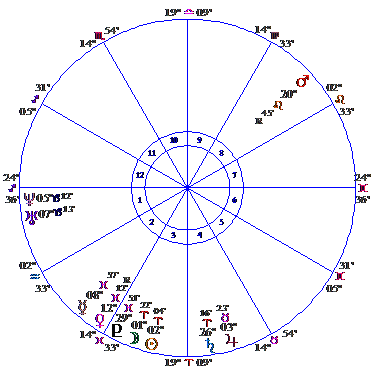
Dr J M Peebles - Preacher, writer and spiritualist

The chart-data - with no time, date or place of birth - was presented in 1001 Notable Nativities - #176. The birth data is: March 23, 1822 at 1.10am LMT; Whitingham, VT (42N47; 72W53). It has a C rating - original source not known. The (3rd house) Sun was at 2 Aries 04 - in the first decanate - and CC Zain commented: Dr J M Peebles, the great pioneer of spiritualism, had this as his spiritual polarity, having been born when the Sun was in this decanate.
James Martin Peebles was a preacher, author, journalist and medium who stood for the 'new spiritualism' that was sweeping America during the 1850s. He enthusiastically spread the Spiritualists' philosophy aided by his 'band of angels' who provided him with inspiration and spiritual guidance. He married in 1852, published more than thirty books and traveled extensively - preaching in New York, Michigan, California and the gold camps in the foothills of the Sierra Nevada Mountains. He was known as 'the spiritual pilgrim'. Dr. Peebles made his first world trip in 1865 and in 1894 was living and practicing medicine at his health-home sanitarium in San Diego, California. He completed his fifth and final world trip in June 1913. He also had a political life and was the US delegate to several international peace conferences. He died in Los Angeles on February 15, 1922 - aged 99.
Aries – first decanate Moon
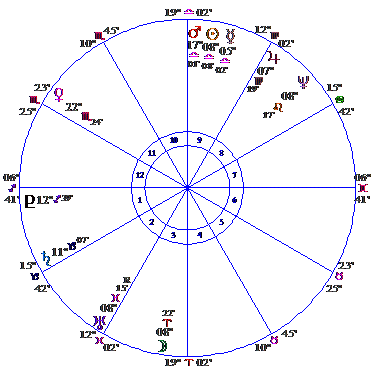
Emperor Paul of Russia

The chart-data – with no time or place of birth - was presented in 1001 Notable Nativities - #763. Alan Leo specified b. 1.10.1754 (NS). The birth data is: October 1, 1754 at 12.30pm; St Petersburg, Russia (59N55; 30E15). The (3rd house) Moon was at 8 Aries 22 – in the first decanate – and CC Zain commented: Emperor Paul of Russia had this portion of the zodiac for Mental Polarity, the Moon being there when he was born. But there's a birth time update which doesn't affect the Moon's decanate position. Arthur Blackwell gives 12.00 noon LAT – 11.49am LMT - quoting Catherine: Empress of All Russias – by V Cronin. This data has a B rating.
Popular opinion sees Paul 1 – Emperor and Autocrat of the Russias - as mad and quite delusional, but a more objective assessment reveals a man of high moral values who followed his own conscience. He suffered a lonely and strict childhood and developed an obsessive-compulsive personality with eccentric and neurotic tendencies. His tutor complained that he was 'always in a hurry' acting and speaking without reflection – Moon in Aries. As emperor Paul was morbidly suspicious of democracy. He banned private printing presses, the import of books and the wearing of modern dress including top hats, long pants and shoes with laces. He reigned from November 8, 1796 till March 23, 1801 - the night he was murdered.
Aries – first decanate Ascendant
Proclus - Neoplatonic philosopher

This is an incorrect decanate reference. The chart-data – with no time, date or place of birth - was presented in 1001 Notable Nativities - #164 and 165. Alan Leo noted: 'as given in Life of Proclus by Thomas Taylor' (#164); and 'as recalculated by HS Green and Sepharial (#165). The birth data is: February 8, 412 at 9.00am LMT; Byzantium – Constantinople - (41N02; 28E58). The ascendant is at 8 Aries – in the first decanate - and CC Zain commented: And Proclus, the great Greek Neoplatonic philosopher, who scaled the height of occult initiation and so impressed his thoughts upon the times in which he lived, was born with the Mars-decanate of Aries Ascending, this being his Physical polarity. But a birth time update changes the ascendant decanate. Arthur Blackwell - quoting 'Great Horoscopes' by O Neugebauer and HB Van Hoesen - gives February 8, 412 at 9.00am LAT (Local Apparent Time) – 7.21.03 UT; Constantinople – and this puts 13 Aries 06 on the ascendant – in the second decanate. This time has a B rating. This LAT – LMT discrepancy highlights a serious problem with older charts – although the birth time should always be rated vague and never precise. Due to the birth year – 412 - no chart can be presented.
Proclus was a Greek Neoplatonist philosopher and one of the last Classical philosophers. He started out studying rhetoric, philosophy and mathematics in Alexandria and became a successful lawyer, but then realized that his main intellectual interest was philosophy. So, seeking the best philosophical instruction available, he re-located to Athens and was taught by Plutarch, Asciepigenia and Syrianus - eventually succeeding Syrianus as the head of the Platonist Academy. He lived in Athens for the rest of his life - except for one year that he spent in exile traveling and being initiated into the various mystery cults.
Proclus had a great influence on the history of western philosophy. The majority of his works are commentaries on dialogues of Plato in which he presents his own philosophical system as a faithful interpretation of Plato. Like his fellow Neoplatonists he regarded the Platonic texts as divinely inspired. He translated Ptolemy's 'Tetrabiblos' into Latin and had a great devotion to the Goddess Athena, whom he believed guided him at key moments in his life. He died on April 17, 485 – age 73 – and was buried in a tomb near Mount Lycabettus. The crater Proclus on the Moon is named after him. Thomas Tyler (May 15, 1758 – November 1, 1835), who Alan Leo acknowledged for the birth data - 'as given in Life of Proclus'- was an English translator and Neoplatonist who wrote prolifically on the ancient Greek philosophers.
The Second Decanate of Aries - sub-ruler Sun
The astrological message
The second decanate of Aries is pictured in the sky by ERIDANUS – the River of life – flowing from the never-failing fountain of perpetual youth. Here we find the severity of Mars tempered by the magnanimity of the Sun, which has sub-rulership over this decanate. It is the Leo section of Aries. And as Leo is natural ruler of the house of love, so the water, symbol of the emotions, bespeaks the affectional influence. Only through the affections, only in the sacred precincts of love, does man quaff the coveted elixir that imparts eternal life. So those born under this section of the sky may well seek this hallowed source of power. They become rulers of men through their inherent power to sway the minds of others. They are born to lead rather than to serve, for this sub-influence of Leo lends a persistent ambition for power. The heart is somewhat joined to the head, and the more this union is cultivated the better; for the greatest lever for attainment obtainable by the natives of this decanate is a noble affection.
It is the decanate of EXALTATION
Exaltation is a heightened state of mental and emotional being. It occurs when your thoughts and feelings elevate to a high degree of emotional excellence.
The Sun – planet of distinction - is exalted in the 19th degree of Aries.
Aries – second decanate Sun
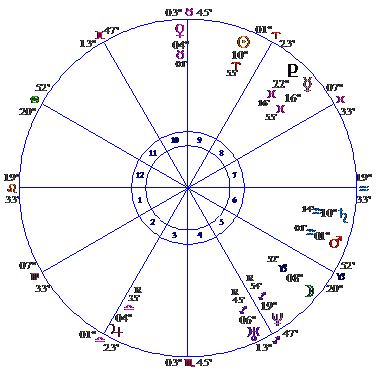
Otto Von Bismark – German Statesman

The chart-data – with no time, date or place of birth - was presented in 1001 Notable Nativities - #254 - and CC Zain presented the same chart in Course XX1 – page 130. The birth data is: April 1, 1815 at 1.30pm; Schoenhausen, Germany (52N35; 12E020). Astro Databank quotes Lyndoe – from 'a family member' – American Astrology 11/1967 – and gives it an A rating. The (9th house) Sun was at 10 Aries 55 – in the second decanate – and CC Zain commented: Bismark, who pioneered in statesmanship, had his Individuality in this portion of the zodiac, the Sun being there at his birth.
Otto Von Bismark was a German politician who believed that Germany's problems must be solved by 'blood and iron' rather than words. So on becoming Prime Minister in 1862 he embarked on a policy of aggressive expansionism. He waged wars against Denmark, Austria and France and succeeded in reuniting Germany. It's claimed that he and his chief general, Helmuth von Moltke, consulted an astrologer before embarking on the Franco-Prussian war – which they won easily. Bismark remarked: 'A statesman cannot create anything himself. He must wait and listen until he hears the steps of God sounding through events; then leap up and grasp the hem of his garment.' He died on July 30, 1898 – aged 83.
Aries – second decanate Moon
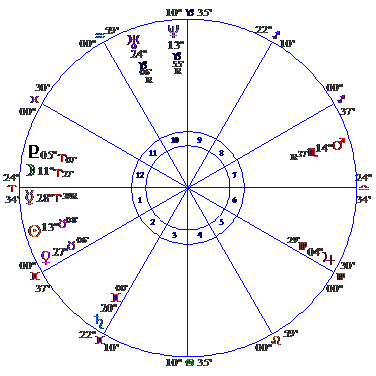
Augustus Le Plongeon – archaeological pioneer

This is an incorrect decanate reference. The chart-data – with no time, date or place of birth - was presented in 1001 Notable Nativities - #988. Alan Leo noted: 'private source'. The birth data is: May 4, 1826 at 4.00am; Jersey, Island of Jersey (49N15; 2W10). The (12th house) Moon was at 11 Aries 27 – in the second decanate – and CC Zain commented: Le Plongeon, who pioneered in archeology, deciphering Mayan inscriptions and writing a work on Atlantis, had his Mentality here, the Moon being in this decanate at his nativity. But the birth year is wrong. All Wikipedia references give1825. If the birth time is accurate the Moon was at 4 Sagittarius 34 and 24 Aries was on the ascendant – a pioneering personality - but the birth data is very dirty.
Augustus Le Plongeon was a photographer, antiquarian and amateur archaeologist. He and his wife Alice – see page 117 - studied pre-Columbian ruins and he wrote a history of ancient Maya culture – espousing a theory that Freemasonry had its roots there. He's regarded as an eccentric pioneer whose photographic records of Maya sites and inscriptions remain an important contribution to American archeology. He spent the final twenty-three years of his life in Brooklyn, New York, writing about the Mayans and Egyptians and died there in 1908 at the age of 83.
Aries – second decanate ascendant
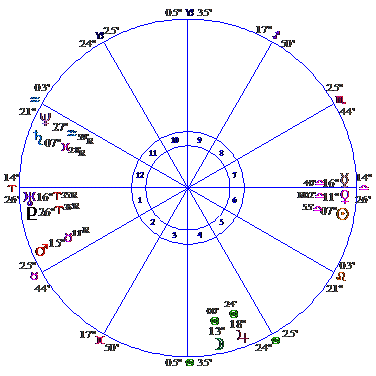
Annie Besant – Theosophical leader

This is an uncertain decanate reference. The chart-data – with no time, date or place of birth - was presented in 1001 Notable Nativities - #040. The birth data is: October 1, 1847 at 5.45pm; London, England (51N30; 00W10). The ascendant was at 14 Aries 26 – in the second decanate – and CC Zain commented: And Annie Besant, leader of the Theosophical Society and economic pioneer, had her Personality, in this decanate, it being on the ascendant when she was born. But ...'Nearly all prominent occultists' horoscopes are uncertain.'
She stated 5.20pm and Astro Databank presents a chart timed for 5.29pm – rectified by Alan Leo using the pre-natal epoch from a given 5.00 – 5.45pm. It has 4 Aries 58 on the ascendant which, on the birth date for the birth longitude, was traveling very, very fast. At 5.00pm 17 Pisces 38 was on the ascendant and 45 minutes later 14 Aries 26 was there. Rodden gives the 5.29pm birth time an A rating – even though it's rectified! If the stated birth time - 5.00–5.45pm - is correct Besant's ascendant could have been the second decanate of Pisces, the third decanate of Pisces, the first decanate of Aries or the second decanate of Aries: And it could well have been Pisces because her pioneering nature was well and truly accentuated by (the 1st house) Uranus and Pluto in Aries.
The Third Decanate of Aries – sub-ruler Jupiter
The astrological message
PERSEUS, with the wings of thought on his feet, the helmet of courage on his head, armed with the sword of righteousness, protected by the shield of beneficence, and holding the blood-dripping head of Medusa in one hand, pictures the third decanate of Aries. The sub-rulership of Jupiter diverts the aggressive energies somewhat into religious and philosophical channels. Consequently, this Sagittarius division of Aries has vast spiritual possibilities when its natives espouse some progressive line of thought, or use their restless never-failing energy in protection of the weak.
Perseus gained renown through his daring exploits in relieving oppression. And even as he severed the head of the Gorgon Medusa, which turned to stone all who gazed upon it, so the people of this decanate have the power to destroy the crystallizing influence of licentiousness, and like the David-version of the same tradition, cut off the head of the Goliath of selfish greed. They may become the valiant heroes who wage a successful fight against the sordid conditions that oppress civilized life. In the philosophical field of endeavor they find useful work in releasing Andromeda, the human soul, which all too often is found chained to the rock of materialism to be devoured by lust and envy.
It is the decanate of PROPAGANDA
Propaganda is the systematic propagation – or dissemination – of an idea, doctrine or set of principles by a person, movement or organization. The word is not bad but has acquired a sinister reputation as governments, religions and corporations are inclined to spin their deliberately misleading propaganda on an unsuspecting public.
Aries - third decanate Sun
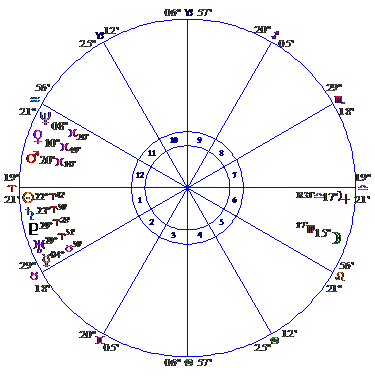
William Q Judge – Pioneer Theosophist

The chart-data – with no time, date or place of birth - was presented in 1001 Notable Nativities – #049. The birth data from him is: April 13, 1851 at 4-6.00am; Dublin, Ireland (53N20; 6W15). Alan Leo rectified the time to 5.07am. It has a C rating. The Sun was at 22 Aries 42 – in the third decanate - and CC Zain commented: Of those born with the Sun in this decanate I may mention the pioneer Theosophist, Wm Q Judge.
In New York City on November 17, 1875 at 8.00am the inaugural meeting of the Theosophical Society took place. Present at the meeting were Helena Blavatsky, Henry Steele Olcott and William Q Judge – an Irish-American editor and author. Then - in 1882 - when the organization went international Madame Blavatsky and Olcott moved its headquarters to Adyar, near Chennair, India – and Wm. Q Judge remained in New York heading the American section.
A pioneer theosophist Judge later became vice-president of the organization, edited 'The Path' and authored a number of books. When Blavatsky died in England on May 8, 1891 Annie Bessant succeeded her as head of one branch of the Society. Judge remained head of the American section till his death on March 21, 1896.
Aries - third decanate Moon
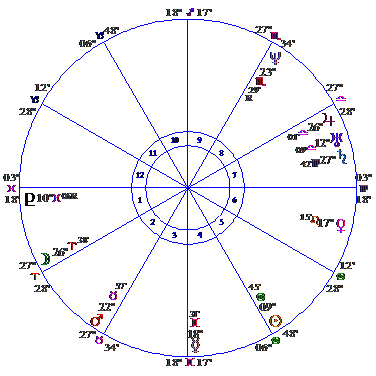
George Sand – authoress
The chart-data – with no time, date or place of birth - was presented in 1001 Notable Nativities - #756. The birth data is: July 1, 1804 at 10.30pm; Paris, France (48N52; 2E20). It's from the birth record - Luc de Marre quotes Choisnard – so it has a AA rating. The Moon was at 26 Aries 38 – in the third decanate – and CC Zain commented: As expressing the Mentality in this section of the heavens, George Sand, world's greatest authoress, and spiritualizer of common rights is a fitting example.
George Sand - pen-name of Amantine Aurore Lucie Dupin - was a prolific French author. She married Casimir Dudevant on October 9, 1822 – gave birth to Maurice on June 30, 1823 and Solange on September 13, 1828 – and then on January 4, 1831 left her husband and children and headed to Paris to write, love, wear men's clothing and smoke cigarettes. There she had love affairs with Alfred de Mussett, Frederick Chopin and others. An idealist and optimist she wrote about and supported socialist and national causes. Her first novel Indiana, published in 1832 under the pseudonym George Sand, was a plea for women's right to independence. Sand - a free spirit - was frustrated by the pretense of conventional life and in the end the glories of nature provided an emotional fulfillment that her passionate romances failed to deliver. She died of stomach cancer on June 8, 1876 – happy to have lived and loved.

Aries - third decanate ascendant
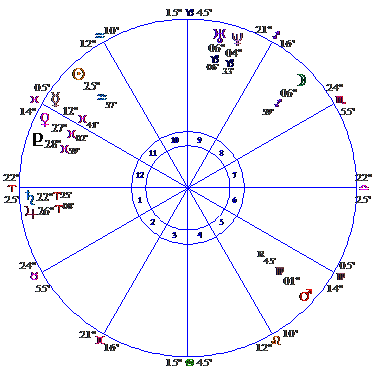
Rajendralala Mitra – antiquarian

The chart-data – with no time, date or place of birth - was presented in 1001 Notable Nativities - #276. Alan Leo noted: private source. The birth data is: February 15, 1822 at 9.30am LMT; Calcutta (Kolkata), India (22N30; 88E30). The ascendant was at 22 Aries 25 - in the third decanate – and CC Zain commented: And Dr Rajendra Lal, whose antiquarian and research work are known far beyond his native country, India, has his Personality polarized in this decanate, which was on the Ascendant at his birth. But the birth year is uncertain. Wikipedia sources state 1823 or 1824 - which I suppose makes 1822 a possibility. A chart calculated for each of these years has 22 Aries on the ascendant – so the validity of the reference depends on the accuracy of the birth time. The data has an XX rating – birth year in doubt.
Dr Rajendralala Mitra was a pioneer of the Indian Renaissance who laid the foundation for the study of Indian antiquities by Indians themselves. He was a writer, librarian, journalist, educator, editor, translator, map-maker and master of languages, being fluent in Sanskrit, Persian, Hindu, English, French, Greek and Latin. His achievements were stunning and on his death on July 26, 1891 Rabindranath Tagore, the Nobel Laureate in Bengali literature, called him 'an uncompromising Crusader'.

The Taurus Decanates
The First Decanate of Taurus – sub-ruler Venus
The astrological message
The masters of the olden times in tracing symbolic pictures in the sky, to convey to later generations their conception of the influence of the various sections of the heavens, sometimes pictured the highest attainment and sometimes pictured the greatest obstacle to progress. In LEPUS – the Hare – they symbolize the thought that timidity is the greatest bar to advancement of those born under the first decanate of Taurus. Being the first decanate of the sign naturally ruling the house of money, there is often a tendency to devote too much energy to the acquisition of wealth. And as this decanate is particularly mediumistic, those born under it easily acquire magical powers. Hence the various traditions regarding it as a place of black magic. Yet its children become adepts at white magic just as easily, if they but overcome the lust for material things. It is only when they are blinded by physical aims that the place of the soul's exaltation becomes an adverse symbol. Those born here have great natural healing power and ability to crystallize conditions to their desires by the power of the imagination to mold astral substance.
The pioneer spirit of Aries is expressed in this decanate in all its fiery fullness. Zeal and enthusiasm mark the progress of its children. The Aries-decanate of Aries, sub-ruled by the aggressive lord of war (Mars), ever seeks new worlds to conquer. And when the thoughts are permitted to soar untrammeled upward, even as the triangle points to heaven, those born under this influence become the harbingers of better things. But when the lower martial power gains sway they become the avenging agents of death and destruction.
It is the decanate of DETERMINATION
Determination is the capacity to move or flow in a fixed direction – to not waver from your chosen course of action. It displays itself as a fixed purpose and a firm and resolute intention – essential ingredients for worthwhile achievement.
The Moon – symbol of the soul – is exalted in the 3rd degree of Taurus.
Taurus - first decanate Sun
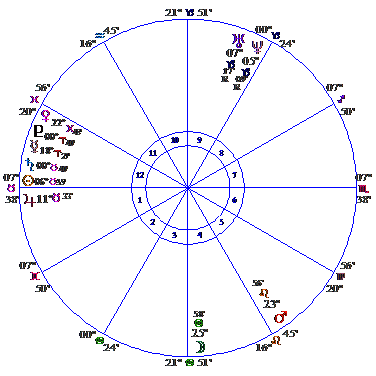
Ulysses S Grant – US president

The chart-data – with no time, date or place of birth - was presented in 1001 Notable Nativities - #237. Alan Leo noted: 'Raphael's Prophetic Messenger 1879 – page 59 – time approximate'. The birth data is: April 27, 1822 at 5.15am; Point Pleasant OH (38N53; 84W14). The (12th house) Sun was at 6 Taurus 35 – in the first decanate - and CC Zain commented: Ulysses S Grant, whose fixity of purpose was his most remarkable trait, was born with his Individuality polarized in this decanate. But several birth times – 'about 6.00am' from Grant's father and 5.47.49am from Astro Databank - don't affect the Sun's decanate position.
Hiram Ulysses Simpson Grant was general in chief of the Union troops in the American Civil War and the country's 18th president. The son of an an Ohio farmer his initial attempt at a business career failed. Then at the outbreak of the Civil War he received a commission on the Mississippi front – was put in charge of the Union forces on April 4, 1864 – and accepted Robert E Lee's surrender on April 9, 1865. Elected president in 1868 – and 1872 – Grant carried out a liberal reconstruction in the south – reformed the civil service – ratified the Treaty of Washington with the UK in 1871– but failed to suppress extensive political corruption within his own party and cabinet. He died on June 23, 1885 – aged 63.
Taurus – first decanate Moon
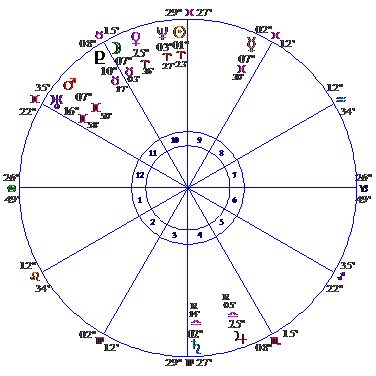
George Robert Stowe Mead – author and editor

The chart-data – with no time, date or place of birth - was presented in 1001 Notable Nativities - #078. The birth data is: March 22, 1863 at 12 Noon; Warwickshire (52N13; 1W37). It has a C – for caution – rating. The (10th house) Moon was at 7 Taurus 03 – in the first decanate - and CC Zain commented: G R S Mead who edited The Theosophical Review and did an immense amount of laborious work to enlighten students, had his Mentality in this decanate, it being the place of the Moon in his chart.
George Robert Stowe Mead was an author, editor and influential member of the Theosophical Society. He was educated at St John's College, Cambridge – studied mathematics and the Classics - completed his bachelor of arts degree in 1884 – and then joined the Theosophical Society. In 1889 he abandoned a teaching career to become Helena Blavatsky's private secretary and joint-secretary of the organization's Esoteric Section. As an intellectual contributor to the Society he was a prolific writer and editor of the Theosophical Review. Then in February 1909, after 25 years, he and 700 other members resigned from the Theosophical Society when Annie Bessant reinstated Charles Leadbeater: And in March 1909 he founded the Quest Society and focused his effort on publishing The Quest – A Quarterly Review. Mead died in 1933 – aged 70.
Taurus – first decanate Ascendant
Jerome Cardan – mathematician and astrologer

The chart-data – with no time or place of birth - was presented in 1001 Notable Nativities - #514. Alan Leo noted: b 24.9.1501. The birth data is: October 4, 1501 at 6.30pm LMT; Pavia, Italy (45N10; 9E10). The ascendant was at 6 Taurus – in the first decanate – and CC Zain commented: And Jerome Cardan, who became famous as a mathematician and astrologer, had this decanate rising at his birth. Astro-Databank quotes Ciralmo Cardona: Book of My Life (Jean Stoner) for 6.40pm LAT – 6.29pm LMT – and gives it a B rating. Due to the birth year – 1501 - no chart can be presented.
The chart data is: The ascendant was in 6 Taurus 21. The Sun was in the 6th house at 10 Libra 41 – in the second decanate - trine Mars and square Neptune. The Moon was in the 11th house at 10 Pisces 40 – in the second decanate - square Mars: And Mercury was in the 6th house at 26 Libra 26 – in the third decanate – conjunction Venus and sesquisquare Mars. Mars and Saturn were in the 2nd house; Pluto was in the 7th; Neptune was in the 9th; Uranus was in the 11th; and Jupiter was in the 12th.
Gerolamo Cardano was an Italian Renaissance mathematician, physician, astrologer and gambler. In 1520 – at age 19 – he entered the University of Pavia to study medicine but his confrontational style, eccentric personality and illegitimate birth did not win friends and influence people and five years later - in 1525 - he was a struggling small town doctor. So to solve his money problems he turned to gambling. In 1534 Cardan wrote his first book on astrology – a pamphlet filled with short and long term predictions. Many more followed – including astronomical tables and data collections – and in 1554 the horoscope of Jesus. In 1535 he received an appointment to give public lectures on mathematics and in his book Ars Magna (1545) he published the solutions to the cubic and quartic equations. He was also the first to describe typhoid fever and invented the combination lock and universal joint.
By 1551 Cardan was a well respected physician, but his children were a bitter disappoint-ment to him. In 1569 his eldest son was arrested, tried, convicted and executed for murdering his wife and his younger son was a gambler and thief. In 1570 Cardan was charged with heresy – that horoscope of Jesus was the problem - and spent several months in prison. He then moved to Rome - in 1571 - and received a lifetime annuity from Pope Gregory X11. There he finished his autobiography and died on September 21, 1576 – aged 75: And legend has it that he predicted the date of his own death.
The Second Decanate of Taurus – sub-ruler Mercury
The astrological message
In the second decanate of Taurus the fixity of purpose is given the analytical trend through the sub-influence being that of Virgo. Therefore, some condition in the environment is attacked and made the center upon which the physical and mental forces are focused. The result is a conflict. And this conflict may be to attain fame through literary or artistic production, to attain financial supremacy through business methods, or to rise in the field of science or politics. Thus it brings a combat for supremacy.
The thought is pictured by ORION, the most successful of all hunters, who attacked and slew the mighty bull. The bull represents material pleasures and physical limitations over which it is possible for those born under this decanate to rise supreme. They have at their command an unusual supply of electromagnetism, and can mentally attack with a force as great as the huge club wielded by the mighty arm of Orion. Thus they cause obstacles to crumble.
It is the decanate of STRUGGLE
Struggle is the result of conflict and adversity. It displays itself as strenuous effort to overcome or break free from adverse conditions - domination by others and/or social or self-inflicted oppression.
Taurus - second decanate Sun
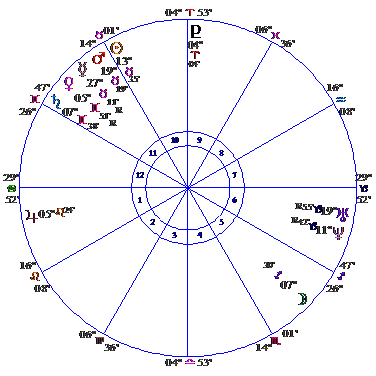
Thomas H Huxley – scientist

The chart-data – with no date or place of birth was presented in 1001 Notable Nativities - #051. Alan Leo noted: 'According to Life and Letters of T.H.H. p.3 time is given as 9.30am by Family Bible, while the Autobiography gives it as 'about 8 am.' This map is calculated for 8.45am.' The (11th house) Sun was at 13 Taurus 35 – in the second decanate - and CC Zain commented: Thomas H Huxley, whose work as a scientist was so painstaking and brought him so much opposition, was born with the Sun in this decanate. The chart presented is for May 4, 1825 at 9.30am; Ealing, England (51N31; 00W20). It has a AA rating and 147 harmodynes!
Thomas Henry Huxley was a British scientist and biologist. From 1846 to 1850 he was the assistant ship's surgeon on HMAS Rattlesnake and in 1859, after the publication of Darwin's Origin of the Species, became the chief advocate of evolutionary theory – and 'Darwin's Bull-Taurus-Dog'. In 1860 his famous debate with Samuel Wilberforce was a key moment in the acceptance of evolution. He's considered the founder of scientific humanism and in 1869 coined the word 'agnostic' to describe his own religious attitude. His works include, 'Zoological Evidence as to Man's Place in Nature', 'Science and Culture' and 'Evolution and Ethics'. Huxley died on June 29, 1895 – aged 70.
Taurus – second decanate Moon
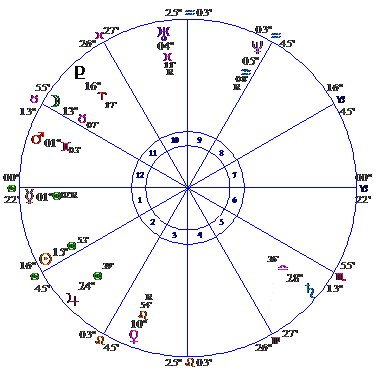
Joseph Chamberlain – British politician

The chart-details – with no time, date or place - were presented in 1001 Notable Nativities - #107. The birth data – from a personal friend - is: July 8, 1836 at 2.45am; London, England (51N30; 00W10). It has an A rating. The (11th house) Moon was at 13 Taurus 07 – in the second decanate – and CC Zain commented: The Rt. Hon. Joseph Chamberlain, whose political life was spent struggling to gain greater freedom for the people, had his Mentality here.
Joseph Chamberlain was a British politician. He started out in business – manufacturing screws – and by 1874 had made sufficient wealth to turn his talents to politics – a self-funded politician. He was elected mayor of Birmingham three times and initiated many radical reforms. In 1876 he was elected to parliament as the member for Birmingham and joined the republican group – the extreme left-wing of the Liberal Party. In 1880 he entered Gladstone's cabinet as president of the Board of Trade. Then in 1900, as colonial secretary, he negotiated the Commonwealth of Australia Constitution Bill with representatives from Australia. A reformist - with an eccentric streak - he was one of the most colorful figures in British politics. On June 15, 1906 he was incapacitated by a stroke and was an invalid for the rest of his life. He died in London on July 2, 1914 – six days shy of his 78th birthday.
Taurus – second decanate Ascendant
George Washington – US President

This is an incorrect decanate reference. The chart-data - with no time - was presented in More Notable Nativities. Alan Leo noted: Born in Pope's Creek later called Wakefield in Westmoreland Country (maps on file) 76W56; 37N13 on February 11, 1731/32 OS. This converts to February 22, 1732 and the time recorded in the Bible entry was 'about 10.00am'. Astro-Databank gives it a AA rating. The ascendant was at 17 Taurus 40 – in the second decanate - and CC Zain commented: And another who strove with armies, George Washington, founder of the U S of America, was born with his Personality in this section of Taurus. But there's a birth time correction which affects the ascending degree's decanate position and a birth place correction.
In 6/2002 Astro-Databank quotes Wayne Turner who refers to George Washington, A biography: Young Washington by Douglas Southall Freeman - published 1949 - where the Bible entry is given: 'George Washington son to Augustine and Mary his wife was born on the 11th day of February 1731/32 about 10 in the morning.' Turner explains that a straight conversion to LMT from LAT gives about 10:14 am': And the birth place is not Wakefield, VA. Washington's official website gives Bridges Creek, Virginia (76W56; 38N11).
This means that the most accurate data for George Washington is: February 22, 1732 at (about) 10.14am LMT: Bridges Creek, VA (76W56; 38N11). The ascendant was at 22 Taurus 53 – in the third decanate. It moved there at 9.51am LAT – nine minutes before the recorded time - so it all depends on whether he was born before or after that time. Due to the birth year – 1732 - no chart can be presented.
George Washington was the commander of the American forces during the American Revolutionary War and the first president of the USA. In 1775 the Continental Congress appointed him commander-in-chief of the American revolutionary forces and six years later - in 1781 - he accepted the surrender of General Cornwallis at Yorktown. Then in 1789 he was inaugurated as the first US President – and scholars today consistently rank him as one of the greatest. Washington, who is often referred to as the father of his country, died at his Mount Vernon estate on December 14, 1799 – aged 67.
The Third Decanate of Taurus – sub-ruler Saturn
The astrological message
The third decanate of Taurus shows the reflective influence of Saturn, its sub-ruler. And even as the key-phrase of Capricorn is 'I Use', so those born under this decanate have the the ability to use physical means to attain spiritual ends. The decanate is pictured in the sky by AURIGA, the charioteer, who with one hand guides the chariot of his soul and with the other protects and ministers unto the weak and needy. Auriga pictures the one who has triumphed over his environment and physical limitations and attained adeptship. Those born under this decanate have an aptitude for true spiritual attainment. And while the progress usually is not swift; yet, once undertaken, it becomes a sure and steady climb with seldom setbacks. What they receive, however, largely depends upon the use they make of the power they already possess in ministering unto the ills of others.
It is the decanate of MASTERSHIP
Mastership is the condition of being a master or teacher. Its the mastery of a skill, subject or knowledge and a master has exceptional knowledge or authority.
Taurus – third decanate Sun
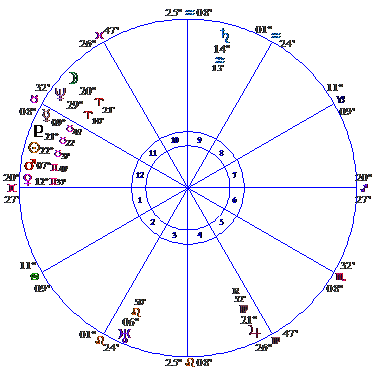
Elizabeth D Benjamine – co-founder of the Church of Light

This chart is presented on page 2 of Brotherhood of Light Course XX. The birth data is: May 13, 1874 at 6.25am; Alturas. California (41N30; 120W32). It's from her and has a AA rating. The (12th house) Sun was at 22 Taurus 37 – in the third decanate - and CC Zain commented: Elizabeth D. Benjamine who labored so successfully as a teacher of Brotherhood of Light classes for 23 years, and was one of the three founders of The Church of Light was born with her individuality in this decanate.
Elizabeth Dorris – the oldest daughter of a large pioneer family – first came to Los Angeles in 1892: And there, in the early 1900's, she had a home built in the northeast section of town. In December 1918 she attended a Brotherhood of Light class being conducted by Elbert Benjamine: And in the spring of 1919 – on May 27 - she married her teacher. From then on she was a tireless worker for the Brotherhood of Light – teaching, touring, answering the 'questions most often asked at Headquarters' and providing her husband with the support that ensured he would complete the mighty work he had promised to do. On November 2, 1932 when the Church of Light was incorporated she took on the role of secretary-treasurer (Taurus). Overflowing with hope and faith - those who knew her didn't need the astrodynes to know that Jupiter was her dominant planet. Her physical demise came on March 29, 1942 – aged 67.
Taurus – third decanate Moon
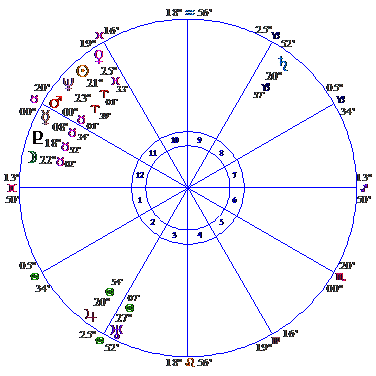
Fred H Skinner – co-Founder of the Church of Light

This chart is presented on page 67 of Brotherhood of Light Course 1. The birth data is: April 10, 1872 at 8.09am LMT; Chariton, Iowa (41N; 93W given in Course 1 but 41N01; 93W19 is more precise.) It's from him and has a AA rating. The (12th house) Moon was at 22 Taurus 01 – in the third decanate – and CC Zain commented: Fred H Skinner who labored so successfully as a teacher of Brotherhood of Light classes for 21 years, and was one of the three founders of The Church of Light was born with his Mentality in this section of the heavens.
Fred H Skinner was a professional photographer, astrology teacher and the Church of Light's first Vice-President. In November 1909 he began studying astrology and in 1917, when he joined the Brotherhood of Light, he started teaching – and his mild-manner and genial good-humor ensured that his classes in Los Angeles were always popular and well attended. On November 2, 1932 when the Church of Light was incorporated he became the organization's first vice-president. With a dominant Saturn and Sun he was a pillar of system, order and organization – qualities he employed in his teaching work and the development of study questionnaires for use by Church of Light teachers. Elbert Benjamine called him 'The Dean of Astrology'. His physical demise came on February 7, 1940 – aged 67.
Taurus – third decanate Ascendant
Emanuel Kant - transcendental philosopher

This is an incorrect decanate reference. The chart data – with no time of place – was presented in 1001 Notable Nativities #972. Alan Leo noted: b. April 22, 1724. And presuming Old Style did a new style conversion. The birth data is: May 3, 1724 at 5.00am: Konigsburg, Germany (20E31; 54N42). The ascendant was at 29 Taurus 30 – in the third decanate – and CC Zain commented: And Immanuel Kant, whose works on transcendental philosophy have not been surpassed, was born with his Personality here. But the chart's date and time were both wrong.
Astro Databank explains that Alan Leo's conversion to New Style didn't apply as Germany was already on the Gregorian calendar by 1700 – and gives 3.00am as the birth time quoting Dr Mortzfield, Fragments Aus Kant's Leben, 1802. The birth data is: April 22, 1724 at 3.00am LMT: Konigsburg, Germany (20E31; 54N42). It has a B rating. The Sun was in 2 Taurus 03 – in the decanate of Determination; the Moon was in 13 Aries 13 – in the decanate of Exaltation; and the ascendant was in 21 Aquarius 55 – in the decanate of Repression. Due to the birth year – 1724 - no chart can be presented.
Emanuel Kant was a German writer, teacher and philosopher who introduced a new perspective in philosophy which has continued to influence philosophy through to the 21st century. Kant believed that knowledge is not the aggregate of sense impressions but is dependent upon on the conceptual apparatus of the human understanding, which is not derived from experience. His works included Kant's Critique of Pure Reason (1781) – which inaugurated a revolution in philosophy by turning attention to the mind's role in constructing our knowledge of the objective world - and Critique of Practical Reason (1788). He also argued that God's existence could not be proved theoretically. The foremost thinker of the Enlightenment he's considered one of the greatest philosophers of all time.
The fourth of eleven children Kant was raised in a Pietist household that stressed intense religious devotion and a literal interpretation of the Bible – so he received a stern education that focused on religious instruction rather than mathematics and science. In 1740 he enrolled at the University of Konigsberg and in 1755 began teaching metaphysics at the place he was taught. It's said that Kant lived such a strict and predictable life (Taurus), that neighbors would set their clocks by his daily walks – and in his entire life he never traveled more than a hundred miles from Königsberg – that's stability for you. Kant – who was barely five feet tall - suffered poor health throughout his life. He died on February 12, 1784 – aged 59.

The Gemini Decanates
The First Decanate of Gemini – sub-ruler Mercury
The astrological message
By means of a bear – URSA MINOR – whose restless activity and power suggest that of the mind, the ancients depicted the Mercury-decanate of Gemini. And because the unconscious mind is not so obvious as the objective mind, this bear is small. So too it travels about the sky backward. Thus must one direct his attention contrary to the trend of objective life to hear ''the voice of the silence'.
Perhaps unconsciously, yet none the less effectively, those born in this Gemini third of Gemini tend to rely upon intuition. Their natural field of endeavor is the mental plane. They see, not merely the details of a problem, but view it completely, perceiving the proper relations of each part to the whole. And if they are not carried away by the restless desire to undertake too many things, they may become intellectual giants. For they assimilate all they contact and their deductions rise spontaneously from the soul.
It is the decanate of INTUITION
Intuition is an unconscious mental process that perceives facts and apprehends information without resorting to the laborious process of conscious reasoning. It's an instant, immediate insight without the hard mental work.
Uranus – planet of originality - is exalted in the 7th degree of Gemini.
Gemini - first decanate Sun
Alighieri Dante – poet

This is probably an incorrect decanate reference. The chart-data - with no time, date or place of birth - was presented in 1001 Notable Nativities - #844. Alan Leo noted: as calculated by Sepharial (Uranus and Neptune recalculated) - time approximate'. The birth data is: May 14, 1265 OS – May 21 NS – at 7.00am LMT; Florence, Italy (43N46; 11E15). The Sun was at 1 Gemini - in the first decanate – and CC Zain commented: Alighieri Dante, who intuitively grasped so many cosmic truths and portrayed them in his 'Inferno', was born when the Sun passed through this decanate. But the birth date, which affects the Sun's decanate position, is unknown. It has an XX rating.
Astro Databank presents a chart for May 30, 1265 OS - June 6, 1265 NS – at 4.33am LMT, which puts the Sun at 15 Gemini – in the second decanate. But the source notes provide several other dates and American Encyclopeadia suggests 'late May or early June'. The fact is that Dante's exact date of birth is not known – and never will be. It's believed to be between the middle of May and the middle of June. Due to the birth year – 1265? - no chart can be presented.
Durante degil Alighieri – Dante - was an Italian poet of the Middle Ages. His central work – La Divina Commedia (The Divine Comedy) – is often considered the greatest literary work composed in the Italian language and a masterpiece of world literature – and it's very astrological. It's an epic account - in three parts - of Dante's personal journey through Hell, Purgatory and Paradise, during which he is guided by the poet Virgil. He begins his wanderings when the Sun is in Aries – the beginning of the zodiac – and in the Paradiso section explains his heavenly birth and earthly existence - 'As I revolved with the eternal twins. I saw revealed from hills to river outlets, the threshing-floor that makes us so ferocious'. Dante attributed his poetic gift to the constellation Gemini – and his beliefe in astrology was strong – 'were it not for the influence of the stars children would be exactly like their parents.'
When he was nine Dante experinced young-love with Beatrice Portinari and when he was twelve he was promised in marriage to Gemma di Manetto Donati. It's believed they had four children. In 1289 he fought in the battle of Campaldino and from 1295 took an active part in Florentine politics. In 1302 he was convicted of misapplication of public money – refused to pay the fine - was condemned to a life of perputual exile – and then wrote his Divine Comedy. He died on September 14, 1321 (OS) – aged about 56.
Gemini – first decanate Moon
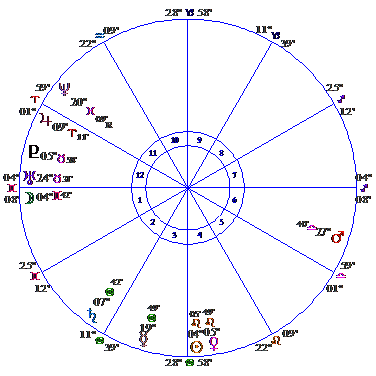
George Bernard Shaw – playwright and social commentator

This is an incorrect decanate reference. The chart-data birth data – with no time, date or place of birth – was presented in 1001 Notable Nativities - #999. Alan Leo noted: 'speculative chart' time not known. The birth data is: July 26, 1856 at 11.45pm LMT: Dublin, Ireland (53N20; 6W15). The (1st house) Moon was at 4 Gemini 42 – in the first decanate – and CC Zain commented: George Bernard Shaw, who comprehends in their entirety so many of the present day world problems and presents them in his lucid literary style, was born when the Moon was here. But in the Fourth edition of Notable Nativities Leo provided a birth time correction - 'about 12.40am' – from Shaw's older sister. CC Zain then presented a chart timed for 12.25am LMT on page 100 of Delineating the Horoscope. The (12th house) Moon was at 21 Taurus 22 – in the third decanate - which contradicted the earlier decanate reference. Then in Mountain Astrologer 10/1994 Mary K Greer gave 12.55am quoting Shaw's mistress, Florence Farr who cites the Family Bible. This data gets an A rating.
George Bernard Shaw was an Irish playwright and social critic who used witty dialogue and playful irony in his all out attack on everything from war to religion. He wrote more than sixty plays, was awarded the Nobel Prize for Literature (1925), and an Oscar for his work on the film Pygmalion (1938). He died on November 2, 1950 – aged 94.
Gemini – first decanate Ascendant
Richard Wagner – composer

This is an uncertain decanate reference. The chart-data – with no date or place of birth – was presented in 1001 Notable Nativities - #888. Alan Leo noted: 'at sunrise' (Life by Ashton Ellis). The birth data is: May 22. 1813 at 4.08am LMT; Leipzig, Germany (51N19; 12E20). The ascendant was at 1 Gemini 12 – in the first decanate - and CC Zain commented: And Richard Wagner, the composer, who saw and felt the great truths of nature and expressed them so adequately in music, was born when this decanate was on the Ascendant. But the 'sunrise' reference requires a lot of caution – it could simply refer to any time in close proximity to 'the hour when roosters sang!' The first decanate of Gemini was rising from 4.05am to 4.35am and if the birth occurred before 4.05am then the third decanate of Taurus would have been on the ascendant – and if it occurred after 4.35am then the second decanate of Gemini would have been there. Astro-Databank has 4.11am LMT and gives it a C rating.
Richard Wagner was a fascinating and controversial musical genius who revolutionized the 19th century's perception of opera by envisaging it as a wholly new art-form that unified music, poetry and scenery: But behind the beautiful music was a tragic and sordid personal life full of financial, moral and marital difficulties. He died on February 13, 1883 – aged 69.
The Second Decanate of Gemini – sub-ruler Venus
The astrological message
The second decanate of Gemini is pictured in the sky by a large dog – CANIS MAJOR. This noble looking beast is the emblem of faithfulness, and through its adoration for its master also represents the worshipping and serving of Deity – for to the dog his master is God. Therefore, we find those born under the second decanate of Gemini often possess a singular and admirable faithfulness, either to their human companions or to some high ideal. They have much veneration and seek to obey the voice of their conscience implicitly.
This Venus decanate also relates to twin-souls. So there is a greater likelihood of those born here finding a congenial mate than is the case with most. And to make the best of life they must espouse some principle or progressive cause, and work to get it generally acknowledged and accepted.
It is the decanate of FIDELITY
Fidelity is faithfulness or loyalty to a promise or duty. It displays itself as unswerving allegiance to a cause and conjugal faithfulness in marriage.
Gemini – second decanate Sun
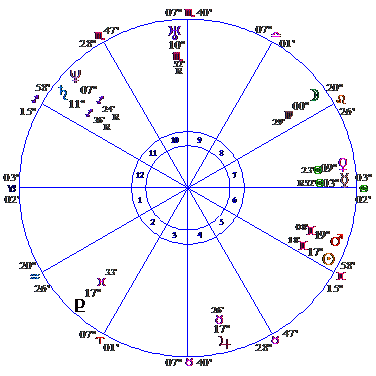
Robert Schumann – music critic and composer

The chart-data – with no date or place of birth was presented in 1001 Notable Nativities - #051. Alan Leo noted: 'According to Life and Letters of T.H.H. p.3 time is given as 9.30am by Family Bible, while the Autobiography gives it as 'about 8 am.' This map is calculated for 8.45am.' The (11th house) Sun was at 13 Taurus 35 – in the second decanate - and CC Zain commented: Thomas H Huxley, whose work as a scientist was so painstaking and brought him so much opposition, was born with the Sun in this decanate. The chart presented is for May 4, 1825 at 9.30am; Ealing, England (51N31; 00W20). It has a AA rating and 147 harmodynes!
Thomas Henry Huxley was a British scientist and biologist. From 1846 to 1850 he was the assistant ship's surgeon on HMAS Rattlesnake and in 1859, after the publication of Darwin's Origin of the Species, became the chief advocate of evolutionary theory – and 'Darwin's Bull-Taurus-Dog'. In 1860 his famous debate with Samuel Wilberforce was a key moment in the acceptance of evolution. He's considered the founder of scientific humanism and in 1869 coined the word 'agnostic' to describe his own religious attitude. His works include, 'Zoological Evidence as to Man's Place in Nature', 'Science and Culture' and 'Evolution and Ethics'. Huxley died on June 29, 1895 – aged 70.
Gemini – second decanate Moon
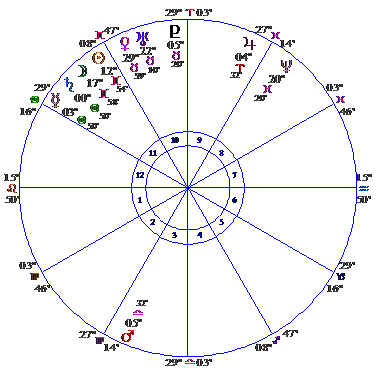
Florence Cook – medium

The chart-data – with no time, date or place of birth - was presented in 1001 Notable Nativities - #841. Alan Leo noted – time approximate. The birth data is: June 3, 1856 at 9.00am; London, England (51N31; 00W06). It has a C rating. The (11th house) Moon was at 17 Gemini 58 – in the second decanate - and CC Zain commented: Miss Florence Cook, whose faithfulness to the cause of spiritualism led her to become the medium through whom 'Katie King' manifested to Sir Wm Crooks, had her Mentality pictured by this section of the sky.
Mediums and spirits don't make the news much these days but it was a different story back in the 1860s. This was the heyday of Spiritualism and Florence Cook was one of the movement's most famous mediums and Katie King one of its most famous spirits. So in 1871 the influential scientist, Sir William Crookes, decided to scientifically investigate the Florence-Katie King phenomena. His report, published in 1874, asserted that Florence did produce genuine preternatural phenomena and this caused an uproar and nearly ruined his career. In 1875 Katie departed so Florence got married and went into partial retirement. Then, in 1880, she was back with another spirit – Marie - but things didn't go well and she soon did a quick fade to dom-estic obscurity. She held her last seance in 1899 and passed to the next life in 1904 – aged 48.
Gemini – second decanate Ascendant
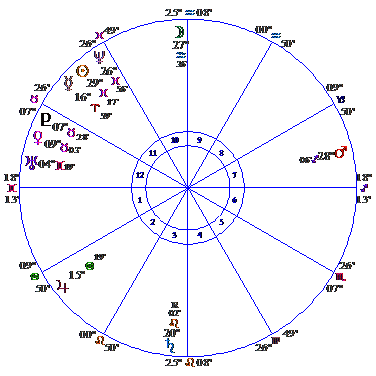
William Jennings Bryan – US politician

This is an incorrect decanate reference and a no-where chart. It's not in a 1001 Notable Nativities and it's not in the Brotherhood of Light lessons – even though it was used in Delineating the Horoscope – Course 10-1 - as an example chart. The birth data is: March 19, 1860 at 10.00am LMT; Salem IL (38N37; 88W56). The ascendant was at 18 Gemini 13 – in the second decanate – and CC Zain commented: And Wm. Jennings Bryan, whose faithfulness to his political and religious convictions is the best known feature of his career, was born with his personality in this part of Gemini. But Bryan's biographer quoting the attending physician stated: 'a little after nine in the morning, about 9.15am' – which puts 6 Gemini 14 on the ascendant – in the first decanate. This data has a B rating.
William Jennings Bryan was an American newspaper editor, politician and lawyer – the leader of the Democratic Party – and its unsuccessful Presidential candidate on three separate occasions – 1896, 1900 and 1908. He was also a noted orator. In 1925 at the famous Scopes monkey trial held in Dayton, Tennessee – when John T Scopes a science teacher was accused of teaching, contrary to state law, Charles Darwin's theory of evolution – Bryan was the successful prosecuting attorney. Bryan died in Dayton shortly after the trial - on July 26, 1925 – aged 65.
The Third Decanate of Gemini – sub-rulers Saturn and Uranus
The astrological message
A huge bear – URSA MAJOR - traveling about the pole-star in a forward direction depicts among the constellations the Aquarius-decanate of Gemini. The bear, whose restless activity and omnivorous nature is typical of mentality, in this case moves as does the objective mind, in the direction of events. And it is huge in size to indicate the immense power that may be exercised by thought.
This is the scientific decanate of the sign of thought. Those born under it are capable of accomplishing great things through the exercise of their minds. They tend chiefly to rely upon reason, therefore, should not only train their minds, which is readily accomplished, but should cultivate idealism and religion. Otherwise their efforts crystallize and become self-centered.
It is the decanate of REASON
Reason is a conscious mental process that employs logic and hard evidence to solve problems and draw conclusions. It relies on the facts - as presented – and dismisses emotional bias and sentiment as unreliable distortions that easily blur the reasoning process resulting in wrong conclusions and decisions.
Gemini – third decanate Sun
Nero – emperor of Rome

This is an incorrect decanate reference. The chart-data – with no time or place – was presented in 1001 Notable Nativities - #439. Alan Leo noted: Jerome Cardin - b. 14.6.37 – and When and Where of Famous Men and Women – b. 15.12.37 (W). The birth data is: June 14, AD 37 at sunrise; near Antium (now Anzio) (41N27; 12E37). Uranus and Neptune are missing from the chart. The Sun was at 21 Gemini - in the third decanate - and CC Zain commented: Nero, the Roman Emperor, who had wonderful talent, but could burn Rome for his own amusement so self-centered had he become, had the Sun in this section of the heavens at his birth. But he didn't.
Nero's birth data is: December 15 AD 37 at sunrise: (41N27; 12E37). It has a B rating. The Sun - at 22 Sagittarius 22 – in the third decanate - was conjunction Mars and Pluto - and Saturn, in the ninth house, was square this triple conjunction. It was a very destructive astrological profile which prompted Balbillus, the court astrologer to Claudius, to warn Nero's mother, Agrippa, that her son would one day murder her – which he did. He also murdered both his wives – Octavia and Poppaea Sabina.
Nero Claudius Caesar Augustus Germanicus - the fifth and last Roman emperor of the Julio-Claudian dynasty - assumed power in AD 54 at the age of sixteen - and in the first five years of his reign applied himself diligently to his judicial duties: But in AD 59 – at the age of twenty-one - things went very, very bad. That's when he poisoned a rival, had his mother beaten to death and set out on a life of sport (Sagittarius), music, orgies and murderous mayhem. He staffed the government with cronies, spent the public purse extravagantly and rolled up huge deficits.
In AD 64 in a spectacular act of destruction, he burned Rome to the ground. The fire raged for six days – thousands perished – and the property loss was enormous. Then – in a spectacular act of denial – he blamed the fire on the Christians and became their first Antichrist. Finally, on June 9 AD 68, after being ousted in a military coup Nero, with the help of his secretary, cut his own throat. He was 31 years old.
Later, in the 2nd Century AD, the astrologer, Vettius Valens, who ran an astrological school in Alexandria assembled a data-collection of one hundred and twenty-three horoscopes – including case histories. The collection included Nero – and his case history notes must have made very interesting reading. Valens described Mars as tyrannical, fiery, harsh, murderous, destructive and utterly bad!
Gemini – third decanate Moon
Nicholas Culpepper – physician

The chart-data – with no time, date or place of birth - was presented in 1001 Notable Nativities - #14. Alan Leo noted: John Gadbury. The birth data is: October 28, 1616 at 11.50am; Ockley, England (51N09; 00W22). The Moon was at 21 Gemini – in the third decanate – and CC Zain commented: Nicholas Culpepper, author of 'Herbal' and by his friends said to be the the best physician that ever lived had his Moon here. But there's a time update that doesn't affect the Moon's decanate position. Astro Databank quotes Modern Astrology 2/1892 for 12.12pm - from Sibly – and gives it an A rating.
Nicholas Culpepper was an English botanist, herbalist, physician and astrologer who – with the Sun opposition Saturn in his birthchart - experienced his fair share of misfortune and tragedy. His father died thirteen days before he was born and he was raised by the reverend William Attersole who recognized his natural intellectual abilities and, at the age of ten, he began to study astrology. In 1835 – aged eighteen - he entered Cambridge to study humanities. He was a brilliant scholar but - with Mercury square Mars in his birthchart - hot-headed and reckless. Tragedy then hit when his lover's coach was struck by lightning, on the night of their elopement, killing her instantly – and he was grief stricken for months: And when – at the age of twenty-three - his mother died of breast cancer he was alone, depressed, poverty stricken and emotionally wiped out.
In 1640 he decided to return to London where he met and married the fifteen year-old daughter of a wealthy merchant, which allowed him to set up a pharmacy – medical practice - in Spitalfields. He sometimes saw as many as forty patients in a morning and, by getting his herbal supplies from the nearby countryside, was able to provide his services for free. Then in August 1642 he joined Cromwell's forces in the English Civil war, as a battlefield surgeon, and on October 23, 1642 sustained a torso injury – the Sun, Mercury and Venus were in Scorpio - from which he never fully recovered. Between 1644 and 1649 he wrote, researched and published Pharacopoeia - but his self-help medical guides for the poor were bitterly criticized by the medical establishment.
Culpepper, who devoted himself to using herbals to treat the illness of his patients, is best remembered for Culpepper's Herbal – a compendium of natural healing and a rich store of pharmaceutical and herbal knowledge. He died of tuberculosis on January 10, 1654 – aged 38. It's claimed that the balance of his manuscripts were most likely destroyed in the Great Fire of London in 1666 – and with Mercury square Mars in his birthchart they probably were.
Gemini – third decanate Ascendant
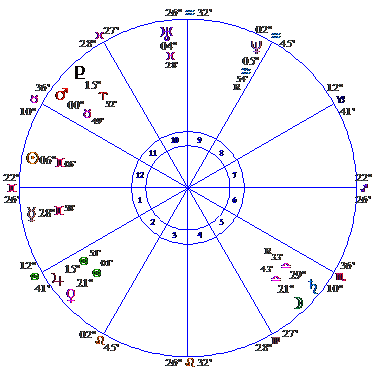
Jay Gould – businessman and financier

This is a doubtful decanate reference. The chart-data – with no time, date or place of birth - was presented in 1001 Notable Nativities - #259. Alan Leo noted – time approximate. The birth data is: May 27, 1836 at 5.35am LMT; Roxbury, New York (42N17; 74W33). Rodden quotes Sabian Symbols #400 for the same data and gives it a C rating. The ascendant was at 22 Gemini 26 - in the third decanate - and CC Zain commented: And Jay Gould, whose manipulation of railroad securities wrecked so many others and made for himself such a huge fortune, had his personality located in this last decanate of Gemini. But as this decanate was ascending between 5.26 and 6.07am its validity as a reference hinges on an unsourced, approximate birth time.
Jay Gould was an American financier, speculator and railroad developer whose reputation as the most unscrupulous American businessmen – or robber baron - of the 19th Century stands firm even though recent biographers have tried to save it – a not easy task with the financial planet – Jupiter - in his birthchart - forming an exact square aspect to Pluto – the manipulator – and the Moon conjunct Saturn in the third decanate of Libra. Gould had no scruples about using stock manipulation and insider trading to build capital and to execute and prevent hostile takeovers. He died of tuberculosis on December 2, 1892 – aged 56.

The Cancer Decanates
The First Decanate of Cancer – sub-ruler Moon
The astrological message
The first decanate of Cancer is depicted in the sky by a little yapping cur – CANIS MINOR – a mongrel without courage or loyalty. By it the ancient masters sought to convey the thought that those born under this section of the sky are particularly susceptible to domestic intrigue. They have strong emotions and may easily be carried away by them. Consequently, they should put forth a persistent effort to cultivate the qualities of faithfulness and poise.
Through the activity of the emotional nature, and their sensitiveness to all that affects life, they are often capable of remarkable poetic and dramatic expression. Unknown to themselves they are the mediums through which entities on the inner planes manifest. And because they are such perfect mediums they sometimes betray the trust placed in them, for they tend to yield to the temporarily strongest influence. They should learn to be positive and firm.
It is the decanate of MOODS
Moods are states of feeling that influence what you do. Their intensity and duration time varies greatly. Pleasant 'feel-good' moods are a mental comfort – unpleasant 'feel-bad' moods are a psychological discomfort. You're in the mood – for what?
Cancer – first decanate Sun
Louis X11 – Emperor of France

This is an uncertain decanate reference. The chart-data – with no time or place of birth – was presented in 1001 Notable Nativities - #461. Alan Leo noted: 'The father of the people'; b. 17.6.1462; Junctinus (707). The chart-data is for July 6, 1462 NS - at 1.25am LMT, Blois Touraine, France (47N35; 1E20) but it's impossible to reproduce the chart. The Sun was at 6 Cancer 19 – in the first decanate - and CC Zain commented: Louis X11 of France, who divorced virtuous and ill-favored queen, Joan, to marry Anne of Britain, by whom he was dominated, was born with the Sun in this decanate. But there's an old style-new style problem with the birth date. If Louis was born on June 27, 1462 the Sun was at 6 Cancer – in the first decanate; but if he was born on July 6, 1462 the Sun was at 13 Cancer – in the second decanate: And Arthur Blackwell gives: June 27, 1462 at 5.08am LAT (O5:06:02 UT) in Blois, France (47N35; 1E20) - citing A Barbault in TPA: And Edwin Steinbrecher gives: July 6, 1462 NS – June 27, 1462 OS - at 5.08am LAT – 5.12am LMT – citing JM Harvey. The data has an XX rating. Due to the birth year – 1462 - no chart can be presented.
Louis X11 – called 'the Father of the People' – was king of France from 1498 to 1515. At age 36 he succeeded his cousin, Charles V111, to the throne and while he was popular with the people – he reformed the French legal system, reduced taxes, improved the government and despite two expensive military campaigns left the crown deficit in pretty good shape – his marital life and desire to father an heir told a different story where nothing quite went right.
In 1476 – at the age of fourteen – Louis was required to marry Joan of France, but after his predecessor, Charles V11, died childless – in 1498 – it was decided to annul his marriage so that he could marry Charles' widow, Anne of Brittany, in a strategy that was meant to integrate the duchy of Brittany into the French monarchy, but what happened has since been described as 'one of the seamiest lawsuits of the age.' It seems that there was no real proof to support an annulment so Louis claimed that his wife, much to her horror, was physically malformed and had been unable to consummate the marriage - and that his sexual performance had been inhibited by witchcraft. Joan produced witnesses who contradicted both these claims, but Pope Alexander V1 was committed for political reasons to grant the divorce and ruled against her – and Louis married the equally reluctant former Queen Anne. In 1514 Anne died so Louis, still desperate to produce a son and heir, married Mary Tudor on October 9, 1514. But three months later – on January 1, 1515 – he died – aged 52. His three marriages produced no children.
Cancer – first decanate Moon
Nell Gwyn – British actress and courtesan

The chart-data – with no time or place - was presented in 1001 Notable Nativities - #203. Alan Leo noted: B. 2.2. 1650 – Elias Ashmole's MSS. Vol 423; Fol 103.The birth data is: February 12, 1650 NS at 6.15am; London, England (51N30; OOW10). Due to the birth year – 1650 - no chart can be presented.
In Notable Nativities Alan Leo explained that he simply copied the chart presented by Elias Ashmole and inserted Uranus and Neptune. Astro-Databank has the same data and source and gives it a C rating - original source not known. The (6th house) Moon was at 4 Cancer 19 - in the first decanate - and C C Zain commented: Nell Gwyn, actress and favorite of Charles 11, had her Moon in this place. The Sun was in 23 Aquarius 47 – in the decanate of Repression; and the ascendant was in 25 Capricorn 03 – in the decanate of Idealism.
Elias Ashmole – who got Nell Gwyn's birth time - was a celebrated English antiquary, politician, officer of arms, astrologer and all-round student of nature. His interests ranged from the antiquarian and mystical to the scientific. In 1646 he became a freemason – met William Lilly – see page 150 – and got addicted to astrology. He worked with Lilly on many horary questions and both men made extraordinary predictions that ensured their astrological celebrity. An avid collector of curiosities of other artifacts Ashmole also collected birth data and compiled an astrological data collection. The birth data he obtained for Nell Gwyn is still used by astrologers today. The data is: June 5, 1617 at 3.28am LMT in Lichfield, England (51N18; 1W20). It's from him – with no other source stated – so it has an A rating. He died May 18, 1692 – just shy of his 75th birthday – and donated most of his antiquarian library and priceless manuscripts – including his great work - History of the Order and Institution of the Garter - to the University of Oxford to create the Ashmole Museum.
Nell Gwyn was a British actress and courtesan who had a short, but eventful life. She started out as an orange-seller at the Dury Lane Theatre in London and in 1665 – at the age of 15 - her beauty and wit took her to celebrity status on the London stage. In 1667 she eloped with Charles Sackville: And in 1669 her affair with King Charles 11 made her the talk of England. She bore him two sons - on May 8, 1670 and December 25, 1671. She later aquired property and was named a Lady of the Queen's Privy Chamber. She died from apoplexy on November 14, 1687 - she was 37 years old.
Cancer – first decanate Ascendant

Lord Byron – poet

The chart-data – with no time, date or place of birth - was presented in 1001 Notable Nativities - #752. Alan Leo noted: This map was published by Pearce in The Future - data taken from a letter preserved in the British Museum. The birth data is: January 22, 1788 at 2.00pm; London, England (51N30; OOW10). Astro-Databank acknowledges the letter and gives it a AA rating. The ascendant was at 4 Cancer 10 – in the first decanate - and C C Zain commented: And Lord Byron, the poet, whose love affairs were none too conventional, was born with this decanate on the ascendant.
George Gordon Byron was an English romantic poet who also achieved fame as a sexual adventurer. His first poems were published in 1806 and his reputation was established in 1812 with the first two cantos of Childe Harold. Then - In 1815 – with big debt problems - he married Anne Milbanke and their daughter - Ada – was born December 10, 1815. But in 1816 a scandalous love affair with his half sister – Augusta Leigh – resulted in a very disgraceful marriage break-up and he was forced to leave England to live in Italy. He died of fever (malaria) in Greece on April 19, 1824 – aged 36. Today, Lord Byron is remembered as a symbol of 19th Century romanticism and political liberation.
The Second Decanate of Cancer – sub-rulers Mars and Pluto
The astrological message
HYDRA – the water-serpent – commences as the middle decan of Cancer and extends through the sky all the distance from this home constellation to Scorpio, the constellation of death. Representing the Scorpio, or sex, decanate of the domestic sign, those born under it possess much resource and energy, as well as being strongly emotional. The serpent is the symbol of creative energy and the water in which it dwells is the symbol of the strong emotions displayed by these people. So the traditional struggle of Hercules with this monster is not without significance, for it represents the struggle with sensual desires, as well as a struggle to overcome the limitations imposed by death.
Thus we find that those born here have a natural aptitude for communion with those who have passed to the spirit side of life. And if they do not fall into the destructive forms of mediumship, but instead retain at all times full control of their bodies and minds, they are led, impressed, and guided from the spirit side of life in all their worthy undertakings.
It is the decanate of REVELATION
Revelation is an instance or experience involving the disclosure or revealing of information or knowledge through a divine or supernatural source.
Jupiter – the planet of religion - is exalted in the 15th degree of Cancer.
Cancer – second decanate Sun
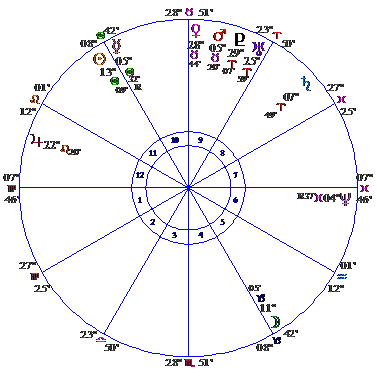
WT Stead – spiritualist

The chart-data – with no time, date or place of birth - was presented in 1001 Notable Nativities - #008. Alan Leo noted: 'rectified' chart and presents another map - #198 – timed for 7.00am. The birth data is: July 5, 1849 at 8.40am; Embleton, England (55N30; 1W37). The (11th house) Sun was at 13 Cancer 09 - in the second decanate - and CC Zain commented: W T Stead, who established the bureau for spirit communication and did so much for the spread of spiritualism, was born with his individuality here. But Astro-Databank explains that Leo in Modern Astrology 7/1912 stated that Stead gave his time as - 'before breakfast' - rectified to 6:00am LMT – and that four rectified times now exist – 6.00am, 7.00am, 8.40am and 9.00am - so the birth time gets a dirty data rating: But this does not affect the Sun's decanate position.
William Thomas Stead was a British journalist, spiritualist and philanthropist. His journalistic career began in 1871 when he first edited a newspaper in then - as the editor of The Review of Reviews and Pall Mall Gazette - he wrote extensively on psychic phenomena, spiritualism and world peace. His spirituality expressed as a peace crusader and champion of justice. He was a passenger on the Titanic and died when it sank on April 15, 1912 – aged 62.
Cancer – second decanate Moon
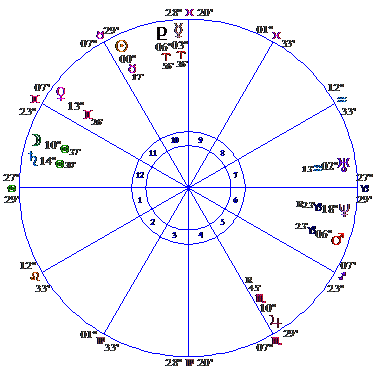
Luke D Broughton – astrologer

The chart-data – with no time, date or place of birth - was presented in 1001 Notable Nativities - #826. The birth data is: April 20, 1828 at 10.00am; Leeds, England (53N50; 1W35). Rodden confirms the data is from him and gives it an A rating, but it does reflect the common practice – back then - of rounding-off the birth time to the nearest hour. The (12th house) Moon was at 10 Cancer 37 - in the second decanate - and CC Zain commented: Dr Luke D. Broughton, author of the well-known 'Elements of Astrology', had his Mentality in this decanate.
Luke Dennis Broughton was a leading astrologer during the last decades of the nineteenth century. He grew up in an astrologically-oriented family - his grandfather, father and brother were all devotees – and he moved to the United States in the early 1840's to study medicine at the Eclectic Medical College in Philadelphia. In 1860 he published Broughton's Monthly Planet Reader and Astrological Journal and in 1863, after anti-astrology laws were passed in Philadelphia, moved his medical office to New York. He began to teach astrology in 1866 and as it grew in popularity he became its defender - against enemies – and protector – from incompetent practitioners. Elements of Astrology was published in 1898 – the year he died.
Cancer – second decanate Ascendant
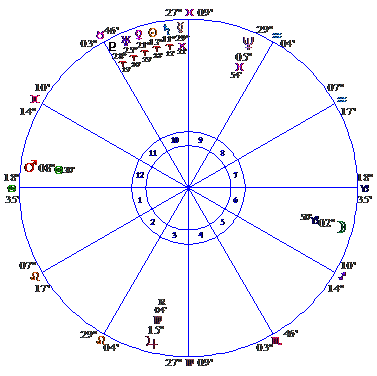
Sarah M Grimke – astrologer and spiritualist

This chart is presented on page 34 of Brotherhood of Light Course 1. The birth-data is April 3, 1850 at 11.03am; Oswego, New York (43N30; 76W30). It's from her and has AA rating. The ascendant was at 18 Cancer 35 – in the second decanate - and CC Zain commented: And Sarah S Grimke, the fine seeress, and author of 'Esoteric Lessons', who contributed valuable work in behalf of spiritual enlightenment, had her Personality in this section of the sky.
Sarah Stanley Grimke was a writer, astrologer and daring pioneer (five planets in Aries) in placing The Brotherhood of Light teachings before the world. She assisted T H Burgoyne in writing that part of Light of Egypt, Vol.1, which deals with The Science of the Stars, and in many other ways gave valuable cooperation in spreading The Brotherhood of Light teachings.
She and Thomas Burgoyne – see page 154 – both had an intercepted Sun in Aries – and pioneers of their generation suffered torment and persecution for their sincerity in trying to spread enlightenment in a world enshrouded in orthodoxy, doubt and academic authority.
The Third Decanate of Cancer – sub-rulers Jupiter and Neptune
The astrological message
ARGO – the constellated ship that gave foundation for the story both Noah's Ark and that of the adventurous Argonautic expedition, pictures the third decanate of Cancer. There will be stormy seas in the lives of those born here, but a tranquil mind will prove an adequate bark to carry them to the shores of safety. They are restless and somewhat discontented. While loving domestic life, yet they are eager to learn what is just below the horizon. Their curiosity, however, becomes an asset and leads them into fields that are all too little known. They are great lovers of Mother Nature, take keen delight in spying out her secrets, and in this kind of work find their greatest natural aptitude.
It is the decanate of RESEARCH
Research is the systematic search for new facts and principles. It's a course of scientific inquiry – a diligent investigation into some subject or theory that seeks to discover the truth of the matter.
Cancer – third decanate Sun
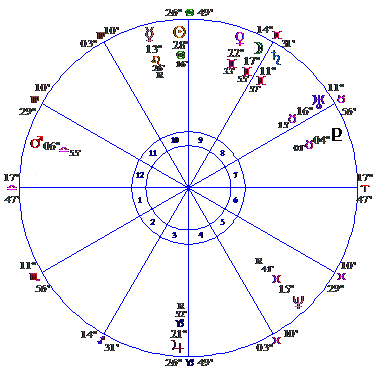
Albert Edelfelt – Finnish painter

The chart-data – with no time, date or place of birth - was presented in 1001 Notable Nativities - #206. Alan Leo noted: private source, time approximate. The birth data is: July 21, 1854 at 12 Noon; Porvoo, Finland (60N24; 25E40). The 10th house Sun was at 28 Cancer 16 – in the third decanate – and CC Zain commented: The celebrated Finnish painter, Albert Edelfelt, had the Sun in this decanate at his birth. But Astro- Databank gives August 2, 1854 at Helsingfors, Finland quoting the British Journal of Astrology for July 21, 1854 Old Style. This seems to be incorrect. All internet sources give July 21, 1854 - Porvoo, Finland. The data has a C rating.
Albert Gustaf Aristides Edelfelt was one of the first Finnish painters to achieve international fame – and one of the founders of the Realist art movement in Finland. Between 1873 and 1882 he studied art in Antwerp, Paris and Saint Petersburg: And in 1888 married Baroness Ellan de la Chapelle. They had one child. He painted the portraits of the the children of Czar Alexander 111 and illustrated Johan Ludvig Runeberg's epic poem The Tales of Ensign Stal. Edelfelt influenced other Finnish painters and helped fellow artists to make their international breakthrough. He died near Borga, Finland on September 19, 1905 – aged 51.
Cancer – third decanate Moon
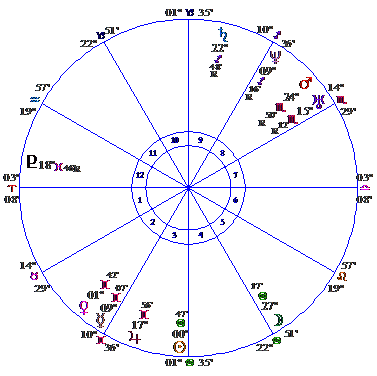
Lorenzo Niles Fowler – phrenologist

The chart-data – with no time, date or place of birth - was presented in 1001 Notable Nativities - #072. The birth data is: June 23, 1811 at 12.05 am; Cohocton, New York (42N30; 77W300). It has a C rating – original source not known. The (5th house) Moon was in 27 Cancer 17 – in the third decanate - and CC Zain commented: Lorenzo Niles Fowler, whose investigations in another department of Nature's laboratory, that of phrenology, has made him noted, had his Moon here at birth.
Lorenzo Niles Fowler and his brother Orson were practitioners of phrenology - the mind science that held that mental faculties indicated by the skull's conformation could be analyzed and improved. In 1842, their Phrenological Depot in New York, offered casts of skulls, phrenological examinations and books. When Orson left the firm in 1855 Lorenzo was joined by his brother in-law, Samuel R Wells. In October 1855 they published the American Phrenological Journal. Through publications, lectures and phrenological examinations Lorenzo Fowler sought to popularize the belief that self-knowledge through phrenological analysis could lead to self-improvement. He died in 1896 – aged 85.
Cancer – third decanate Ascendant
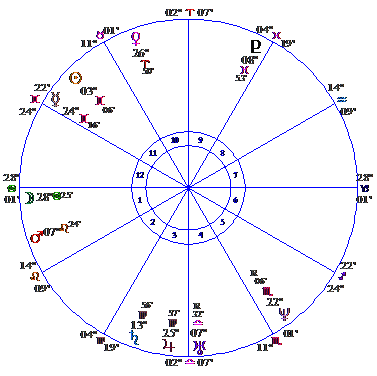
Lord Bulwer-Lytton – author and occultist

The chart-data – with no time, date or place of birth - was presented in 1001 Notable Nativities - #258. The birth data is: May 25, 1803 at 8.00am; London, England (51N30; 00W10). Astro-Databank quotes the British Journal of Astrology 6/1926 for the data from his autobiography and gives it a B rating. The ascendant was at 28 Cancer 01 – in the third decanate – and CC Zain commented: And Bulwer-Lytton, who delved deeply into the occult – for among his many novels we find two depicting respectively the lives of a white and a black magician, 'Zanoni' and 'A Strange Story' – was born with his ascendant in this part of the heavens.
Edward George Earle Lytton Bulwer-Lytton was an English novelist, playwright, poet and politician who pioneered a florid style of writing that is now considered old-fashioned and overly embellished. His successful literary career began in 1820 when he published a book of poems and his unfortunate marital life began in August 1827 when he married Rosina Doyle Wheeler. The marriage produced two children. In 1831 he was elected member for St Ives in Cornwall. Several of his novels were made into operas and Zanoni (1842) had recourse to Rosicrucian and other esoteric notions. He died whilst writing on January 18, 1873 – aged 69.

The Leo Decanates
The First Decanate of Leo – sub-ruler Sun
The astrological message
The first decanate of Leo is pictured among the constellations by CRATER – a furnace, or cup of fire. In this manner did the ancient masters of starry lore portray the fiery love nature of those born under this section of the sky.
Their most notable trait is the desire and ability to rule others. And unless this tendency is restrained there is an inclination to dominate. Yet always there is a powerful love nature. And as love is at the foundation of all achievement, If this love energy can be directed into proper channels, it leads on to success. But due to its strength there is danger of turning to one extreme or the other – either permitting pleasure to dominate the life, or in rebellion at the tendency toward excess to become the avowed ascetic. As neither extreme permits of proper expression of the fine qualities of this decanate the watchword should be moderation.
It is the decanate of RULERSHIP
Rulership is the capacity or authority to control, manage, administer or govern. It's a position of dominant power or influence – the capacity to exercise authority or dominion over others.
Leo – first decanate Sun
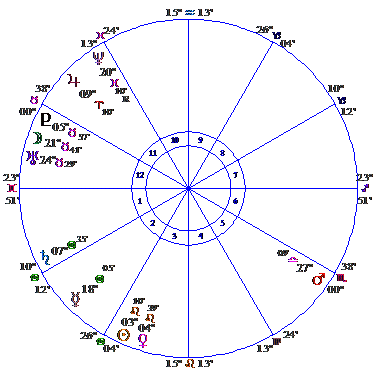
Hiram Butler – astrologer and author

No references to Hiram Butler could be found and his time, date and place of birth are unknown. But....the Sun was in the first decanate of Leo and CC Zain commented: Hiram Butler, author of 'Solar Biology', who founded and ruled a colony of esoteric students whose efforts largely revolve around sex-repression, was born with the Sun here. Butler's books and other publications are available on the internet, but there is no biographical material available. In the later part of the nineteenth century Butler gained some celebrity, or notoriety, with his esoteric theories and book Solar Biology - although Luke D Broughton - see page 57 – openly attacked him and claimed he was incompetent.
George Bernard Shaw – see page 41 – also had the Sun in the first decanate of Leo, but CC Zain focused on the Gemini influence in his chart – which turned out to be the ascendant in the third decanate. This is his correct chart.
The first decanate of Leo pictures a powerful love nature and George Bernard Shaw with the Sun there – conjunction Venus – hitched his love nature to his literary talent and wrote his way to spectacular success and critical acclaim. The Sun-Venus conjunction was in the third house - writing and literary pursuits.
Leo – first decanate Moon
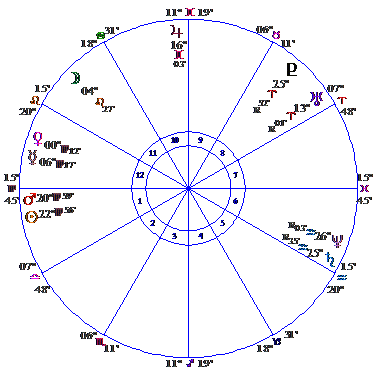
Anna B Kingsford – writer

This is an incorrect decanate reference. The chart-data – with no time, date or place of birth - was presented in 1001 Notable Nativities - #059. The birth data - September 16, 1846 at 5.00am: Stratford, England (52N12; 1W41) - is from her biography. The Moon was in 4 Leo 27 – in the first decanate - and CC Zain commented: Anna B Kingsford who wrote 'The Perfect Way', 'Clothed with the Sun' and other works of an occult character, and whose relationship with a prominent organization was severed because of her own dominant views and teachings, was born with the Moon in this decanate. But Edward Maitland, Kingsford's biographer, had falsified her birth time to accommodate her wish to have Libra rising. Documented family records state 5.00pm – and at 5.00am Virgo was rising – not Libra. The 5.00pm chart has the Moon in 10 Leo 23 - in the second decanate - but it's a close call. This data has a B rating.
Anna B Kingsford was a British physician, writer, spiritualist and antivivisectionist. Her book, The Perfect Way, was published in 1882, to rave reviews and the prominent organization referred to by CC Zain was the Theosophical Society. In May 1882 she became president of its London Branch, but she and Blavatsky clashed so she left and founded her own Hermetic Society on April 9, 1884. She died in January 1888.
Leo – first decanate Ascendant
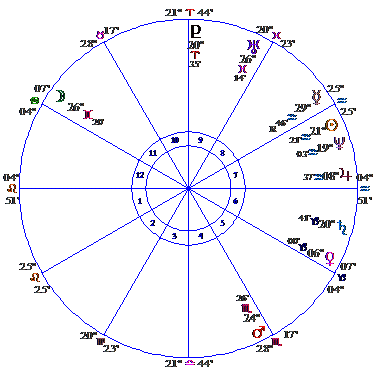
Adelina Patti – prima donna

The chart-data – 4.00pm, 10.2.1843 Madrid, Spain (40N24; 3W41) according to 'Book of Baptisms, No42, fol.153' – was presented in 1001 Notable Nativities - #798. Since then newspaper reports quote the birth certificate – so it has a B rating - but the time won't be exact. The ascendant was in 4 Leo 51 – in the first decanate – and CC Zain commented: And, Adelina Patti, the prima donna, who dominated the multitude through the beauty and power of her voice, was born with this part of Leo as her ascendant.
Adelina Patti was one of the most highly regarded opera singers of the 19th century and composer, Giuseppe Verdi, recognizing the beauty of her voice and the unsurpassed quality of her bel canto technique called her the greatest vocalist he had ever heard. She made her operatic debut in 1858 in New York at the age of 16 and after that success followed spectacular success. She sang all over the world - in her prime demanded $5,000 a performance paid in gold before each performance - married three times - was a not very good film actress - and still remains one of the most famous sopranos in history. She died on September 27, 1919 in Wales – aged 76 - and her surviving recordings were reissued on CD in 1998 by Marston Records: So if you wish you can hear her glorious voice.
The Second Decanate of Leo – sub-ruler Jupiter
The astrological message
In the second, or Jupiter, decanate of Leo, the inherent quality of dominant control characteristic of Leo, is modified by the sub-influence of the sign of the higher mind, Sagittarius. The philosophical and religious elements are more in evidence, and those born here readily recognize the prevalent weaknesses both in current politics and in current religion. And what is more important, they have the courage of their convictions and the power to gain followers for their own progressive ideas.
To picture the ruthless onslaughts with which these people attack other persons and policies that seek to ravage society, CENTAURUS, a being having the lower parts of a horse and the upper parts of a man, is represented among the constellations as impaling on the end of his spear the wolf that pictures the last decanate of Libra. This wolf symbolizes those who use the brilliancy of their intellects to suppress truth and to foist ignorance and superstition upon society that they may profit by its exploitation. As those born in this middle decanate of Leo have the power to convince others, it behooves them to put forth every effort to gain truth, and to take great care that they do not disseminate erroneous notions.
It is the decanate of REFORMATION
Reformation is the act of improving or amending that which is wrong. The removal of faults, defects or abuses – or putting an end to social and other wrongs - results in radical change for the better.
Jupiter – the planet of religion - is exalted in the 15th degree of Cancer.
Pluto – planet of spirituality - is exalted in the 17th degree of Leo.
Leo – second decanate Sun
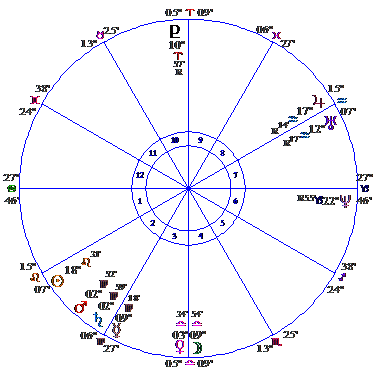
HP Blavatsky – founder of the Theosophical Society

The chart-data – with no time, date or place of birth – was presented in 1001 Notable Nativities - #018. The birth data is: August 12, 1831 at 3.00am: Ekaterinslav, Russia ( 48N27; 35E00). Alan Leo explained that 'H P B informed me that it was between midnight on the 31st (July OS) and sunrise of the next day'. This has resulted in an abundance of rectified birth times. The guesses include: 12.10am, 1.42am, around 2.00am, 2.17am, 2.33am, 3.00am and 4.38am. Rodden gives the 2.17am time a C rating. The uncertain birth time does not affect the Sun's sign position in 18 Leo – in the second decanate – and CC Zain commented: Madam H P Blavatsky, founder of the Theosophical Society, was born with her Individuality here.
Elena Petrovna Gan – better known as Helena Blavatsky – was a high profile and controversial writer, mystic and Theosophist. Born in Russia she traveled the world, wrote prolifically, smoked incessantly, married twice, became a US citizen and claimed to have extraordinary psychic abilities. In November 1875 – in New York - she helped found the Theosophical Society with Henry Steele Alcott – see page 101 - and William Q Judge – see page 24 - and in 1882 moved the organization's headquarters to Adyar, India. Suffering from heart disease, rheumatism and Bright's disease she died in England on May 8, 1891 – aged 59.
Leo – second decanate Moon
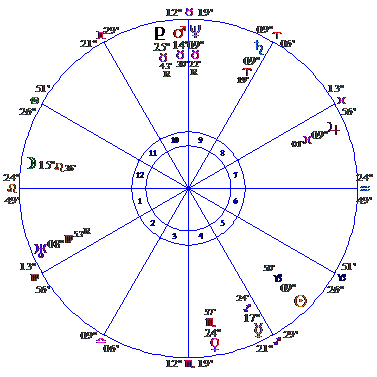
Malcolm Mitchell – secretary of the Men's League for Women's Suffrage

The chart-data – with no time, date or place of birth - was presented in 1001 Notable Nativities - #201. The birth data is: December 31, 1879 at 8.00pm LMT (could be standard time): London presumed ( 51N30; 00W10). Alan Leo stated that the data came from a private source (ps). It has a C – for caution – rating. The (12th house) Moon was in 15 Leo 36 – in the second decanate – and CC Zain commented: Mr J. Malcolm Mitchell, secretary of the Men's League for Women's Suffrage, had his Moon in this decanate.
In the U.K. Parliament between 1886 and 1911 women's suffrage – right to vote – bills were repeatedly defeated so in 1906 Emmeline Pankhurst and her daughters took militant action and founded the Women's Social and Political Union (WSPU). Then, in 1907, militant support came from the left-wing writers Henry Brailsford, Max Eastman, Laurence Housman and Henry Nevinson when they formed the Men's League for Women's Suffrage – with J Malcolm Mitchell as its secretary. The male dominated establishment continued to exert powerful resistance till 1918 when women were finally granted partial suffrage – the right to vote. In 1928 it was extrended to all women over the age of 21.
Leo – second decanate Ascendant
Martin Luther – founder of the protestant religion

This is an incorrect decanate reference. Alan Leo in 1001 Notable Nativities presented three (3) different charts. Chart #486 had 6 Leo on the ascendant with a note: born October 22, 1483 according to Cardan; with another comment When and Where of Famous Men and Women gives November 10, 1483. Chart #487 had 15 Leo on the ascendant with a note: according to Junctinus; born October 22, 1483. (This chart was timed for 11.33am and Alan Leo simply copied the chart data from a chart published by Giuntini Junctinus in 1583.) Chart #488 had 21 Capricorn on the ascendant with a note: according to Gauricus; born October 22, 1484. (In this instance the chart-data was copied from a book of charts published by Lucus Gauricus in 1542.)
Martin Luther was the founder of the Protestant religion and C C Zain, requiring an example reference for the second decanate of Leo, selected the chart in Notable Nativities that had 15 Leo on the ascendant. He commented: And Martin Luther, founder of the Protestant religion, was born with his Personality polarized in this section of the sky – the second decanate of Leo. But the three (3) charts presented in Notable Nativities were all wrong. And Astro Databank reveals how everyone kept getting it wrong simply because no one checked the birth record.
Astro Databank explains that Tycho Brahe claimed that Luther's mother recalled the time and day of birth - 11.00pm on November 10th - but couldn't remember the year! And that the Royal Danish Library gives the birth date as October 22, 1483 OS – October 31, 1483 NS. It also documents various birth times – 11.00pm from his mother, 10.00pm from Dardanus, 11.20pm from Garcaeus, 11.36pm from Junctinus and 10.59 pm from Ebertin: And reveals that Gauricus, a Catholic Monk, (chart #488 in Notable Nativities) had falsified Luther's birth year to 1484. The other two charts presented by Alan Leo both had the birth date wrong.
The almost correct birth data from Edwin Steinbrecher quoting the Birth Record is:
November 10, 1483 OS – November 19, 1483 NS - at 11.00pm LAT – 10.46pm LMT: Eiselben, Germany (51N31; 11E32): And this means that astrologers were using incorrect birth data for Martin Luther for about 500 years. The 10.46pm time – which has a AA rating - won't be precise. It could be off by minutes or hours. Due to the birth year – 1483 – no chart can be presented but the (4th house) Sun was in 27 Scorpio 20 – in the decanate of Attainment; the (9th house) Moon was in 11 Aries 04 – in the decanate of Exaltation; and the ascendant was in 24 Leo 54 – in the decanate of Ambition.
The Third Decanate of Leo – sub-ruler Mars
The astrological message
CORVUS, the Raven, is the constellation picturing the tendencies of people born under the third decanate of Leo. This raven is pictured with wings outspread as if in readiness to fly aloft, but with it feet firmly gripping the back of Hydra, the water-serpent, This symbolizes the emotions that are associated with creative energy, for the raven appears to be making a meal of the flesh of the serpent.
In this last portion of Leo we have the love of power and rulership combined with the quality of leadership bestowed by Aries. As a consequence those born under this section of the sky are determined to rise in life regardless of the obstacles. And when this tendency is carried to extremes they will sacrifice their associates, their family, and even integrity itself, in order to increase their power. But when their ideals are thoroughly for the welfare of humanity rather than for mere personal aggrandizement, they become of immense service to society through their natural gift of being able to handle others and use them to advantage.
It is the decanate of AMBITION
Ambition is the drive, zeal, inspiration or intent to push onwards towards a goal - or the eager desire for distinction, preferment, advancement, promotion, power, honor or fame.
Leo – third decanate Sun
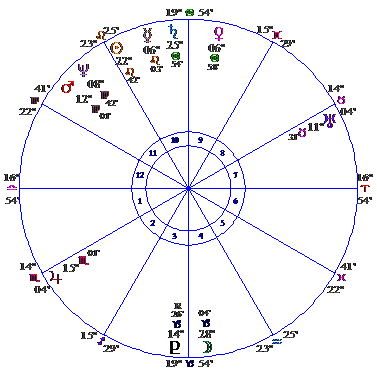
Napoleon 1 – French Emperor and military leader

This is an uncertain decanate reference. The chart-date – with no time or place of birth – was presented in Notable Nativities - #731. The birth-data is: August 15, 1769 at 9.50am LMT: Corsica (41N46; 8E48). Alan Leo specified – b. 15.8.1769 – with the proviso 'while there's uncertainty, most believe it's genuine'. The Sun was in 22 Leo 42 – in the third decanate – and CC Zain commented: Napoleon 1, who attempted to conquer the world by arms was born with the Sun in this decanate. There's no birth time on the baptismal certificate and Rodden gives 11.30am LMT on August 15, 1769 an A rating.
The uncertainty Alan Leo refers to concerns the possible switching, by Napoleon's father, of his son's birth dates. It seems he wanted Napoleon to attend military school in France, but he was too old and by switching his son's birth dates - Napoleon born on January 7, 1768 with that of his brother born on August 15, 1769 – Napoleon became 18 months younger. In Delineating the Horoscope CC Zain, when commenting on Napoleon's chart, states: 'Saturn is the dominant planet. This planet did not influence his height, but it strongly impressed his features, as seen in his famous pose of deep meditation with downcast eyes.' But one wonders if this pose mirrored a Capricorn Sun-sign. On January 7, 1768 the Sun, in the second decanate of Capricorn, was conjunct Pluto and the Moon was in the third decanate of Leo!
Leo – third decanate Moon
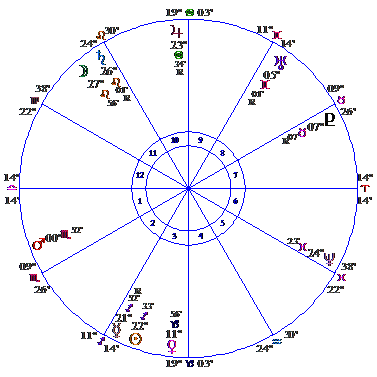
Dr Ludwig Zamenhoff – inventor of Esperanto

This is an uncertain decanate reference. The chart-data – with no time, date or place of birth - was presented in 1001 Notable Nativities - #432. The birth data is: December 15, 1859 at 1.50am LMT: Bialystok, Poland (53N09; 23E09). Alan Leo stated: spec horoscope by Sarastro. It has a C rating – caution required. The (11th house) Moon was in 27 Leo 56 – in the third decanate – and CC Zain commented: Dr. Zamenhof, who invented a language, Esperanto, which was to supersede all other languages in the world, had his Moon in this section of the heavens. But the Moon moved to the first decanate of Virgo at 5.17am so the validity of the decanate reference hinges on the accuracy of the birth time.
Ludwig Lazarz Zamenhof was an ophthalmologist, philologist and the inventor of a constructed language called Esperanto. Saddened and frustrated by the inability of various ethnic groups to cooperate he supposed the main reason for the hate and prejudice lay in mutual misunderstanding, caused by the lack of one common language. To promote peaceful coexistence he invented Esperanto which according to 1975 sources had between 1 and 15 million speakers. Zamenhof died on April 14, 1917 and his three children – Adam, Sofia and Lidia - were murdered in the Holocaust.
Leo – third decanate ascendant
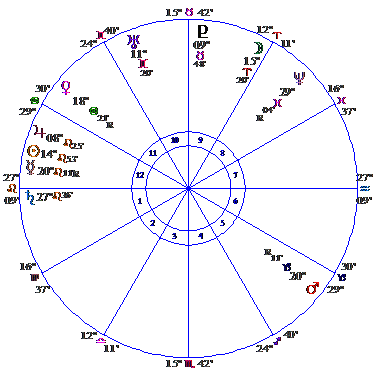
Alan Leo – astrologer

This is an uncertain decanate reference. The chart-data – with no time, date or place of birth - was presented in 1001 Notable Nativities - #034. The birth data is: August 7, 1860 at 5.49am: Westminster, England (51N30; 00W09). It came from Alan Leo. The Ascendant was in 27 Leo 09 - in the third decanate – and CC Zain commented: And Alan Leo, who attempted to give to astrology a world-wide recognition and power, was born with his ascendant here. But Leo also gave 'about 6.00am' and 6.10am – and at 6.10am 00 Virgo 50 was on the ascendant. The data has a C – for caution - rating.
William Frederick Allan – Alan Leo – was a prominent British astrologer, author and theosophist who played an influential role in raising astrology's public profile at the start of the Aquarian Age. In 1889 he launched the Astrologer's Magazine – took the name of his Sun-sign in 1890 – and in 1895 reinvented the Astrologer's Magazine as Modern Astrology. Large astrological recipe books explaining the planets, signs and houses in generic terms with the Sun taking center stage followed – and in 1915 he founded the Astrological Lodge of the Theosophical Society. Leo saw astrology as a coded language that only theosophy could explain and comprehend – and introduced reincarnation, karma and the evolution of the soul into the Alan Leo astrological model. He died of a cerebral haemorrhage on August 30, 1917 – aged 57.

The Virgo Decanates
The First Decanate of Virgo – sub-ruler Mercury
The astrological message
In the Mercury-decanate of Virgo we find the assimilative quality exercised to the most pronounced degree. The mind of those born here are usually restless and active, a tendency pictured among the constellations by BOOTES – the Bear Driver – who follows the Great Bear, symbol of the objective mind, about the heavens with an upraised sickle, urging him on. And to convey the idea that man's thoughts, when carefully tended, yield a most precious fruitage, Bootes is traditionally associated with the vine of the grapes; for he is also a husbandman.
So those who are native to this section of the zodiac press, with great dexterity, the wine from all life's varied experiences. It then becomes a coveted elixir which stimulates them to still greater accomplishment. This is the harvest decanate, and these people readily sift the grain from the chaff, and use it practically for sustenance.
It is the decanate of ACHIEVEMENT
Achievement is worthwhile accomplishment – the completion of an important task or job. It requires valor, boldness and superior ability.
Virgo – first decanate Sun
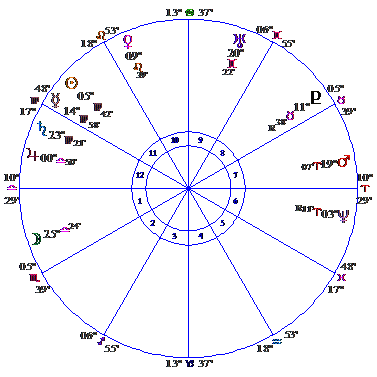
Maurice Maeterlinck – writer

The chart-data – with no time, date or place of birth - was presented in 1001 Notable Nativities - #919. The birth data is: August 29, 1862 at 12.20am LMT: Ghent, Belgium (51N03; 3E43). 00W10). Alan Leo noted: spec hor and the speculative birth time turned out to be incorrect. The birth time from Michel Gauquelin, quoting the birth record, is 8.30am LMT. This does not affect the Sun's position in 5 Virgo 42 – in the first decanate – and CC Zain commented: Maurice Maeterlinck, so successful in literature, was born with his Individuality in this decanate. The correct birthchart is presented. The data has a AA rating, but the birth time won't be precise.
Maurice Maeterlinck was a Belgian playwright, poet and essayist who wrote in French. The main themes of his work are death and the meaning of life: And his most notable works are: Intruder (1890), Interior (1895) and The Bluebird (1908). In August 1890 he achieved overnight fame when his first play Princess Maleine received popular and critical praise- but in 1926 his reputation took a dent with accusations of plagiarism. In 1903 Maeterlinck was awarded the Triennial prize for Dramatic Literature and in 1911 The Nobel Prize for Literature. Major life events include - mother's death (June 11, 1910) and marriage (February 15, 1919). He died on May 6, 1949 – aged 86.
Virgo – first decanate Moon
Alexander the Great – military achiever

This is an incorrect decanate reference. The chart-data – with no time or place of birth – was presented in 1001 Notable Nativities - (#437). Alan Leo noted: b. 1.7.357 BC – CG (Collectio Geniturarum, by John Gadbury, London 1662) quoted from Lyndholt 112 – and copies the chart-data given by Gadbury – Uranus and Neptune are omitted. The Sun was at 7 Cancer – in the first decanate - and the ascendant was at 8 Aquarius – in the first decanate. The Moon was at 8 Virgo – in the first decanate – and CC Zain commented: Alexander the Great, whose military achievements have been unsurpassed, was born with the Moon in this part of the heavens. But it's a pretty sure bet that none of these placements will be correct simply because no one knows Alexander's precise birth date.
Lois Rodden in Astro Data 11 gives July 17, 355BC NS at 11.00am LMT: Pella, Macedonia (40N45; 22E33). But the chart-details are for the 354 BC – not 355 BC. The corrected details - for July 17, 355 BC - are: The Sun is at 23 Cancer 36 – in the third decanate; the Moon is at 23 Libra 45 – in the third decanate; and the ascendant is at 26 Virgo 05 – in the third decanate. It gets a dirty rating and Rodden explains why.
MA (Modern Astrology) in July 1930 quotes Die Astrologie in June 1927 for '10.00am to 12 noon, on the 6th Hekatombaeon when equivalent to 6th Loos – July 22, 356 BC OS. (Rodden's time – 11.00am - is half way between 10.00am and 12 noon – but the birth year is different.) And 1001 Notable Nativities quotes Lyndholt for July 1, 357 BC NS. Finally an entry on Wikipedia gives Alexander's birth date as July 20, 356BC. This means that Alexander was born on four different days in 3 different years so the chances of having accurate birth data are nil. Due to the birth year – 355BC, 356BC or 357BC – no chart can be presented.
Alexander the Great was king of Macedonia and conqueror of the Persian Empire. He was educated by Aristotle and in 336 - at the age of 20 – became king when his father, Philip 11, was assassinated. His inheritance included a magnificent army and a plan to invade the Persian Empire. So in 334 BC he set out to conquer Asia-Minor and over the next thirteen years he vanquished Persia, Tyre, Gaza and Egypt and spread the Greek civilization into the East. Then - in 327 BC - he set his sights on India, but was forced to retreat when his troops - tired of war – refused to go on. Alexander's short, but action packed, life came to end in Babylon on June 10 or 11, 323 BC when he died of malaria. He was 31, 32 or 33 years old.
Virgo – first decanate Ascendant
Henry Cornelius Agrippa – ceremonial magician

The chart-data – with no time or place of birth - was presented in 1001 Notable Nativities - #489. Alan Leo noted: b. 14.9.1486 – G - Lucas Gauricus (639); C - Jerome Cardan 491; J - Junctinus 541 and CG – Collectio Geniturarum (John Gadbury) 124. The birth data is September 14, 1486 OS – September 23, 1486 NS (there's a plus nine day correction) - at 3.15am LMT: Cologne, Germany (50N56; 6E59). But the chart-data presented in Notable Nativities is for September 24, 1486. The ascendant was in 2 Virgo – in the first decanate – and CC Zain commented: And Henry Cornelius Agrippa, who attained success and renown in the practice of ceremonial magic, was born with his Ascendant here. But, being an ascendant reference, its validity depends upon the accuracy of the birth time.
The original source of the birth data seems to be a chart presented by Lucas Gauricus in Operum Omnium, vol 11, Basilicae 1575 - 'the same maps are given in his Tractatus Astrologicus, Venetiis 1542'. Agrippa was an astrologer so a birth time probably existed, but he died in 1535 - seven (7) years before Gauricus published his collection of maps in1542. So where did Gauricus get the birth time from?
Astro Databank presents a chart for September 23, 1486 NS at 3.24am LMT: Cologne, Germany. The source notes read: Burt Granite quotes Gadbury (September 14 OS). Leo also quotes Gadbury so why are the two charts for different dates and times? It's all a bit of a mess, but if the birth time is reasonably accurate the ascendant will be in the first decanate of Virgo. Rodden gives the conflicting data a dirty-data rating.
Heinrich Cornelius Agrippa von Nettesheim was a German magician, occult writer, theologian, astrologer and alchemist. He was devoted to the study of magical or occult arts and his summary of early occult thought – De occulta philosophia librs tres – which he worked on and revised for over twenty years - was eventually published in 1533 – two years before his death. Some commentators claim that 'Agrippa clearly and unequivocally rejected magic in its totality, from its sources in imagined antiquity to contemporary practice': But others suggest that he only rejected his early thoughts on the subject as they evolved into a better understanding. He gave some sage advice that holds true today: 'Nothing is concealed from the wise and sensible, while the unbelieving and unworthy cannot learn the secrets.' He died in Grenoble on February 18, 1535 – aged 48.
The Second Decanate of Virgo – sub-ruler Saturn
The astrological message
The Saturn-decanate of Virgo is pictured among the constellations by HERCULES – the Hero – who, among other things, performed twelve superhuman labors. One foot crushes the head of the Cyclic Dragon, while his outstretched hand grasps the apples of Hesperides. This depicts the tendency of those born under this section of the sky to undertake and accomplish, by unremitting toil, the performance of gigantic tasks. They also have an exceptional variety of experiences, both with the so-called good and the so-called evil. Thus are their lives filled with events.
Here we find the assimilative powers of the mind, conferred by Virgo, to be given a diplomatic trend, and often there is a great desire for worldly fame and honour. The temptations that come to these people are great. But if they guard against the allurements of the flesh that sooner or later come into their lives, they can rise to great heights through their unusual powers of discernment and comparison.
It is the decanate of EXPERIENCE
Experience is the personal encountering or undergoing of an event, incident, adventure, happening, episode or condition. They're usually identified as fortunate and good or unfortunate and bad.
Virgo – second decanate Sun
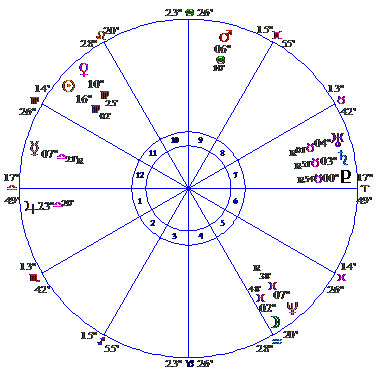
Mabel Collins – occult writer

The chart-data – with no time, date or place of birth - was presented in 1001 Notable Nativities - #200. The birth data is: September 9, 1851 at 8.30am LMT: London, England (51N30; 0W10). Alan Leo stated that the data came from a private source and that the time was approximate. It has a C – for caution – rating. The (11th house) Sun was in 16 Virgo 02 - in the second decanate – and CC Zain commented: Mabel Collins, who wrote 'Light on the Path' and other occult works, and whose life has been varied in experience, was born with the Sun in this decanate.
Mabel Collins, whose life has been described as a complete mystery, was an author, medium, theosophist, fashion writer and anti-vivisectionist. At the start she was very active in The Theosophical Movement, but conflicts arose and her friendship with Helena Blavatsky turned to enmity. Her father, Mortimer Collins, was a writer and Mabel - writing as Mrs Keningdale Cook - used her experiences with the occult and theosophy as a basis for her fiction writing. She penned at least 46 books – mostly romantic fiction. She was also the fashion correspondent - and wrote a regular column for The World: And, as Mrs Keningdale Cook, was a well-known anti-vivisectionist. She's mainly remembered for her spiritual work, Light on the Path.
Virgo – second decanate Moon
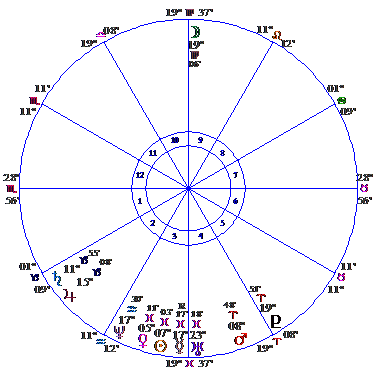
Camille Flammarion – Astronomer and scientist

The chart-data – with no time, date or place of birth - was presented in 1001 Notable Nativities - #858. The birth data is: February 26, 1842 at 1.00pm LMT: Montigny Le Roi, France (48N00; 5E30). Alan Leo stated: private source (ps) - and Rodden has the same data from Gauquelin who quotes the birth record. It has a AA rating. The (9th house) Moon was in 19 Virgo 06 – in the second decanate – and CC Zain commented: Camille Flammarion, the great French astronomer, who likewise is an authority on Psychic Research and a wide variety of other matters, had the Moon here at birth.
Nicolas Camille Flammarion was a French scientist, astronomer and author who stirred up a big, heavy-duty controversy with his psychic investigations. Because of his scientific background he approached spiritualism and psychic matters from a scientific viewpoint – 'It is by the scientific method alone that we may make progress in the search for truth': And he claimed - 'spiritism is not a religion but a science'. He wrote more than fifty books and was the first to suggest the names Triton and Amalthea for moons of Neptune and Jupiter. They were officially adopted many years later. He died of heart failure on June 3, 1925 – aged 83.
Virgo – second decanate Ascendant
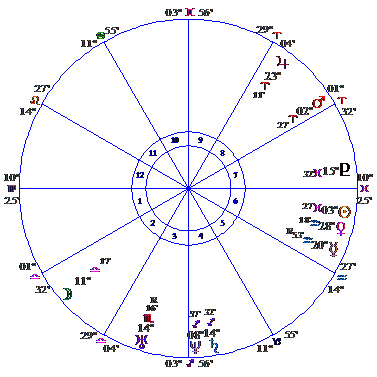
Chopin – composer

This is an uncertain decanate reference. The chart-data – with no time, date or place of birth - was presented in 1001 Notable Nativities - #389. The birth data – quoting the birth certificate - is: February 22, 1810 at 6.00pm LMT: Zelazowa Wola, Poland (52N14; 20E40). The ascendant was in 10 Virgo 25 – in the second decanate – and CC Zain commented: And Chopin, the great composer, whose affair of the heart ended so disastrously, had this part of the heavens on the ascendant at his birth. But Chopin's parents claim that they made an error of eight (8) days when registering his birth and family records state he was born on March 1, 1810. A chart timed for 6.00pm LMT on this date has 15 Virgo 13 - in the second decanate - on the ascendant so the onus is on the accuracy of the birth time. This decanate of Virgo was rising for approximately one (1) hour. Conflicting birth dates mean the data gets a dirty-data rating.
Frederic Francois Chopin was a Polish composer and virtuoso pianist – one of the great masters of Romantic music. The disastrous affair of the heart mentioned by CC Zain refers to his turbulent ten year relationship with George Sand - see page 25. Always in frail health, Chopin died on October 17, 1849 of pulmonary tuberculosis – aged 39.
The Third Decanate of Virgo – sub-ruler Venus
The astrological message
The last decanate of the northern signs is pictured by a crown of twelve iron spikes. This Venus-decanate of the mental sign Virgo is the point from which the Sun passes into the winter section of the zodiac. And so the serpent, picturing the first decanate of Libra is represented with its fangs just before CORONA BOREALIS – the Northern Crown – as if to strike.
Virgo, as a whole, corresponds to the house of work. So this last decanate seems particularly given to working in behalf of others. People born here find their greatest possibilities in the realm of service. When they can lose sight of the reward and labor enthusiastically for some noble cause, they live to their utmost. Even though the laborer is worthy of his hire, yet those born under this influence are often called upon to give up the things they would prefer to do for the sake of duty. Though the material reward is a crown of thorns, yet the gain in character and soul-power always more than repays for all sacrifice.
It is the decanate of RENUNCIATION
Renunciation is the voluntary giving up; the formal abandonment of a right or title; the rejection of a belief or habit; or the repudiation of a person or thing. It usually involves personal sacrifice.
Virgo – third decanate Sun
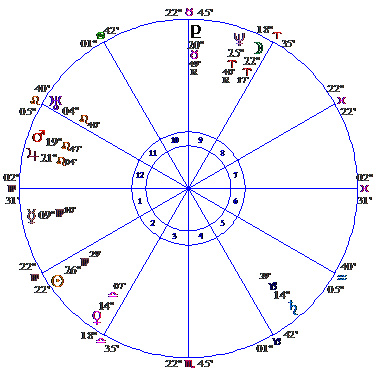
Henrich Daath – astrologer

The chart-data – with no time, date or place of birth - was presented in 1001 Notable Nativities - #110. The birth data is: September 19, 1872 at 3.28am LMT (could be standard time): Peterborough, England (52N35; 00W15). It's from Daath, himself, so it has an A rating. The (2nd house) Sun was in 26 Virgo 29 – in the third decanate – and CC Zain commented: Henrich Daath, who labored so steadfastly in the cause of modern astrology, was born with his Individuality here.
The modern astrology referred to by CC Zain was the sun-sign astrology being peddled by Alan Leo in his Modern Astrology Magazine – first published in England in 1890. At the time there was little public interest in astrology – it had been on the decline since the 17th century – but sensational change was on the agenda and Leo's modern astrology helped spark a revival. Modern Astrology was just what the new age needed, but Leo's over-emphasis of the sun-sign not only encouraged sun-sign astrology - and cheap personal horoscopes - it contradicted what the ancients thought and taught. On the upside people had their astrological awareness raised – just a little. Heinrich Daath - a modern astrologer and frequent contributor to Alan Leo's Modern Astrology - was the author of Medical Astrology.
Virgo – third decanate Moon
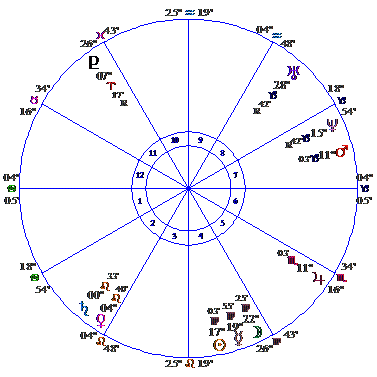
Leo Tolstoy – novelist and dramatist

This is an uncertain decanate reference. The chart-data – with no time, date or place of birth - was presented in 1001 Notable Nativities - #719. The birth data is: September 9, 1828 at 10.35pm LMT: Tula, Russia (54N12; 37E37). Alan Leo noted: spec horoscope. The (4th house) Moon was in 22 Virgo 25 - in the third decanate – and CC Zain commented: Leo Tolstoy, who, though born of nobility, lived so simply and made so many sacrifices in the cause of peace and purity, had his mentality in this decanate. But the Moon was in the second decanate of Virgo till 5.48pm – so the validity of the decanate reference depends upon the accuracy of the speculative-unverified birth time, which gets a dirty-data rating.
Leo Tolstoy – the author of War and Peace (1869) and Anna Karenina (1877) – is widely regarded as the one great Russian novelist, but his life experience had an eccentric twist. The story concerns his accidental financial position - the belief that he was undeserving of his material success – and the development and harboring over many years of a radical desire to abandon his family and reject his inherited and earned wealth. On November 20, 1910 – at the age of 82 – he eventually acted on his radical desire and left the family home. He made it to the Astapova railway station, but he was an old man and he died there of pneumonia.
Virgo – third decanate ascendant
Swami Triganiteti – Vedanist teacher

No birth data or biographical material relating to Swami Triganiteti could be found. It can only be presumed that he had the third decanate of Virgo rising, which prompted CC Zain to comment : And Swami Triganiteti, the Vedanist teacher who was blown to pieces in his temple in San Francisco, while he was faithfully serving his religion, had his personality polarized in this place. And, it is interesting to note, that CC Zain chose three leading figures associated with the revival of the Vedanist religious philosophy in the 19th Century as example decanate references.
Vedanta, which literally means 'end of the Veda', is a school of Hindu knowledge. Veda means 'divine knowledge' and the Vedas were the most sacred of the ancient Hindu scriptures. The oldest may date from 1500 or 2000 BC. The four main collections are: the Rig-Veda (hymns and praises) – mentioned by CC Zain in Spiritual Astrology (page307 – 'And the Rig-Veda states that it was this Eagle which brought the Soma juice to India'; Yagur-Veda (prayers and sacrificial formulae); Sama-Veda (tunes and chants); and Atharva-Veda – or Veda of the Atharvans, the officiating priests at the sacrifices. Then in the 8th Century AD a dissatisfied student, Shankara, founded Vedanta – and provided a new and different interpretation to the original texts.
His philosophy teaches that there is no real difference, no separation, between the self and God – the major force underlying the entire cosmos: And that human souls are another aspect of God – we're all part of the same divine stuff. But reaching a state of consciousness where this makes sense isn't easy. Matter is an illusion and rational thought provides misleading perceptions. The only thing that doesn't change is your own deep consciousness – your ego – see Spiritual Alchemy – page 12 where it's described as 'an imperishable spark of Deity'. By piercing the illusions of matter you can be released and become one with the Divine.
In the 19th century the philosophy experienced a renaissance through the Hindu mystic and teacher Ramakrishna – see page 148. His ideas, based on the ancient Vedic scriptures, led to the formation of the Ramakrishna Mission in 1898 by his chief disciple Swami Vivekananda – see page 130. Vivekananda, who introduced Hinduism to the West at the Parliament of World Religions in Chicago in June 1893, was a key figure in the introduction of Vedanta in Europe and America and a major force in the revival of Hinduism in modern India.

The Libra Decanates
The First Decanate of Libra – sub-ruler Venus
The astrological message
The first decanate of Libra is pictured among the constellations by SERPENS – the Serpent. This is the snake that sacred tradition asserts tempted Eve to her downfall. The serpent has been used from ancient times, however, not only as a symbol of creative energy, but also of cunning. In worldly matters those native to this decanate have no need of the admonition to be 'wise as serpents', for they have the innate ability to handle people and situations.
It will be remembered that the Biblical serpent told Eve if she would eat of the apple she would become wise – and that subsequent events verified the prophecy.
And those born under this decanate well uphold all the serpent traditions of wisdom and subtlety, and besides possess the creative energy to pioneer in the realms of human association. Such people should never seek seclusion to be at their best, but should mix in the world's affairs and come in contact continuously with their fellow-men. In this field they can wield an enormous power for good through their ability to influence the thoughts and actions of others. But they should take pains not to become too engrossed in purely material aims.
It is the decanate of POLICY
Policy is a course of action. It's a line of procedure, a management method or a mode of personal conduct that's adopted for a specific purpose.
Libra – first decanate Sun
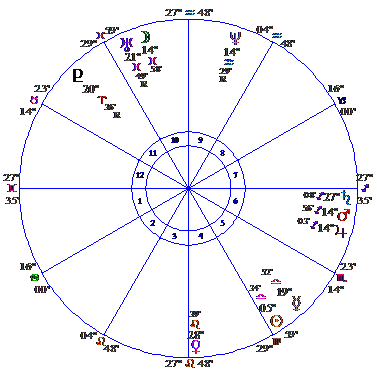
Georges Clemenceau – Prime Minister of France

The chart-data – with no time, date or place of birth - was presented in 1001 Notable Nativities - #907. Alan Leo noted: 'private source'. The birth data is: September 28, 1841 at 9.30pm LMT: Mouilleron, France (46N41; 0W51). Michel Gauquelin got the same data from the birth record. It has a AA rating. The (5th house) Sun was in 5 Libra 34 – in the first decanate – and CC Zain commented: Georges Clemenceau, the 'Tiger' prime minister of France, was born with his Sun in this part of the sky.
Georges Clemenceau was a sharp-tongued, radical left-wing French politician, physician and owner-editor of several newspapers who was nicknamed 'le Tigre' and 'le Pere-la Victoire' - Father Victory - for his determination as a wartime leader. He was arrested on February 23, 1862 for placing posters summoning a demonstration and spent 77 days in the Mazas prison - on May 13, 1865 he became a doctor - and on July 23, 1871 he was elected to the Paris municipal council. He served as prime minister from October 25, 1906 to July 24, 1909 and from November 16, 1917 to January 20, 1920 – and in 1919 chaired the Versailles peace con-ference, but failed to secure the Rhine as a frontier for France in the treaty signed on June 28, 1919. He married - had three children – divorced – and died in Paris on November 24, 1929.
Libra – first decanate Moon
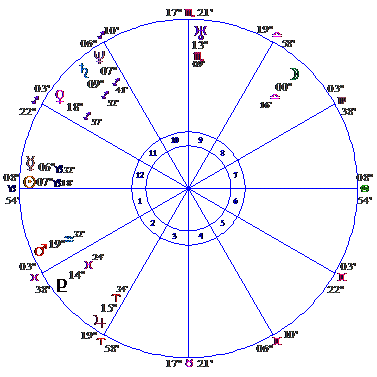
William Ewart Gladstone – statesman

This is an uncertain decanate reference. The chart-data – with no time, date or place of birth - was presented in 1001 Notable Nativities - #029. The birth data is: December 28, 1809 at 8.30am LMT: Liverpool, England (53N25; 2W55). The (8th house) Moon was in 00 Libra 16 - in the first decanate – and CC Zain commented: Wm. Ewart Gladstone, the great statesman, had the Moon in this place at his birth. But the precise birth time is not known. Pagan in 'Pioneer to Poet' gave 'about 8.00am, breakfast time' and Astro Databank gives 8.15am a C rating – original source not known. If the birth occurred before 7.59am the Moon was in the third decanate of Virgo.
William Ewart Gladstone was a British Liberal politician and four times Prime Minister of the United Kingdom. He entered parliament as a Tory in 1833 - left the party in 1846 - and after 1859 identified himself with the Liberals. He was Chancellor of the Exchequer 1853-55 and prime minister -1868–74, 1880–85, 1886 and 1892–94. Gladstone introduced elementary education in 1870 - vote by secret ballot in 1872 – and many reforms in Ireland – but failed in his efforts to get a Home Rule Bill passed. Queen Victoria complained: 'He always addresses me as if I were a public meeting.' Gladstone died on May 19, 1898 – aged 88.
Libra – first decanate Ascendant
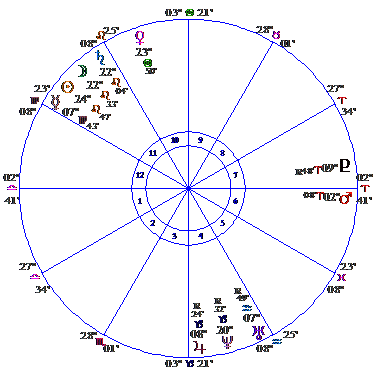
Emperor Franz Joseph of Austria

This is an incorrect decanate reference. The chart-data – with no time, date or place of birth - was presented in 1001 Notable Nativities - #152. Alan Leo noted: 'born four hours before (solar) eclipse'. The birth data is: August 18, 1830 at 8.30am: Vienna, Austria (48N13; 16E20). The ascendant was at 2 Libra 41 – in the first decanate – and CC Zain commented: And Emperor, Franz Joseph of Austria, who triumphed over so many difficult situations, was born with his ascendant here. But the birth time was wrong. The official birth record – with a AA rating - states 9.15am. This puts the ascendant in 10 Libra 57 - in the second decanate - but as the ascendant moved to the second decanate at 9.09.48am it's all a matter of precise timing.
Franz Joseph 1 reigned as Emperor of Austria from 1848 until 1916. He became king – aged eighteen - on December 2, 1848 when his uncle, Ferdinand 1, abdicated - and married on April 24, 1854. Then - in 1858 - he was defeated in the Italian War – in 1861 he granted Austria a parliamentary constitution – in 1866 he was defeated in the Prussian War – in 1867 he granted Hungary equality with Austria – and in 1914, when his nephew and heir, Franz Ferdinand, was assassinated, took the opportunity to attack Serbia, precipitating World War 1. Franz Joseph died on November 21, 1916 – aged 86 – and his 68-year reign as king is the third-longest in recorded European history.
The Second Decanate of Libra – sub-ruler Saturn and Uranus
The astrological message
The Aquarius decanate of Libra differs somewhat from the other decanates of this sign in the strong tendency to express individuality. Being under the sub-influence of Uranus, it partakes of the Uranian quality of originality and sometimes even eccentricity. It is pictured among the constellations by DRACO – the Dragon – which winds its length in sinuous coils about the heavenly pole.
And even as this is the dragon of worldliness that St. George was called upon to conquer, so, very frequently, those born under this decanate find in the world some opposition to their views which they feel is incumbent upon themselves to slay. They are natural exponents of liberty in thought and action, and rebel against restrictions. They find the best opportunity to express themselves as enthusiastic members or leaders of progressive movements. And in fighting the tendency toward crystallized conservatism, they reach their highest level.
It is the decanate of INDEPENDENCE
Independence is a state of being free or exempt from the control, rules, regulations, restrictions or support imposed by others.
Libra – second decanate Sun
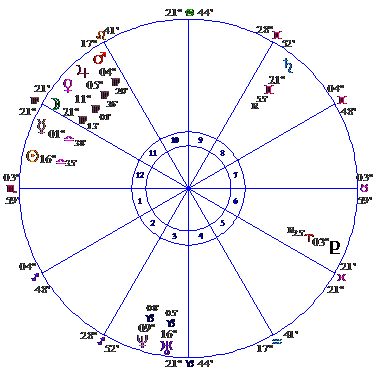
SJ Paul Kruger – Boer President

The chart-data – with no time, date or place of birth - was presented in 1001 Notable Nativities - #172. Alan Leo noted: spec hor by Kymry. The birth data is: October 10, 1825 at 6.20am LMT: near Cradock, South Africa (32S08; 25E36). It has a C rating. The Sun was at 16 Libra 35 – in the second decanate – and CC Zain commented: SJ Paul Kruger, Boer President, who struggled valiantly for the liberty of his people had his Individuality in this decanate.
Stephanus Johannes Paulus Kruger gained international renown as the face of Boer resistance against the British during the Second Boer War (1899-1902). He was raised in the borderland between civilization and barbarism and received little formal education. Then in 1877 – at the age of 55 - following the annexation of the Transvaal by Britain, Kruger became the leader of the resistance movement and on December 30, 1880 was elected President of the Transvaal. Over the next twenty years he 'struggled valiantly for the liberty of his people'. The struggle reached a tipping point on October 11, 1899 when the Second Boer War broke out and in October 1900 - as the British advanced on Pretoria – he left South Africa for Europe – an exile. Kruger, who claimed to have read only one book – the Bible – and who believed the Earth is flat, died in Switzerland on July 14, 1904.
Libra – second decanate Moon
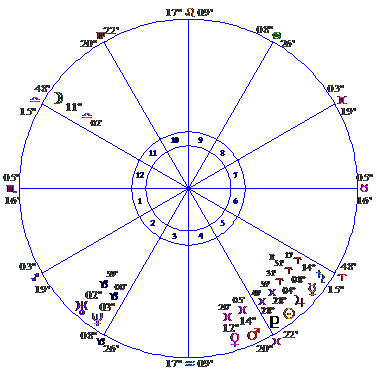
Magi Zariel – astrologer

No biographical references for Magi Zariel could be found and his birth data is unknown. It can only be presumed that the Moon was in the second decanate of Libra so CC Zain commented: Magi Zariel, largely responsible for founding the National Astrological Society, and for 25 years editor of its official organ, 'Prophecy', was born with his Mentality polarized in this place.
Sir Richard Burton – see page 156 – also had the Moon in the second decanate of Libra, but CC Zain focused on the Pisces influence in his chart rather than the Libra. He's had a data update and this chart is calculated for the data he gave in his autobiography. The 9.30pm birth time won't be exact - it could have a plus or minute 7 minute margin of error.
The second decanate of Libra pictures originality, independence and liberty and with the Moon there Sir Richard Burton's independent mentality was inclined to attract conflict, opposition and enmity - which he felt compelled to attack and destroy. He needed the freedom to write and travel, but his books on Eastern erotica were not well received. Mercury – the writing and travel planet – in the 5th house (sex) dominated his chart, but its opposition aspect to the Moon in the 11th house attracted criticism and controversy.
Libra – second decanate Ascendant
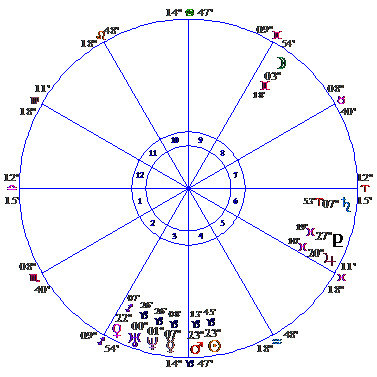
W H Chaney – astrologer

The chart-data – with no time, date or place of birth - was presented in 1001 Notable Nativities - #011. Alan Leo noted: 'Author of Chaney's Primer of Astrology'. The birth data is: January 13, 1821 at 11.31pm LMT; Chesterville, ME (44N30; 70W05). It's from him and has an A rating. The ascendant was in 12 Libra 15 – in the second decanate – and CC Zain commented: And WH Chaney, author of 'Primer of Astrology', who fought energetically in defense of astro-science, was born with this part of the heavens on the ascendant.
WH Chaney was an American astrologer, linguist and scholar. In his youth he had aspirations of becoming a pirate and 1839 – age 19 - he joined, but later deserted, the navy. Then, in 1866, he was commissioned to write an anti-astrology book but during his research became convinced that astrology was in fact a true science. Later that year – in October - Luke Broughton - see page 57 - employed him as his assistant. This commenced a career as an astrologer, teacher and lecturer. In 1877 he began work on a 77 year Ephemerides and in 1890 – at the age of 69 - wrote and published Chaney's Primer of Astrology and American Urania. This text followed the ancient teachings and placed great emphasis on major progressions, which he called primary directions. Chaney died on January 6, 1903 – aged 82.
The Third Decanate of Libra – sub-ruler Mercury
The astrological message
The last decanate of Libra is not less given to contact with people than the other two. Neither is the mind less keen. In fact, it is often superior, especially where literature and art are concerned. But as it is the decanate in the sign of partnership and open enemies next to the sign of death, Scorpio, there is sometimes a peculiar fatality associated with it.
This fact is pictured in the sky by the constellation LUPUS – the Wolf. This original of the wolf in sheep's clothing is represented as impaled on the spear of Centaurus. And as designed it indicates the almost certain fate of those born under this portion of the sky who transgress either the laws of man or the laws of God. Due to the brilliancy of their minds they sometimes use their talents to enslave their fellowman and keep him in ignorance and poverty that they may profit thereby. But when they live straight forward moral lives and do not fall into corruption, they rise to positions of power and usefulness, and no tragedy overtakes them.
It is the decanate of EXPIATION
Expiation is the act of making atonement for a misdemeanor – the means by which reparation is made for a misdeed, wrong-doing, transgression, infraction, infringement or crime.
Libra – third decanate Sun
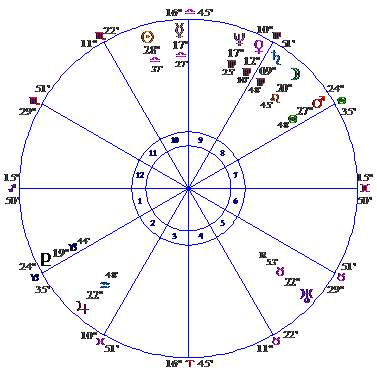
Samuel Taylor Coleridge – poet

The chart-data – with no time, date or place of birth - was presented in 1001 Notable Nativities - #101. Alan Leo noted: The poet – b. 21.10.1772. The birth data is: October 21, 1772 at 11.00am LMT: Ottery St, Mary, England (50N45; 3W17). The (10th house) Sun was at 28 Libra 37 – in the third decanate – and CC Zain commented: Samuel Taylor Coleridge, the poet, who became a victim of opiates, was born with his Sun here. But there's a birth time update which doesn't affect the Sun's decanate position. Arthur Blackwell gives 11.00am LAT – quoting 'Table Talk by SS Coleridge' – and this converts to 10.45am LMT. It has a B rating.
Samuel Taylor Coleridge was an English poet, romantic critic and philosopher. He was one of the founders of the Romantic Movement and one of the Lake Poets, but throughout his adult life suffered crippling bouts of depression, anxiety and neuralgia. He chose to treat his mental health problems with opium and became a full-blown addict in 1807-1808 - consuming as much as two quarts of laudanum a week. His best known works are: The Rime of the Ancient Mariner, Kubla Khan and Biographia Literaria. He died in Highgate, London on July 25, 1834 – aged 61. Some commentators now suggest that Coleridge suffered from bi-polar disorder.
Libra – third decanate Moon
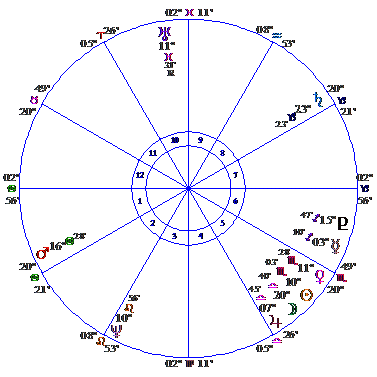
Marie Antoinette – Queen of France

The chart-data – with no time, date or place of birth - was presented in 1001 Notable Nativities - #694. The birth data is: November 2, 1755 at 7.30pm LMT: Vienna, Austria (48N13; 16E20). Astro Databank gives the data an A rating and notes that 'NN No694 used 8.00pm LMT' - which is incorrect. The Moon was in 20 Libra 40 – in the third decanate – and CC Zain commented: Marie Antoinette, who was accused of extravagance and profligacy and so was beheaded, was born when the Moon was in this section of the sky.
Marie Antoinette was an Archduchess of Austria and the Queen of France and Navarre. On May 16, 1770 she married Louis Auguste and became Dauphine of France - and then, when he husband ascended the throne in May 1774, she assumed the title of Queen of France and Navarre. But, as a silly and frivolous eighteen year-old, she was totally unfit to be queen. Her talent for extravagance and disregard of convention quickly developed a bad reputation and (some claim) her unpopularity with the people and lack of perception eventually resulted in the French Revolution – a people's uprising that brought down the French monarchy. In the end she was imprisoned like a common criminal, suffered from tuberculosis and on October 16, 1793 - at the age of 37 - was tried for treason and beheaded.
Libra – third decanate ascendant
Henry 1V – King of France

This is (probably) an incorrect decanate reference. The chart-data – with no time or place of birth - was presented in 1001 Notable Nativities - #573 and #574. Alan Leo noted: 'Henry of Navarre'; b. 13.12.1553 (Chart #573) and 'according to Gadbury CG (Collectio Geniturarum) 34 (Chart #574). The two charts are different, which means they are drawn up for different dates and times: And while Leo specified December 13, 1553 - chart #573 - the chart-data is for December 14, 1553 – so it's all a bit of a mess. The birth data for chart #573, which has 24 Libra on the ascendant – in the third decanate - is: December 14, 1553 at 2.08am LMT; Pau, Paris (48N52; 2E20): And CC Zain commented: And Henry 1V, king of France, who led a stormy life and was finally assassinated, had this decanate on his ascendant. But there's a big problem with the birth date and two birth times.
Edwin Steinbrecher – quoting JM Harvey CA 86 – gives 1.30am LMT on December 24, 1553 New Style, which means the birth date was December 14, 1556 Old Style. But some websites on the Internet give December 13 and others give December 14 and none specify if the date is Old Style of New. But as it's an ascendant decanate reference its validity depends upon the accuracy of the birth time, which would have been recorded in Local Apparent Time, not Local Mean Time: And at 1.30am LMT the second decanate of Libra was rising. Steinbrecher gives the Harvey data a C rating – original source not known, caution required – so it's all very uncertain. The Old Style – New Style problem highlights the importance of clearly identifying the original birth data and then documenting the birth date adjustments that have been made.
Henry 1V was King of France from 1589 to 1610, but before this – on June 9, 1572 - he became King Henry 111 of Navarre and two months later - on August 19 – he married Marguerite de Valois. He'd been baptized a Roman Catholic - raised a Protestant - and as a teenager joined the Protestant forces in the French Wars of Religion – and so his accession to the French throne on August 2, 1589 caused a religious dilemma which he resolved by converting to Catholicism. As king he restored peace and strong government – showed remarkable religious tolerance - brought back prosperity by measures that promoted industry and agriculture - and improved communications. Under Henry Paris became great again. He was one of the country's most popular rulers - ever - but you can't please everyone and he was assassinated by a Catholic extremist who stabbed him to death on May 14, 1610. He was 53.

The Scorpio Decanates
The First Decanate of Scorpio – sub-rulers Mars and Pluto
The astrological message
OPHIUCHUS – the man who wrestles with a serpent – is the constellation, picturing in the sky the sex-decanate of the sex-sign Scorpio. He typifies the struggle of man with his animal desires. And even as in the Biblical story of Jacob wrestling with the angel – which is but one version of this starry struggle – he who is victorious is always greatly blessed.
So we find people born under this decanate with the strongest sex impulses. There is an excess of creative energy which goads them to desire and action. They thus have an abundant vital magnetism, which they impart to others, giving a natural ability to heal. It also stimulates the mind to creative imagination. Therefore, when they turn from sensualism and direct their forces to constructive work they have a wonderful fertility of ideas and are capable of leading the strenuous life to its maximum. Not through suppression can they overcome the serpent, but through the guidance of the surplus energy into proper channels.
It is the decanate of RESOURCEFULNESS
Resourcefulness is the skilful overcoming of difficulties – the capacity to meet and confront situations with practical ingenuity and a rich repertoire of mental and emotional resources.
Scorpio – first decanate Sun
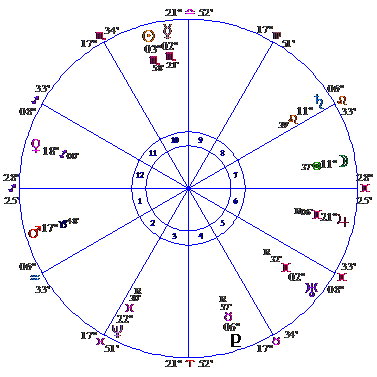
Theodore Roosevelt – US President

The chart-data – with no time, date or place of birth - was presented in 1001 Notable Nativities - #933. Alan Leo notes spec hor. The birth data is: October 27, 1858 at 10.58am LMT: New York, NY (40N42; 74W00). The (10th house) Sun was at 3 Scorpio 58 – in the first decanate – and CC Zain commented: The Sun was in this portion of the zodiac at the birth of the versatile and resourceful Theodore Roosevelt, who became president of the United States.
The source of the 10.58am birth time is not known and it's claimed that Roosevelt used a chart timed for 11.45am: But in 1959 – with the publication of Roosevelt's biography 'The Life and Times of Theodore Roosevelt' by Stefan Lorent – a new birth time surfaced – which doesn't affect the Sun's decanate position. The book gives 'a quarter to eight in the evening' - 7.45pm LMT - quoting a letter written by Roosevelt's maternal grandmother, Mrs Bullock, who assisted at the birth. This new chart has 24 Gemini 36 on the ascendant and it is interesting to note that CC Zain described Roosevelt as versatile (Gemini) and resourceful (Scorpio). Roosevelt's role in shaping America is still unfolding and Time, in July 2006, in its 5th Annual Special – The Making of America – paid tribute to the 'locomotive President' and how he lead his flourishing nation into the future and invented modern America.
Scorpio – first decanate Moon
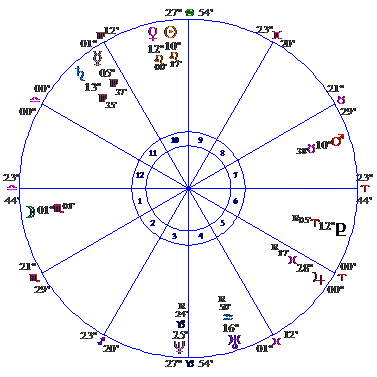
Henry Steel Olcott – co-founder of the Theosophical Society

This is an uncertain decanate reference. The chart-data – with no time, date or place of birth - was presented in 1001 Notable Nativities - #041. Alan Leo note: spec hor by Sepharial – time uncertain and not known to the minute. It has a C rating. The birth data is August 2, 1832 at 11.15am LMT: Orange NJ (40N46; 74W13). The (1st house) Moon was in 1 Scorpio 01 – in the first decanate – and CC Zain commented: Henry Steele Olcott, president-founder of the Theosophical Society, and a man of refined creative genius, was born with his Mentality here. But if the birth occurred before 9.22am the Moon was in the third decanate of Libra.
Henry Steel Olcott was an American military officer, journalist, lawyer and co-founder and first President of the Theosophical Society. He was educated at the College of the City of New York and Colombia University – worked as the agricultural correspondent for the New York Tribune from 1858 to 1860 - married in 1860 - served in the US army during the Civil War – and became a lawyer specializing in insurance and fraud in 1868. Then in 1874 he became interested in spiritualism and met Helena Blavatsky. The Theosophical Society's inaugural meeting was held on November 17, 1875 and he was the organization's President from then until his death on February 17, 1907.
Scorpio – first decanate Ascendant
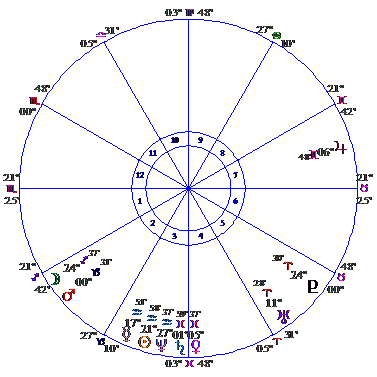
Thomas A Edison – inventor

This is a very uncertain decanate reference. The chart-data – with no time, date or place of birth - was presented in 1001 Notable Nativities - #101. In Astrology Magazine Alan Leo stated that the time came from Edison's father in 1878. The birth data is: February 11, 1847 at 11.33pm LMT; Milan OH (41N17; 82W36). The ascendant was in 5 Scorpio 13 - in the first decanate – and CC Zain commented: And the most resourceful and prolific inventor of all times, Thos. A Edison, was born with this part of the heavens on the ascendant. But this depends upon a precise birth time – and there isn't one. A chart timed for 11.38pm LMT is presented on page 258 of Brotherhood of Light Course 11, but most other references give early am.
It's generally believed that the birth occurred in the early morning - on a cold wintry day, following a night of heavy snowfall- and Edison's daughter states that her dad was probably born between 1.00 and 2.00am. Alfred Powell Morgan in The Pageant of Electricity was a little more specific: 'Thus it was in the midst of a blizzard at three o'clock in the morning of February 11 that Samuel Edison became the father of a sturdy boy'. At 1.00am 21 Scorpio was on the ascendant and between 2.00 and 3.00am Sagittarius was rising. With several birth times the data is rated dirty.
The Second Decanate of Scorpio – sub-rulers Jupiter and Neptune
The astrological message
ARA – the altar – rising from which is seen the smoke of burnt offerings, pictures in the heavens the Pisces-decanate of Scorpio. Here we find the self-centeredness and aggression of Mars, the ruler of Scorpio (see note), somewhat modified by the restrictions of Pisces. All the desire for expression is present, but usually there comes a time in the life when mere personal gratification must be sacrificed on the altar of devotion to the sense of duty.
Those born here are usually strong characters, either in good or in evil. They have varied passions and abundant animal force. Then comes the time when they are called upon – even as were Cain and Abel – to sacrifice the animal part of themselves. Some, like Cain, refuse to do this and endeavor to buy favour from the Law with the fruits of the earth. But others, rising to the occasion, attain to truly spiritual heights. Those born here find themselves called upon to fill positions of importance, if they do not shirk. And the successful completion of one duty ever leads on to advancement. But the animal needs to be guarded well. (Note that this was written in 1922 before the discovery of Pluto and that Mars and Pluto are the co-rulers of Scorpio.)
It is the decanate of RESPONSIBILITY
Responsibility is the act of being responsible or the state of being in a position of responsibility. It can be a task, burden function, duty, obligation or trust.
Scorpio – second decanate Sun
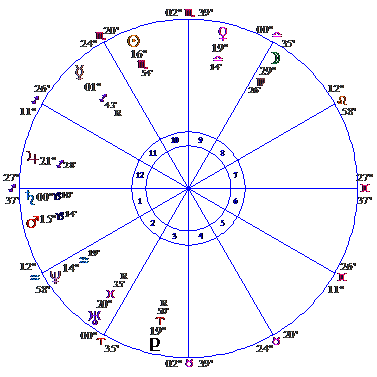
King Edward V11 – British monarch

The chart-data – with no time, date or place of birth - was presented in 1001 Notable Nativities - #002. The birth data is: November 9, 1841 at 10.48am LMT: Buckingham Palace (51N30; 00W08). The birth time - from an official Palace announcement – has a AA rating. The (10th house) Sun was at 16 Scorpio 54 – in the second decanate – and CC Zain commented: King Edward V11, who dutifully carried the weight of Great Britain's rulership, was born with his Individuality in this decanate.
Edward V11 was king of the United Kingdom and the British Dominions from January 22, 1901 until his death on May 6, 1910. He was the eldest son of Queen Victoria and Prince Albert and while his education was designed to prepare him for the throne he did not excel academically. Charm, sociability, genial good humor and tact were his natural talents. In 1860 he toured North America and on March 10, 1863 married Princess Alexandra of Denmark. They had six children – and he had many mistresses. His coronation – held on August 9, 1902 - was originally scheduled for June 26, 1902, but on June 22 he was diagnosed with appendicitis. As king, Edward's main interests were in foreign affairs and naval and military matters, but he tended to overrate his political influence. He died aged 68 after suffering several heart attacks.
Scorpio – second decanate Moon
John Heydon – astrologer and occult philosopher

The chart-data – with no time, date or place of birth - was presented in 1001 Notable Nativities - #582. Alan Leo noted: Astrologer (author of the Temple of Wisdom) ; b. 10.9.1629 – CG (Collectio Geniturarum, by John Gadbury) 136.The birth data is September 10, 1629 OS – September 20 NS – at 9.45pm LMT: London, England (51N30; 00W08). The (6th house) Moon was in 18 Scorpio – in the second decanate – and CC Zain commented: John Heydon, who wrote the 'Temple of Wisdom' and felt it his duty to promote the cause of astrology, was born with his Mentality here. But there's a birth time update from Edwin Steinbrecher, which doesn't affect the Moon's decanate position. Koppejans quotes Manoah Sibly for 9.52pm LMT. It gets a C rating. Due to the birth year – 1629 - no chart can be presented.
John Heydon was a Neoplatonist occult philosopher and Rosicrucian who during the last twelve years of his life published a remarkable number of abstruse works on various aspects of philosophy and the occult. And by all accounts - with the Moon in Scorpio - he was a rather troublesome fellow.
His family background seems to have been an important personal issue and while he was born and raised in London – with mum, dad and a younger sister – his English Physicians Guide published in 1662 relates a colorful past claiming that he was descended from a King of Hungary. He was tutored in Latin and Greek and apprenticed to study law. As a young man – during the English Civil War - he served in the royalist armies and then traveled to Italy, Spain, Egypt, Arabia and Persia. He married in 1656 and from then on devoted himself to his occult and astrological interests. He wrote: A New Method of Rosie Crucian Physick...(1658), The Harmony of the World (1662), Theomagia, or the Temple of Wisdom in three parts (1662/4) and The English Physician's Tutor (1665).
But trouble was never very far away. His royalist friends had him imprisoned when he predicted the death of Oliver Cromwell: And he was back behind bars in 1663 for dealing in suspect (treasonous) literature. Then – in 1664 - for debt problems - and in 1667 for his role in a treasonous plot – this time in the Tower of London. He was also accused of plagiarizing Sir Thomas Brown and Thomas Vaughan and it's claimed that his Physicians Guide of 1662 largely derives from Sir Francis Bacon's The New Atlantis. Heydon had a short but eventful life and Francis Yates described him as a 'strange character...an astrologer, geomancer, alchemist, of a most extreme kind'. He died in 1667 – aged 38.
Scorpio – second decanate Ascendant
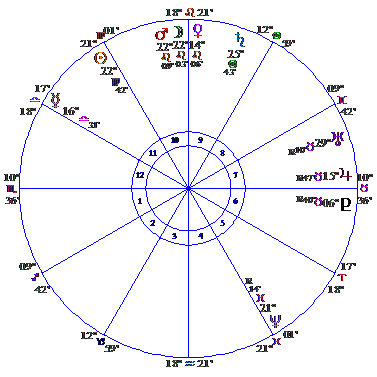
William Howard Taft – judge

This is an incorrect decanate reference. The chart – for a speculative time - can be sighted in Horoscopes of the US Presidents by Doris Chase Doane, and Sabian Symbol #886 gives the chart data: September 15, 1857 at 9.46am; Cincinnati OH (39N09; 84W27). The ascendant was at 10 Scorpio 48 – in the second decanate – and CC Zain commented: And Wm. Howard Taft, the only man whose duty led him to the highest office in both the executive and judicial branches of the US Government, was born with his Personality polarized in this section of the sky: But it wasn't. Astro Databank quotes Frances McEvoy for 8.00pm - from a member of Taft's family by marriage - and gives it an A rating. It won't be precise.
It puts 9 Taurus 44 – the first decanate of Taurus - on the ascendant. This is the decanate of determination and with Pluto conjunction the ascendant determination was a prominent feature of Taft's personality: And with the Moon conjunction Mars in the third decanate of Leo he had an ambitious Mentality. Jupiter was the dominant planet and Taft had a distinguished legal career. He served as US circuit Court Judge and Chief Justice of the US Supreme Court – appointed June 30, 1921 – and died at his Washington home on March 8, 1930.
The Third Decanate of Scorpio – sub-ruler Moon
The astrological message
Unlike the crown of spikes that pictures the last decanate of Virgo, CORONA AUSTRALIS – the Southern Crown – is the laurel crown of victory. Picturing among the constellations the Cancer-decanate of Scorpio, it reveals the potency of sex when sublimated to carry the soul to the loftiest summit of physical and mental achievement.
Adjacent to the religious sign Sagittarius, and under the sub-influence of the sign of domestic life, Cancer, those born here have intense emotions and vivid ideas. When the spirit of chivalry is developed and they sense their value to country and home they are capable of lofty effort. But for the greatest success it seems essential that they have some person of the opposite sex to stimulate their ambitions and ideals, and for whom they strive to make a success of life. Social life, therefore, is always an important factor contributing to or detracting from their usefulness to society.
It is the decanate of ATTAINMENT
Attainment is the act of reaching, gaining, obtaining, earning or acquiring a purpose, goal or proficiency. High-level personal achievement requires skill, bravery and industrious effort.
Scorpio – third decanate Sun
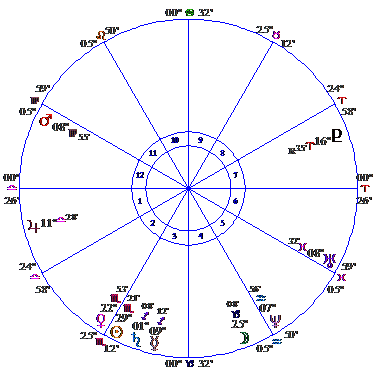
Franz Hartmann – occult writer

The chart-data – with no time, date or place of birth - was presented in 1001 Notable Nativities - #066. Alan Leo gave the birth data in the June 1896 edition of Modern Astrology: November 22, 1838 at 2.00am LMT: Donauworth, Bavaria (48N43; 10E46). The (3rd house) Sun was in 29 Scorpio 21 - in the third decanate – and CC Zain commented: Franz Hartmann, who wrote 'Life of Paracelsus', 'Magic White and Black', and achieved other success along occult lines, was born with the Sun in this decanate. But in the October 1912 edition of Modern Astrology Hartman was quoted for a time of 2.30pm, which influenced the chart's layout but not the Sun's decanate position. This time has an A rating.
Franz Hartmann was a German physician, occultist, astrologer and author – and a prominent member of the Theosophical Society in its early days. He was a prolific writer – Mercury dominates the 2.30pm chart and is cusp ruler of the third house – and along with the books mentioned by CC Zain wrote Occult Science in Medicine and a biography of Jakob Bohme. He was also the editor of the journal, Lotusbluten, and translated the Bhagavad Gita into German. He worked alongside Madame Blavatsky at Adyar and in 1896 founded the German Theosophical Society. His physical demise occurred on August 7, 1912 – aged 73.
Scorpio – third decanate Moon
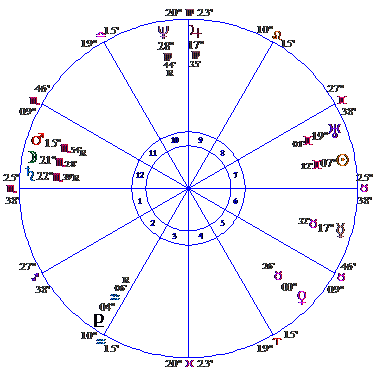
Thomas Moore – poet

This is an uncertain decanate reference. The chart-data – with no time, date or place of birth - was presented in 1001 Notable Nativities - #705. Alan Leo specified (ta) – time approximate. The birth data is: May 28, 1779 at 7.00pm: Dublin, Ireland (53N20; 6W15). It has a C rating. The (12th house) Moon was in 21 Scorpio 28 – in the third decanate - and CC Zain commented: Thomas Moore, whose social grace and patriotism were second only to his achievements as a poet, had his mentality here. But the Moon moved to the third decanate of Scorpio at 4.10pm – less than three hours before the given birth time - so its decanate position is not 100% certain.
Thomas Moore was an Irish poet, singer, songwriter and entertainer – Ireland's National Bard. He was educated at Trinity College - studied law at the Middle Temple in London - and found success as a poet, balladeer, singer and society figure. He earned large sums of money but had expensive tastes and this extravagance problem (Jupiter) resulted in a bigger debt problem (Saturn) and 1819 he was forced to leave Britain to live in Paris. He married Elizabeth Dyke in 1811 and the untimely deaths of his five children were a tragic personal loss. Moore's most notable works are The Minstrel Boy and The Last Rose of Summer. He died on February 25, 1852 – aged 72.
Scorpio – third decanate ascendant
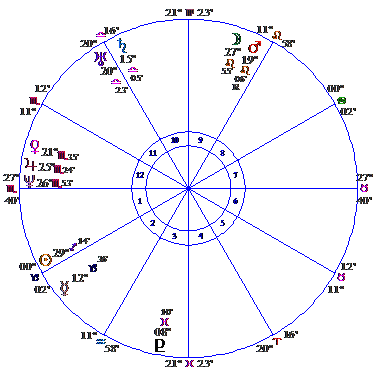
Benjamin Disraeli – British Prime Minister

The chart-data – with no time, date or place of birth - was presented in 1001 Notable Nativities - #737. The birth data is: December 21, 1804 at 5.30am; London, England (51N30; 0W10). It comes from family records and gets a AA rating. The ascendant was at 27 Scorpio 40 – in the third decanate - and CC Zain commented: And the chivalrous Benjamine Disraeli, who became Prime Minister of England, was born with this part of the zodiac on his ascendant.
Benjamine Disraeli was a British Prime Minister, parliamentarian, Conservative statesman and novelist who played an instrumental role in the creation of the modern Conservative Party in England. After a period in a solicitor's office – his father groomed him for a career in law - Disraeli wrote novels - Vivian Grey, Sybil and Contarini Fleming are the best known - and in 1837 he entered parliament. He was Chancellor of the Exchequer – 1842, 1858-59 and 1866-69 – and Prime Minister – from February 27, 1868 to December 1, 1868 – and February 20, 1874 to April 21, 1880. He and his political adversary – the liberal William Ewart Gladstone - see page 89 – dominated British politics for 25 years. Disraeli died in London on April 19, 1881 – aged 76.

The Sagittarius Decanates
The First Decanate of Sagittarius – sub-ruler Jupiter
The astrological message
The Harp of Seven Strings – LYRA – such a harp as David played upon to soothe the spirit of King Saul, pictures the Jupiter-decanate of Sagittarius. The constellated instrument portrays the soul which places itself 'In tune with the Infinite' and becomes responsive to the thoughts radiated by the Cosmic Mind.
Those born under this influence, when true to themselves, are the most religious of all and are capable of attaining Cosmic Consciousness. But their religion need not be tinctured with orthodoxy, and is often most expressed through their kinship with Nature and their love and sympathy for all living creatures. They live at their best, and accomplish most, when they constantly feel the abiding presence of the Cosmic Intelligence and place implicit trust in Its guidance. They then feel impressed to fill a definite mission, and if they follow the dictates of the 'Inner Voice' they seldom err in judgement. But either in matters of spiritual progress or in mere worldly matters, they must rely upon their own judgement, for when they take the advice of others they most signally fail.
It is the decanate of DEVOTION
Devotion is earnest dedication or attachment or giving yourself over to a cause, person or pursuit. It's the zealous or exclusive application of the thoughts and energies to a cause.
Sagittarius – first decanate Sun
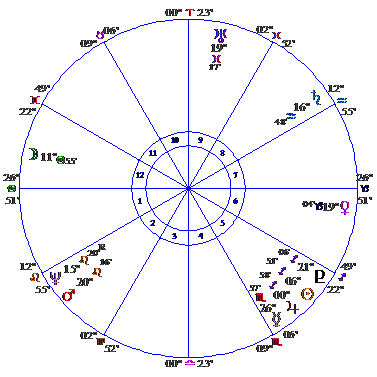
William Blake – poet and painter

The chart-data – with no time, date or place of birth - was presented in 1001 Notable Nativities - #195. Alan Leo noted: taken from Arthur Symon's Life of Blake (originally from Urania No.1, 1825.) The birth data is: November 28, 1757 at 7.30pm LMT; London, England (51N30; 0W10). The (5th house) Sun was in 6 Sagittarius 51 – in the first decanate – and CC Zain commented: William Blake, poet and painter, author of 'Books of Prophecy' and designer of illustrations to 'The Book of Job' was born with his Individuality here. But there's a birth time update that doesn't affect the Sun's decanate position. Astro Databank gives 7.45pm - from Steinbrecher who quotes Blake's friend Varley. It has an A rating.
William Blake was an English poet, artist, engraver and visionary - a seminal figure in the history of the poetry and visual arts of the Romantic Age. He was largely unrecognized during his lifetime, but is now acclaimed for his expressiveness and creativity – particularly the philosophical and mystical undercurrents which permeate his work. In his 'prophetic books' - which include The Marriage of Heaven and Hell (1790) - he created a vast personal mythology – and he illustrated his own works with hand-colored engravings. He died on August 12, 1827 - aged 69 - and it took a little while for the true nature of his genius to be recognized.
Sagittarius – first decanate Moon
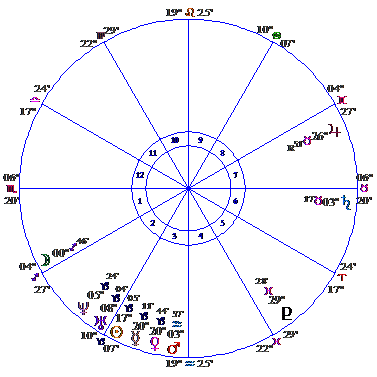
Alfred Russell Wallace – scientist

The chart-data – with no time, date or place of birth - was presented in 1001 Notable Nativities - #302. The birth data is: January 8, 1823 at 2.20am: near Usk, Wales ( 51N36; 2W58). The (1st house) Moon was in 00 Sagittarius 46 – in the first decanate - and CC Zain commented: Dr. Alfred Russell Wallace, whose research led him independently to the theory of evolution so ably expounded by Darwin, and who was famous as a naturalist, and who embraced the cause of spiritualism in spite of the ridicule of his contemporary scientists, was born with his Mentality in this decanate. But there's a birth time correction that doesn't affect the Moon's decanate position. Astro Databank quotes Bailey for 2.30am - from him - and gives it an A rating.
Alfred Russel Wallace was a British naturalist, anthropologist and biologist who is best known for his independent proposal of a theory of natural selection - similar to the one proposed by Charles Darwin - and his social activism – he raised concerns over the environmental impact of human activity. But with mystical Neptune a prominent feature of his astrological profile he was strongly attracted to unconventional ideas and his advocacy of spiritualism and his belief in a non-material origin for the higher mental faculties of humans strained his relationship with the scientific establishment. He died on November 7, 1913.
Sagittarius – first decanate Ascendant
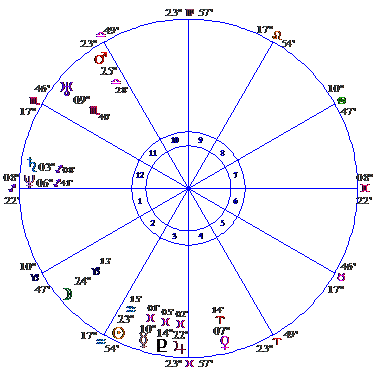
Abraham Lincoln – US president

This is an incorrect decanate reference. The birth data for the chart presented on page 68 of Brotherhood of Light Course X-1 - Delineating the Horoscope - is: February 12, 1809 at 2.10am; 86W, 37N (Hodgenville, Kentucky) - time not recorded – rectified to 2.10am. The ascendant was in 8 Sagittarius – in the first decanate – and CC Zain commented: And Abraham Lincoln, man of destiny, deeply religious and the instrument through whom human slavery was abolished in America, was born with his Personality under this section of the sky. But in the original (1922) version of Delineating the Horoscope - Natal Astrology (Hermetic System) – the author had written: 'In the chart of Abraham Lincoln, however, (see frontispiece) we also have Sagittarius rising....If this chart is precise'......and CC Zain's reservation regarding the chart was well warranted. The chart is incorrect – there was no progressed aspect to the ruler of the 8th house at the time of Lincoln's death. But there is a birth time for Lincoln which was given in the book Women Lincoln Loved by William E Barton who quotes the 'granny-women' midwife, Peggy Walters – 'the baby was born just about sun-up' – which occurred at 6.57am. This puts the Sun and ascendant in the third decanate of Aquarius – the decanate of repression. This - 'sun-up' - birth time comes from a biography so it gets a B rating.
The Second Decanate of Sagittarius – sub-ruler Mars
The astrological message
The Eagle – AQUILA – symbol of transmuted sex, and the power of the higher mind to make lofty flights through the rare atmosphere of the spiritual world, pictures among the constellations the Aries-decanate of Sagittarius.
The migratory instincts of Sagittarius are given a trend toward pioneering. Consequently, we find people born here to be unusually successful in searching out new fields of endeavor, physical, mental and spiritual. They are usually restless. Their minds are constantly alert for new facts. And in order that they shall not become discontented it is very essential that they have at all times some definite work to accomplish, and that this work is of a nature to be well worth their best efforts. Confinement and restriction are most depressing to these people, and if forced to be idle or follow some uncongenial occupation they become rebellious and hypercritical. They require some task of importance to call out their wonderful executive ability.
It is the decanate of EXPLORATION
Exploration is the act of exploring a country or place: Or the investigation or close examination of an unknown – physical, mental or spiritual – region.
Neptune – planet of idealism - is exalted in the 18th degree of Sagittarius
Sagittarius – second decanate Sun
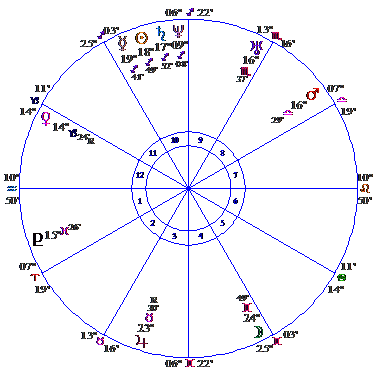
Alfred de Musset - poet, playwright and novelist

The chart-data – with no time, date or place of birth - was presented in 1001 Notable Nativities - #947. The birth data is: December 11, 1810 at 11.00am; Paris, France (48N52; 2E20). Gauquelin quotes the birth record so it gets a AA rating. The (10th house) Sun was in 18 Sagittarius 49 – in the second decanate - and CC Zain commented: Alfred de Musset, whose searching mind grasped the merits of both the classic and the romantic schools and welded them into a system of his own, becoming famous as a poet, playwright and novelist, was born when the Sun was here.
Alfred Louis Charles de Musset-Pathay was a French dramatist, poet and novelist. He first tried careers in medicine, law, drawing, English and piano, but when his interest turned to poetry he became one of the first Romantic writers – and a literary star by the age of 20. He received the Legion d'honneur on April 24, 1845 and in 1852 was elected to the Academie francaise. His autobiographical novel – The Confessions of a Child of the Age – traces the emotional upheaval of his two year love affair with George Sand – see page 25 - who became the inspiration for many of his poems. Musset died in his sleep on May 2, 1857 – aged 47. The cause was heart failure due to alcoholism and a long standing aortic insufficiency.
Sagittarius – second decanate Moon
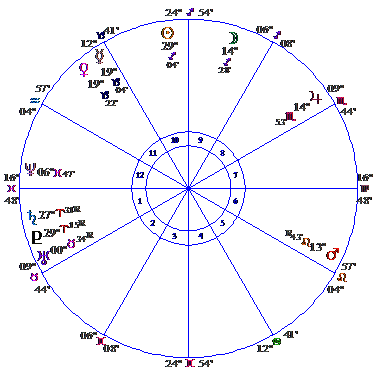
Alice Le Plongeon – amateur archaeologist

The chart-data – with no time, date or place of birth - was presented in 1001 Notable Nativities - #975. Alan Leo noted: 'from a private source' – and there are no other data references. The birth data is: December 21, 1851 at 11.40am; London, England (51N30; 00W06). It has a C rating. The (9th house) Moon was in 14 Sagittarius 28 – in the second decanate – and CC Zain commented: Alice Le Plongeon, author, and co-worker with her husband in his explorations among the ruins of Yucatan, was born with her Mentality under this decanate.
Alice Dixon Le Plongeon was an English photographer, amateur archaeologist and traveler who spent 11 years living and working in southern Mexico and Central America with her husband Augustus Le Plongeon – see page 21. Together they developed spectacular theories concerning the origins of the Maya - but these are now discounted by modern day scholars. Alice was also active in the Theosophical Society and a friend of Annie Besant – see page 22 – and her epic poem, A Dream of Atlantis (1909), was published in the Theosophy serial The Word Magazine. She died in 1919 and is remembered for her documentation and recording of monuments and inscriptions at several Maya sites.
Sagittarius – second decanate Ascendant
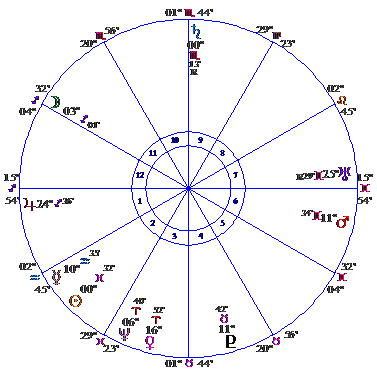
Sven Hedin – geographical explorer

This was the only birthchart presented in 1001 Notable Nativities - #1001. Alan Leo noted 'private source'. The birth data is February 19, 1865 at 4.02am: Stockholm, Sweden (59N20; 18E03). Rodden gives it a C rating – original source not known. The ascendant was in 15 Sagittarius 54 – in the second decanate – and C Zain commented: And Dr Sven Hedin, the great geographical explorer, had this section of the zodiac on his ascendant.
Sven Anders Hedin was a Swedish geographer, topographer, explorer, photographer and travel writer who wrote more than 30 books. When he was 15 Hedin witnessed the triumphal return of the Arctic explorer Adolf Erik Nordenskold to Stockholm and from that moment on he was inspired to become an explorer. So he studied under the German geographer and China expert, Ferdinand Freiherr von Richthofen, and in four expeditions to Central Asia discovered the Transhimalaya – Lake Lop Nur - the sources of the Brahmaputra, Indus and Sutlej Rivers – and, in the deserts of the Tarim Basin, the remains of cities, grave sites and the Great wall of China. He detailed his explorations in Central Asia Atlas which was published posthumously. Hedin died in Stockholm on November 26 1952 – aged 86.
The Third Decanate of Sagittarius – sub-ruler Sun
The astrological message
The third decanate of Sagittarius, the Leo-decanate, is pictured among the constellations by SAGITTA – the Arrow. This is the arrow that Mithra shot against a rock and a stream of water immediately gushed forth. It symbolized the soul piercing the illusions of matter and through this comprehension of the meaning of incarnate existence being able to quench its thirst at the fountain of Divine Consciousness.
Those born under this decanate may either tread the path of pleasure, or climb the royal road to spiritual supremacy. Being the kingly section of the sign of the higher mind, when the sporting proclivities relating to the fifth sign's influence are transmuted, they have not only the ability to perceive things in their proper relation, but also to synthesize their observations and impart this knowledge to others. They, therefore, reach their greatest usefulness as teachers and leaders of philosophical and religious thought. And when faithful to their ideals and persistent in adhering to their own conceptions they reach the highest states of consciousness possible to embodied man.
It is the decanate of ILLUMINATION
Illumination is the act of becoming enlightened. It's a moment of intellectual or spiritual enlightenment involving insight, comprehension and wisdom. The state of true illumination permits the conscious awareness of your cosmic work.
Sagittarius – third decanate Sun
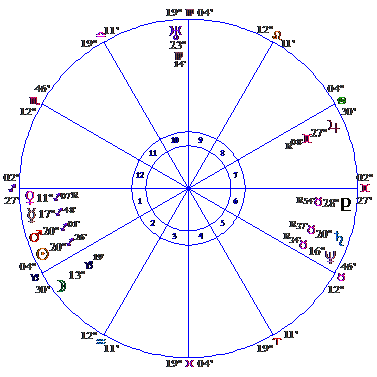
CC Zain - author of the Brotherhood of Light lessons

This chart is presented on page 66 of Brotherhood of Light Course 1 – The Laws of Occultism. The birth data – from Elbert Benjamine – is: December 12, 1882 at 5.55.26am: Adel, Iowa (41N37; 94W02). The data has a AA rating. The (1st house) Sun was in 20 Sagittarius 26 – in the third decanate – and CC Zain commented: CC Zain – pen name of Elbert Benjamine – author of all 210 Brotherhood of Light lessons, author of over a thousand magazine articles on astrology and occultism and one of the three founders of the Church of Light, was born when the Sun was here.
CC Zain – aka Elbert Benjamine – was the author of the Brotherhood of Light's home study courses on the occult sciences and co-founder of the Church of Light. He commenced his occult studies in 1898 and between March 1914 and February 1934 devoted his life to presenting – in lesson form - the Hermetic Philosophy of life. Blending the spiritual with the scientific he saw an astral 'soul' intelligence that was brought into existence to fulfill a definite cosmic function - and a God who reveals this function through the astrological chart of birth. Having completed his earthly mission he departed for the Summerland on November 18, 1951 – aged 68.
Sagittarius – third decanate Moon
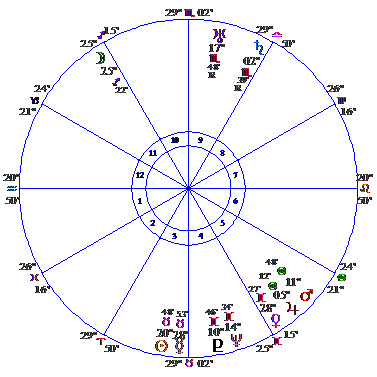
Krishnamurti – Head of the Order of the Star

The chart-data – with no time, date or place of birth - was presented in 1001 Notable Nativities - #864. Alan Leo quoted Krishnmurta's father and the same data is given in 'Krishnamurta, 100 Years' by Evelyn Blau. The birth data is: May 12, 1895 at 12.30am (Madras Time): Mandanapalle, India (13N33; 78E30). It has a B rating. The (11th house) Moon was in 25 Sagittarius 22 – in the third decanate - and CC Zain commented: Krishnamurta, head of the Order of the Star in the East, who refused to pose as an avatar, and author of 'At the Feet of the Master', was born when the Moon was in this section of the sky. 12.30am Madras Time converts to 12.23am LMT but this doesn't affect the Moon's decanate position.
Jiddu Krishnamurta was an East Indian spiritual teacher, philosopher and religious leader. Charles Leadbeater – see page 144 – claimed that in February 1909 he met Krishnamurti at the seaside and then Annie Besant adopted him and raised him as her own son - and the new Avatar. On January 11, 1911 she formed the Order of the Star with 16 year-old Krishnamurti as its official head. On December 28, 1925 he referred to himself as the Lord Matreya – acknowledging his great destiny - but on August 2, 1929 he publicly renounced his claim and broke with the Theosophical Society. He died on February 17, 1986 – aged 90.
Sagittarius – third decanate ascendant
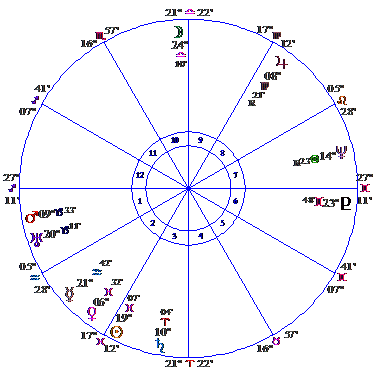
Maria M Benjamine – astrologer-writer

This chart is presented on page 291 of Brotherhood of Light Course X1V. The birth data (from her) is: March 10, 1909 at 2.00am CST: Chicago, Ill (41N50; 87W37). It has a AA rating. The ascendant was in 27 Sagittarius 11 – in the third decanate - and CC commented: And Maria M Benjamine, whose wifely sympathy and constant assistance contributed markedly to all the later work of CC Zain, and who worked vigorously and unselfishly to disseminate The Religion of the Stars, was born with this division of Sagittarius on the ascendant.
Maria Major was a writer of astrological articles and the third wife of Elbert Benjamine – CC Zain. She joined the Church of Light in 1934 and made her first trip to California in 1935. Then in the spring of 1936 she commenced writing astrological articles and over the next five years played a prominent role in presenting the Hermetic System of Astrology to the general public. In June 1942 she became a Hermetician and on May 31, 1943 married Elbert Benjamine. Over the next 7 years she corrected all Church of Light examinations. John E Daniel in his book - Astrology the Positive Approach - described her as gracious, helpful and unusually knowledgeable about astrology.

The Capricorn Decanates
The First Decanate of Capricorn – sub-ruler Saturn
The astrological message
CYGNUS – the Swan – speckless white, which with outspread pinions wings its way from the frozen north towards the sunny southern skies, pictures among the constellations the first decanate of Capricorn. It symbolizes the first news of a new order or things, a retreat from the crystallizing influence of materialism, and the harbinger of the approaching warmth of a spiritual spring.
So we find those born under this influence, when living at their best, to be forerunners of better conditions. They, better than any others, realize the value of system and organization to effect any worthwhile changes. And in business or in politics, both of which are spheres of activity to which they naturally gravitate, their greatest asset is in conciliating different factions and inducing them to join in some large merger which will operate more economically and efficiently than could any one faction alone. These people shoulder responsibility readily and become the managers of the world. To live at their highest they must be permitted to find expression for their talent of co-ordination.
It is the decanate of ORGANIZATION
Organization is a state of having things in order - or the act or process of systematically structuring, coordinating or restructuring an existing state of affairs to effect worthwhile improvement.
Capricorn – first decanate Sun
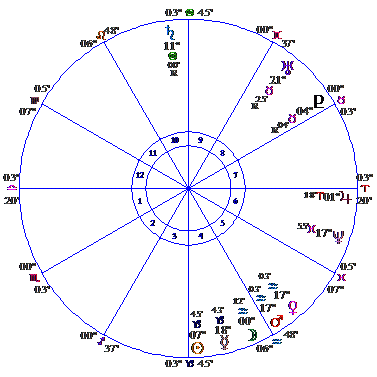
Woodrow Wilson – US President

This chart is not in 1001 Notable Nativities or the Brotherhood of Light lessons. It can be found in Horoscopes of US Presidents by DC Doane. The birth data is: December 28, 1856 at 11.45pm LMT: Staunton, VA (38N08; 79W04). The (4th house) Sun was in 7 Capricorn 45 – in the first decanate – and CC Zain commented: Woodrow Wilson, one-time president of the US, whose greatest effort was made toward effecting a 'League of Nations' was born with his Individuality here. But there's a date and time update that doesn't affect the Sun's decanate position. Arthur Blackwell quotes the Family Bible for December 29, 1856 at 12.45am LMT. It has a B rating.
Woodrow Wilson was an American politician and the country's 28th President - from 1913 – 1921. He married Ellen Axson on June 24, 1885 – was President of Princeton from 1902-1910 - entered politics in 1910 - and was elected governor of New Jersey in 1911. Then – as the Democrat candidate – he won the 1912 Presidential race defeating a divided Republican ticket – and was inaugurated on March 4, 1913. During World War 1 Wilson strove to keep the US neutral, but the German U-boat campaign forced him to declare war in 1917. In 1919 he was awarded the Nobel Peace Prize for his work as a founder of the League of Nations and suffered a stroke. He died on February 3, 1924 – aged 67.
Capricorn – first decanate Moon
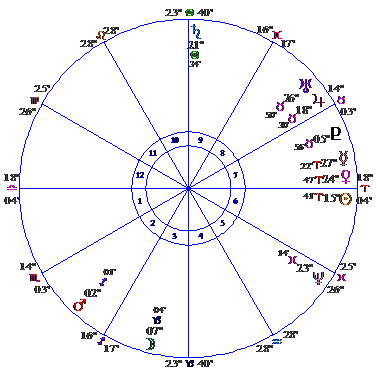
Bessie Leo – astrologer-writer

The chart-data – with no time, date or place of birth - was presented in 1001 Notable Nativities - #882. The birth data is: April 5, 1858 at 6.47pm LMT: Salisbury, England (51N05; 1W48). It has a C rating. Alan Leo rectified the time she gave. The Moon was in 7 Capricorn 04 – in the first decanate – and CC Zain commented: Bessie Leo, owner of 'Modern Astrology' and publisher of many books on astrology, was born with her Mentality in this decanate.
Ada Elizabeth Murray Phillips - Bessie Leo - was a phrenologist, astrologer and magazine editor. In 1892 she had her horoscope done by Alan Leo – see page 74 - in February 1893 she met modern astrology's rising star – and then she married and divorced another man before marrying her astrologer on September 23, 1895. She soon became deeply involved in her husband's astrology business – publishing books, writing articles for Modern Astrology and churning out cheap sun-sign horoscopes. (As a theosophist she had taken a vow of celibacy, but this was rarely practiced.) In 1909 and May 1911 she and her husband traveled to India - and in July 1917 Alan Leo was charged and fined with fortune telling. He died shortly after the trial and even though Bessie was suffering poor health she continued on as the editor of Modern Astrology until her death in 1931 – aged 73.
Capricorn – first decanate Ascendant
Marcus Tullius Cicero – orator and statesman

This is a very doubtful decanate reference. The chart-data – with no time or place, but two birth dates! – was presented in 1001 Notable Nativities - #149 and 438. Alan Leo noted: b. 3.1.106 BC; recalculated by Sepharial (Chart #149): And according to Cardan: b. 5.8.105 BC – but he wasn't - (Chart #438). The birth data (for chart #149) seems to be: January 3, 105 BC – not 106 – at about half an hour before sunrise; Arpinum, Italy – 100 kilometers (60 miles) south of Rome (approx 41N15; 13E30): But it's impossible to reproduce the chart-data that's given in Notable Nativities. The ascendant was in 4 Capricorn – in the first decanate - and C C Zain commented: And Cicero, the great orator and statesman, had this section of the zodiac rising at his birth. But it all depends upon the accuracy of the 'sunrise' birth time. Due to the birth year - 106 BC - no chart can be presented.
Cicero is widely recognized as one of Rome's greatest orators and prose stylists – and with Mercury conjunction Uranus in his birthchart he was a successful orator, writer and lawyer. He's primarily remembered for his humanism (in a harsh and brutal Rome) – and as the person who created a Latin philosophical vocabulary and introduced Greek philosophy to the Romans. Famed for his philosophical and political writings and his refined letters he was described as indecisive, sensitive and inclined to shift his position in response to changes in the political climate, which indicates a strong Mercury influence.
Cicero's marriage, to Terentia, was just a convenience, but the sudden death of his daughter Tullia in February 45 BC was a tragic loss. Two years later, on December 7, 43 BC his own life came to a brutal end when he was beheaded: And some claim that he knew that his own horoscope pictured his vicious murder.
Cicero befriended astrologers but questioned astrology. Why do twins born under the same constellation have different destinies he asked: And why don't people born under the same constellation have the same fate? He saw Jupiter as 'a star that brings prosperity and health'; and Mars as 'a planet that bodes ill to men'. He also believed that the world had began with all the planets in Aries. With Mercury conjunct Uranus it appears that his eloquent words were not always appreciated. He was highly critical of Marc Anthony and this attracted the enmity of Octavia - the emperor's wife. She delighted in Cicero's murder and when confronted with the severed head pulled out the tongue (Mercury) and pierced it with her hairpin. A final act of revenge for her.
The Second Decanate of Capricorn – sub-ruler Venus
The astrological message
DELPHINUS – the Dolphin – pictures among the constellations the second decanate of Capricorn. This is the Taurus-decanate of Saturn's sign, the strong emotional element conferred by the sub-influence of the Moon's exaltation being indicated by the water in which the mammal lives.
While the Sun passes through this decanate we have Epiphany, and also the common civil year begins, bringing a new dispensation. And about the dolphin that represents this section of the zodiac there are so many traditions implying it to be a Savior of Men. So we find that those born here possess extraordinary ability to make the most of whatever environment they find themselves in, even as the dolphin has adapted itself to water. They utilize every condition to their purpose, and while encountering many setbacks they have the persistence to again come to the surface and 'carry on'. They are indefatigable workers and when they set their minds upon some worthy aim they scale the heights to success. And if they get a higher than material viewpoint they are capable of great self-sacrifice in the interest of universal progression.
It is the decanate of MARTYRDOM
Martyrdom is a condition of extreme pain, torment, anguish or suffering - or the willingness to suffer or die for a cause or belief.
Capricorn – second decanate Sun
Sir Isaac Newton – mathematician

The chart-data – with no time or place of birth - was presented in 1001 Notable Nativities - #739. Alan Leo noted: born 4.1.1643 NS. The birth data is: January 4, 1643 at 1.00am LAT – 1 38am LMT - Woolsthorpe, England (52N50; 00W40). The Sun was in 13 Capricorn 40 - in the second decanate – and CC Zain commented: Sir Isaac Newton, the greatest mathematician the world has so far produced, who discovered a yardstick with which to measure the universe, and had the courage to announce his convictions, was born when the Sun was here. But the birth time is uncertain, which doesn't affect the Sun's decanate position. Astro databank gives 1.38am LMT – rectified from an approximate time – born an hour or two after midnight - and gives it a C rating: And Michael White in his book - Isaac Newton: The Last Sorcerer - states that the birth took place 'sometime soon after 2.00am'. Due to the birth year – 1643 – no chart can be presented.
Sir Isaac Newton was an English physicist, mathematician, astronomer, natural philosopher, alchemist and theologian who clearly defined the nature of mass, weight, force, inertia and acceleration. In 1679 he calculated the Moon's motion on the basis of his theory of gravity and in 1687 published Principia - considered to be one of the most influential books in the history of science. His greatest achievement was to demonstrate that scientific principles have a universal application.
Newton had an unstable childhood. His father died three months before he was born and when he was three his mother remarried: But he didn't like his stepfather and disliked his mother for marrying him. Then, when his stepfather died, his mother insisted he become a farmer - but he hated farming. Amidst this emotional turmoil he received a good academic education at The King's School, Grantham and later at Trinity College, Cambridge. In August 1665 when Trinity College closed down (as a precaution against the Great Plague) he studied at home and over the next two years developed his theories on calculus, optics and the law of gravitation. Biographers speak of this period as his 'year of wonder' - but a fear of criticism and disapproval delayed the publication of Principia – and the fame and recognition it would bring - till July 5, 1687. In 1696 Newton moved to London to take up the post of warden of the Royal Mint and in April 1705 he was knighted by Queen Anne. Sir Isaac Newton - considered by many to be one of the most influential men in history – died in his sleep in London on March 31, 1727 – aged 84.
Capricorn – second decanate Moon
Girolamo Savonarola – Dominican priest and religious martyr

The chart-data – with no time or place of birth - was presented in 1001 Notable Nativities - #459. Alan Leo noted: b. 21.9.1452; Cardan's 'Opera' Vol V; (burnt at stake 23.5.1498) – OS dates. The birth data is: September 30, 1452 at 5.48pm LAT (near sunset): Ferrara, Italy (44N50; 11E35). The Moon's position - given as 19 Capricorn - was wrong. It was actually at 16 Capricorn 50 – in the second decanate – and CC Zain commented; Savonarola, who was burnt at the stake, rather than forsake his religious convictions, was born when the Moon was in this part of the sky. But there's another birth date – September 12 – from the Encyclopedia Catholica on-line - and various birth times – 4.26pm LMT, 5.19pm LMT and 6.00pm LMT, which don't affect the Moon's decanate position unless he was born before 2.00am. There's also another birth place - Occhiobello – 7 km from Ferrara. Rodden gives 4.26pm a C rating, but the data is very dodgy. Due to the birth year – 1452 – no chart can be presented.
Girolamo Savonarola was an Italian Dominican priest, religious reformer and leader of Florence. He was born into a well respected and affluent family - studied the Bible, St. Thomas Aquinas and Aristotle – and in his youth developed a moral conscience. In 1475 he became a Dominican friar and immersed himself in theological study. Then, in 1482, he was dispatched to Florence – his city of destiny – where he made no impression whatsoever. His departure in 1487 went totally unnoticed.
But then – in 1490 when he returned – a different fate awaited. He suddenly became a celebrity priest and his Church in San Marco was soon packed with enthusiastic worshipers eager to hear him condemn the corruption in the Catholic Church and preach about piety, purity, practicing the virtues and the Last Days. He spoke of prophetic visions and his passion ignited the people. In 1497 Savonarola and his followers carried out the Bonfire of the Vanities. Boys were sent out to collect items associated with moral laxity – mirrors, pagan books, lewd pictures, immoral sculptures, gaming tables and musical instruments – and these were burnt in the notorious bonfires. But then Florence got tired of the piety and purity. On May 4, 1497 during his Ascension Day sermon a riot turned into a revolt and on May 13 Savonarola was excommunicated by Pope Alexander V1. The Pope then demanded his arrest and on April 8, 1498 Savonarola surrendered. He was tortured - forced to sign a confession – and on May 23, 1498 – aged 45 - hanged in chains from a single cross – a martyr to his beliefs. PS: And singing and dancing soon returned to the taverns of Florence.
Capricorn – second decanate Ascendant
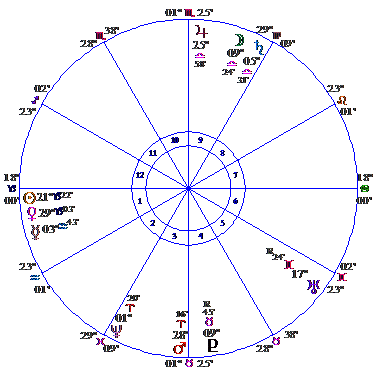
Swami Vivekananda – religious leader

The chart-data – with no time, date or place of birth - was presented in 1001 Notable Nativities - #380. The birth data is: January 12, 1863 at 6.33am LMT: Calcutta, India (22N32; 88E22). It has a AA rating. FC Duff in Modern Astrology quoted the birth record and Vivekananda's website gives the same data. The ascendant was in 18 Capricorn – in the second decanate – and CC Zain commented: And Swami Vivekananda, who sacrificed his life in first bringing to America and establishing the Vedanta religion was born when this section of the zodiac was on the ascendant.
Swami Vivekananda was an Indian religious leader – the chief disciple of the 19th century mystic Sri Ramakrishna Paramahamsa – see page 148 – and the founder of the Ramakrishna Mission in 1898. Vivekananda met Ramakrishna in November 1881 and following the death of his master in August 1886 he formed a fellowship – the first monastery of the disciples of the first Ramakrishna order. Then in July 1893 - at the Parliament of the World's religions in Chicago - he introduced Hinduism to the west. Vivekananda was a key figure in the introduction of Vedanta and yoga in Europe and America and a major force in the revival of Hinduism in modern India. He died at Belur Math, near Calcutta on July 4, 1902 – aged 39.
The Third Decanate of Capricorn – sub-ruler Mercury
The astrological message
The Southern Fish – PISCES AUSTRALIS – is the constellation picturing the Mercury-decanate of Capricorn. It is shown as eagerly drinking the water that flows from the urn of Aquarius. This symbolizes the conception that through the cultivation of the higher emotions it is possible to communicate volitionally with those who have passed to the spirit side of life. Also, that those on earth are, to an undreamed-of extent, the recipients of love and wisdom poured down upon them by those who are of earth no more.
People born under this decanate have natural ability to grasp the ideal and express it in concrete form. Their power of imagination is marked and is united to the faculty of intensive labor. They can follow clerical lines, but to develop their highest talents they should be permitted to develop and execute plans of their own. They readily contact the interior planes and draw valuable information from that source, even when unconscious of the origin of their ideas.
It is the decanate of IDEALISM
Idealism is the intellectual, emotional or practical enhancement of what currently exists. The capacity to idealize and see things as they could be.
Mars – planet of aggressive action - is exalted in the 28th degree of Capricorn
Capricorn – third decanate Sun
Joan of Arc – military leader and Catholic saint

The chart-data – with no time, date or place of birth - was presented in 1001 Notable Nativities - #845 and 971. Alan Leo noted: speculative horoscope by Sepharial, calculated for 2.00am 6.1.1412 OS (Chart 845) and: another version with Uranus and Neptune recalculated (Chart 971). The chart-data is: January 15, 1412 at 2.00am LMT: Domremy La Pucelle, France (48N27; 5E41). The Sun was at 25 Capricorn – in the third decanate – and CC Zain commented: Joan of Arc, who under spirit guidance led France to victory, was born when the Sun was in this decanate. But the birth year is tricky and the birth time is unknown, which doesn't affect the Sun's decanate position. Astro Databank gives January 15, 1413 NS as the birth date making adjustments to the date on the birth record from Edwin Steinbrecher. Wikipedia gives about 1412: And her unknown birth time starts with: 'it is said she was born at the hour when roosters sang, sunrise', and ends with 'one hour after sunset'. Various rectified times exist but they're all rated dirty. Due to the birth year – 1413 – no chart can be presented.
Joan of Arc was a young peasant girl who became a French national hero and Catholic saint. She claimed that when she was 12 she heard 'heavenly voices' and that they had instructed her to expel the English - who had occupied northern France during the Hundred Years' War - and secure the coronation of Charles V11 of France: And even though she was the wrong age, class and gender - to engage in warfare - she achieved both aims. On April 29, 1429 - aged 17(?) – she arrived at the siege of Orleans and on June 18, guided by her spirit voices, she led her army to a great and unexpected victory that reversed the tide of the war. She was again victorious at the Battle of Patay, but her triumphs made her reckless and on May 23, 1430 she was captured at Compiegne by the Burgundians and sold to the British who charged her with witchcraft and heresy and imprisoned her in the tower of Rouen.
Legal proceedings commenced on January 9, 1431 and historians now claim that the trial was highly irregular on a number of counts. Worse still Charles made no attempt to save her. Eventually the ordeal took its toll on her health and in May Joan became very sick. Thinking she was about to die she begged to be given the last rites and on May 29 the judges agreed. On the following day - May 30, 1431- she was burned to death at the stake – aged 19. Later, in 1450, Charles instituted a re-trial and in 1456 Joan was exonerated. Then on April 18, 1909 she was beatified by Pope Pius X; and on May 26, 1920 she was canonized by Pope Benedict XV – Saint Joan of Arc.
Capricorn – third decanate Moon
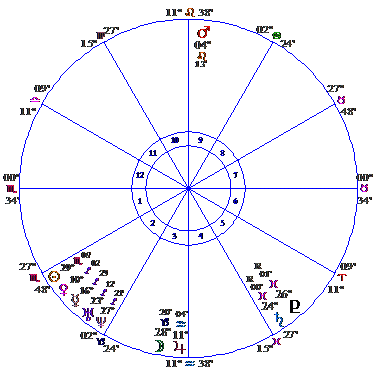
George Eliot – writer

The chart-data – with no time, date or place of birth - was presented in 1001 Notable Nativities - #047. The birth data is: November 22, 1819 at 4.55am: Nuneaton, England (52N32; 1W28). The (3rd house) Moon was in 29 Capricorn 20 – in the third decanate – and CC Zain commented: George Eliot, who attained fame through the ideals expressed in her novels, was born with her Mentality here. But there's a birth time update which doesn't affect the Moon's decanate position. Gene Lockhart quotes 'The Works of George Eliot, Her Life and Letters' for 5.00am - as recorded by her father. It has a AA rating.
George Eliot – or Mary Anne Evans – was an English novelist who used a male pen name to ensure that her works would be taken seriously - and they were. Her novels that are largely set in rural England are admired and appreciated for their realism and psychological insight. They include: The Mill and the Floss, Silas Marner and her masterpiece, Middlemarch. In 1851 she met George Henry Lewes – a married man – and they lived together from 1854 till his death on November 28, 1878. Then after two years' mourning – on May 16, 1880, at the age of 60 – George married John Cross - a man twenty years her junior. But she was not in good health and on December 22, 1880 – aged 61 - Mary Anne Cross died of kidney disease.
Capricorn – third decanate ascendant
Michelangelo – painter and sculptor

This is an incorrect decanate reference. The chart-data – with no time or place of birth - was presented in 1001 Notable Nativities - #472. Alan Leo noted b, 3.3.1475 OS; Gauricus Lucas 1651. The birth data is: March 12, 1475 at 4.00am LMT; Caprese, Italy (43N39; 11E59). The ascendant was in 24 Capricorn – in the third decanate – and CC Zain commented: And Michelangelo, the greatest sculpture and artist of all time, was born with this portion of the zodiac on the ascendant. But the birth date and time are both wrong.
Michelangelo was born on March 15, 1475 and while there's a recorded time it isn't exactly precise. His father noted: 'A male child was born to me on Monday morning (March 6, 1474/75 OS) four or five hours before daybreak'. Daybreak or sunrise occurred at 6.18am and Rodden estimates a birth time of 1.45am – plus or minus half an hour – and gives it a B rating. At 1.45am 24 Sagittarius 30 was on the ascendant, but it's all very uncertain. Due to the birth year – 1475 – no chart can be presented.
Michelangelo di Lodovico Buonarroti Simoni was an Italian painter, sculptor, architect, poet and engineer whose giant talent dominated the High Renaissance.
Soon after he was born Michelangelo's family returned to Florence - their home town: And when he was 13 he was apprenticed to the painter Domenico Ghirlandaio who wisely encouraged the development of his natural gifts. Then in 1496 – aged 21 - he went to Rome and over the next five years produced two famous sculptures – Bachis and Pieta. In 1501 he returned to Florence and carved his masterwork - the colossal statue of David - from a block of Carrara marble: And in 1505 returned to Rome to build a (now famous) tomb for Pope Julius – a forty year project that was not completed till 1545. In the meantime the Pope decided that the vaulting of the Sistine Chapel needed decorating and between 1508 and 1512 Michelangelo worked on what was to be his greatest painting. In 1520 he was commissioned by Pope Clement V11 to design the Medici sepulchral chapel in San Lorenzo: And in 1534 was assigned the task of painting the altar wall of the Sistine Chapel – and over the next six years produced his overwhelming masterpiece – The Last Supper. In 1546 he was appointed chief architect of St. Peter's Church in Rome, and designed its dome. Michelangelo – who did it all for the financial reward - was by nature a solitary and melancholy man. He died in Rome on February 18, 1564 OS - aged 89.

The Aquarius Decanates
The First Decanate of Aquarius – sub-rulers Saturn and Uranus
The astrological message
A horse, which is an animal used to carry a person to a desired location, has been used from ancient times as a symbol of mind. And to picture the Uranus-decanate of Aquarius the ancients placed the head of a horse – EQUULEUS – among the constellations.
Those born under this section of the sky tend to follow their own ideas. They are keenly interested in education and are exceptional in the fullness of their knowledge of human nature. In fact, aside from their inventive ability their greatest asset in life is in knowing how to handle men. And it is a great mistake for them to live apart from close contact with numerous of their fellow humans. The tendencies are decidedly progressive, alert for the new and unique. Consequently, their true mission in life is imparting their enthusiasm for advanced methods and ideas to others.
It is the decanate of ORIGINALITY
Originality is the ability to act, or think in an independent, individual manner. It displays itself as inventiveness – a fresh or novel approach.
Aquarius – first decanate Sun
Samuel Gompers – leader of the American Federation of Labor

Samuel Gompers was born on January 27, 1850 in London, England - when the Sun was in the first decanate of Aquarius – and CC Zain commented: Samuel Gompers, leader of the American federation of Labor, was born with his individuality here. His Sun decanate reference did not require a birth time – only a birth date – and it's unknown if a birth time and chart actually exist for the union leader who played a key role in America's labor history.
Samuel Gompers was an American Union leader who founded the American Federation of Labor (AFL) and served as its president from 1886-1894 and from 1895 until his death in 1924.
In 1860 – aged 10 - Gompers was apprenticed as a shoemaker and then as a cigar maker and in 1863 his family emigrated to America and settled in New York on Manhattan's lower East Side. He married in 1866 and became a US citizen in 1872.
In 1864 Samuel Gompers joined Local 15 of the Cigarmakers' International Union and in 1875 was elected president of Local 144. Then in 1877, when the union nearly collapsed, Gompers with his friend Adolph Strasser used Local 133 as a base to rebuild the Cigarmakers' Union. They introduced a high dues structure and implemented programs to pay out-of-work benefits, sick benefits and death benefits for union members of good standing. At a time when wage reductions were a regular daily occurrence he encouraged workers to organize. He claimed that workers were powerless in an isolated condition and it was the duty of every Cigar Maker to join the Cigarmakers' Union. In 1886 he was elected second vice-president of the international union, and first vice-president in 1896. During World War1 Gompers and the AFL worked with the government to avoid strikes and boost morale, without undermining union wages and hour standards. He died on December 13, 1924.
Even though Samuel Gomper's birth time is unknown his life story boasts of altruism and other outstanding qualities signified by his Sun sign - Aquarius. He promoted harmony among the different craft unions that comprised the AFL – tried to minimize jurisdictional battles – and promoted thorough organization and collective bargaining to secure shorter hours and higher wages. He believed that these were the first essential steps to emancipating labor – and by living up to his astrological potential he contributed his utmost to human welfare and fulfilled his reason for being.
Aquarius – first decanate Moon
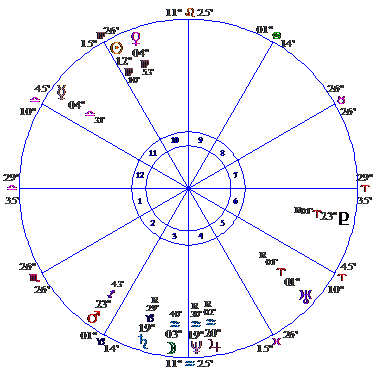
James Coates – mesmerist

The chart-data – with no time, date or place of birth - was presented in 1001 Notable Nativities - #934. Alan Leo noted: time approximate. The birth data is: September 5, 1843 at 10.00am LMT: Belfast, Ireland (54N35; 5W55). Rodden sources the same data to Old Moore magazine 8/1909 and gives it a C rating – original source not known. The (3rd house) Moon was at 3 Aquarius 40 – in the first decanate – and CC Zain commented: James Coates, mesmerist and author on books on character-reading, was born when the Moon was in this decanate.
James Coates was an Irish author, mesmerist and phrenologist. His books include Human Magnetism, Self Control, Seeing the Invisible, How to Mesmerize and Easy Guide to Mesmerism and Hypnotism – which is still available in an updated and enlarged format.
Mesmerism, or hypnosis, was named after the Austrian physician – Friedrich Anton Mesmer (1734-1815) – but the the book promotion for Easy Guide to Mesmerism and Hypnotism claims that ancient mesmerism is completely different from modern hypnosis – corresponding to the use of Prana or Ki (Chi) in the Orient. This latest version of Easy Guide includes Dr Coates' complete original text.
Aquarius – first decanate Ascendant
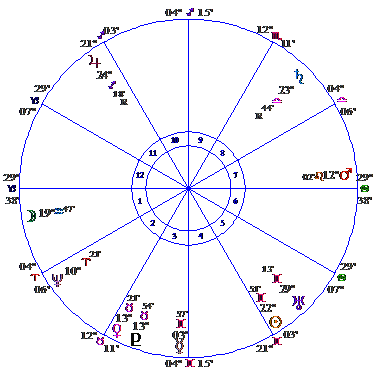
W B Yates – poet

This is an uncertain decanate reference. The chart-data – with no time, date or place of birth - was presented in 1001 Notable Nativities - #960. The birth data is: June 13, 1865 at 10.40pm: Sandymount, Ireland (53N58; 6W22). The birth time - from the Family Bible - has a AA rating. The ascendant was in 00 Aquarius 00 – in the first decanate – and CC Zain commented: And W B Yeats, poet, was born with his Personality polarized in this portion of the zodiac. But 00 Aquarius 00 was not on the ascendant. 29 Capricorn 38 was there and Alan Leo had rounded it off. So - if Yeats was born at 10.40pm his ascendant was in the third decanate of Capricorn, but if he was born at 10.41pm the first decanate of Aquarius was rising. The validity of the decanate reference hinges on an absolutely precise birth time.
William Butler Yates was an Irish poet, dramatist and scholar – one of the foremost figures of 20th Century literature. His finest works include the plays The Countess Cathleen (1892) and The Land of Heart's Desire (1894) - and the poems The Wild Swan at Coole (1917) and The Tower (1928). From 1922 to 1928 he was a senator of the Irish Free State - and in 1923 he was awarded the Nobel Prize for Literature. Yates – who drew heavily on Irtish legend to create allusive, sensory imagery – died on January 28, 1939 near Nice, France – aged 73.
The Second Decanate of Aquarius – sub-ruler Mercury
The astrological message
The flying horse – PEGASUS – pictures among the constellations the Mercury-decanate of Aquarius. The wings pictured upon the symbol of mind indicate the ability to leave the material body and travel in the super-physical world in the astral form. This may take place volitionally, or quite unconsciously so far as the objective mind is concerned, during sleep. And those who can bring through into the objective state the information so contacted have a never-ending supply of interesting material that they often are able to present in a fascinating manner.
People (born) under this decanate possess naturally the ability to gain information from invisible sources. Consequently, they have unlimited resourcefulness in imaginative creation. And they are able to present their conceptions in a most dramatic manner. So, by all means, they should follow some occupation where the mind has power to exert itself. And when not inclined to literature they should read much and learn to express their thoughts in conversations. They convey their ideas to others in a most convincing manner. And through this faculty lies their greatest good, both to themselves and to humanity.
It is the decanate of INSPIRATION
Inspiration is a state of being inspired. It's the capacity to experience an undisclosed prompting – a sudden, brilliant or timely idea.
Mercury – the planet of intellect and expression - is exalted in the 15th degree of Aquarius
Aquarius – second decanate Sun
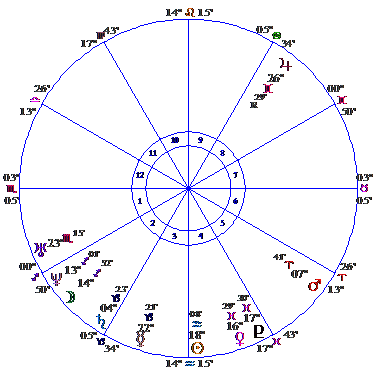
Charles Dickens – novelist

The chart-data – with no time, date or place of birth - was presented in 1001 Notable Nativities - #907. Alan Leo noted: This map is without doubt correct, according to Childhood and Youth of Charles Dickens, Langton 1883, pp. 13,14. The birth data is: February 7, 1812 at 11.59pm: Portsmouth, England (50N48; 1W05). ( Langton actually wrote 'about midnight'.) The (4th house) Sun was in 18 Aquarius 08 – in the second decanate – and CC Zain commented: Charles Dickens, the famous novelist, was born with his Individuality here. But there's another birth time which doesn't affect the Sun's decanate position. Luke Broughton quotes Dickens for a time of 7.50pm, from Professor Wilson. It has a C rating.
Charles John Huffam Dickens was the most popular English novelist of the Victorian era and one of the most popular of all time. His novels include: Oliver Twist (1837), Nicholas Nickleby (1838), The Old Curiosity Shop (1840), David Copperfield (1850), A Tale of Two Cities (1859) and Great Expectations (1861). Dickens, who displayed immense creative energy and a keen eye for the social and economic inequalities of Victorian society, has been praised for his mastery of prose and his teeming gallery of unique personalities: And his novels and short stories have never been out of print. He died in Gadshill, England on June 9, 1870 – aged 58.
Aquarius – second decanate Moon
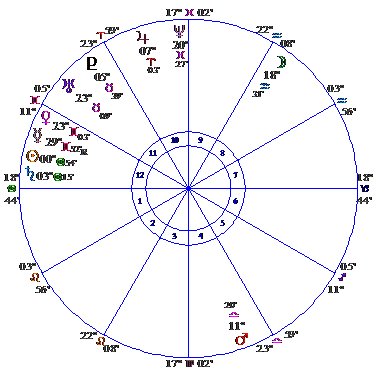
H Rider Haggard – novelist

The chart-data – with no time, date or place of birth - was presented in 1001 Notable Nativities - #914. The birth data is: June 22, 1856 at 5.10am LMT: Norwich, England (52N38; 1E18). The birth time - from the Family Bible – will be pretty close. It has a AA rating, but could be standard time (GMT). The (8th house) Moon was in 18 Aquarius 31 – in the second decanate – and CC Zain commented: H. Rider Haggard, another famous novelist had his Moon in this decanate.
Henry Rider Haggard was an English writer who wrote adventure novels set in exotic locations. They include: King Solomon's Mines (1885), She (1887), Jess (1887) and Allan Quatermain (1887). She is considered a classic of imaginative literature. It's one of the best-selling books of all time with sales of 83 million copies at 1965 - and Hollywood transformed Allan Quatermain into Indiana Jones. Haggard - who spent his youth in South Africa - became a solicitor in London in 1884 – wrote King Solomon's Mines in six weeks – and was knighted in 1912. He's been praised for his literary skill and 'sheer imaginative power' and is best described as a true story teller. He wrote over 75 books and his autobiography – Days of My Life - was published after his death on May 14, 1925 – aged 68.
Aquarius – second decanate Ascendant
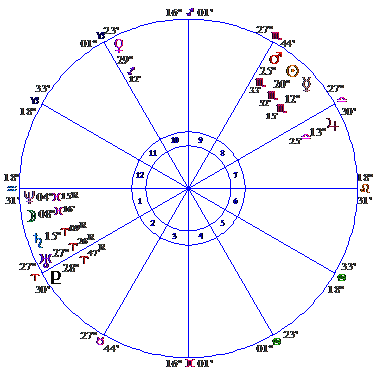
Robert Louis Stevenson – novelist

The chart-data – with no time, date or place of birth - was presented in 1001 Notable Nativities - #243. The birth data is: November 13, 1850 at 1.30pm LMT: Edinburgh, Scotland (55N57; 3W13). The birth time - from family records – has a AA rating, but it could be standard time (GMT) and won't be 100% precise. The ascendant was at 18 Aquarius 31 – in the second decanate- and CC Zain commented: And Robert Louis Stevenson, still another wonderful writer of romance, had this section of the zodiac on the ascendant at his birth.
Robert Louis Stevenson was a Scottish novelist, poet, essayist and travel writer. His novels include: Treasure island (1883), Kidnapped (1886) and The Strange case of Dr. Jekyll and Mr. Hyde (1886). Stevenson was a strange looking and eccentric individual who suffered poor health throughout his life. In 1867 he entered the University of Edinburgh to study engineering, but in April 1871 announced his intention to pursue a life of letters. He traveled widely – searching in vain to find a place that would benefit his health – and in 1890 purchased four hundred acres of land in Upola, one of the Samoan Islands. He died there on December 3, 1894 – probably of a cerebral haemorrhage. He was 44 years old.
The Third Decanate of Aquarius – sub-ruler Venus
The astrological message
The Libra-decanate of Aquarius is pictured by CETUS, which mythology informs us is the largest constellation in the sky. This Whale was the monster that devoured the innocent youths of the country as a punishment for the haughty pride of their queen.
In this manner is symbolized the tendency of those born under this influence to enter into matrimony from other motives than those of pure love; or, from some material motive renouncing love altogether, to be consumed by its energy inversely directed.
These people reach their greatest efficiency and attainment only in harmonious association with a kindred soul of opposite sex. When they deny true love, or make it subservient to material ambitions they are in great danger. But when they follow the dictates of the heart and realize companionship in the higher sense they become efficient workers for human betterment. A solitary life is not beneficial to these people. They should mix with others and take a keen interest in helping to make the world a better place in which to live. This is the work for which they are fitted.
It is the decanate of REPRESSION
Repression is the action, process or result of suppressing into the unconscious mind, or of actively excluding from the conscious mind, painful or disagreeable memories, ideas, feelings or impulses.
Aquarius – third decanate Sun
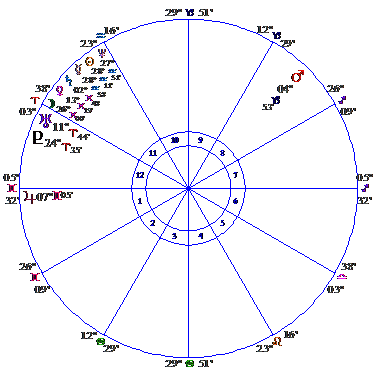
CW Leadbeater – theosophical writer

The chart-data – with no time, date or place of birth - was presented in 1001 Notable Nativities - #866. Alan Leo noted: private source, time approximate. The birth data is: February 17, 1847 at 10.21am LMT: Stockport, England (53N25; 2W10). The (11th house) Sun was in 28 Aquarius 11 – in the third decanate – and CC Zain commented: C W Leadbeater, the Theosophical writer, was born when the Sun was in this decanate: But there are two birth years – 1847 and 1854 - and a vague birth time - 'believed to be in the morning' – which don't affect the Sun's decanate position. The data is rated dirty so an accurate astrological profile is not possible.
Charles W Leadbeater was a British author, occultist and theosophist. In 1890 he met Annie Bessant – see page 22 - and in 1894 they began re-writing the geology and history of the world in their books on Atlantis and Lemuria. But Leadbeater had a dark-side to his soul – a sexual attraction to young boys – and in January 1906 his dark-side was exposed. This created a crisis for The Theosophical Society and he never again held office although he did continue his occult researches with Besant. With his reputation in tatters he moved to Australia where he became a catholic priest and bishop. He died in Sydney, NSW, on March 1, 1934.
Aquarius – third decanate Moon
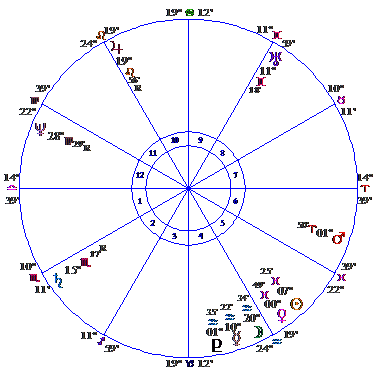
John Cooper- translator

This is an uncertain decanate reference. The chart-data – with no time, date or place of birth - was presented in 1001 Notable Nativities - #704. Alan Leo noted: born 24.2.1778. The birth data is: February 25, 1778 at 9.00pm LMT; London, England presumed (51N30; 00W06). It has a C rating – original source not known. The (4th house) Moon was at 20 Aquarius 34 – in the third decanate – and CC Zain commented: John Cooper, who did work of great value toward human enlightenment in translating the 'Primum Mobile' of Placidus was born with the Moon here. But the birth time is uncertain and if Cooper was born before 8.00pm - one hour before the time used to calculate the chart - the Moon was in the second decanate of Aquarius.
Placidus de Titus was an Italian astrologer and mathematician who discerned, through his study of Claudius Ptolemy's ancient astrological work –
Tetrabiblos, what he believed was Ptolemy's lost method of house division. He published his findings in two volumes in 1650 and 1657. Then, at the end of the eighteenth century, Manoah Sibley translated some of his writings into English and in 1814 a second translation of his Primum Mobile was published by John Cooper. All branches of Hermetic Astrology use the Placidus system of house cusp division.
Aquarius – third decanate ascendant
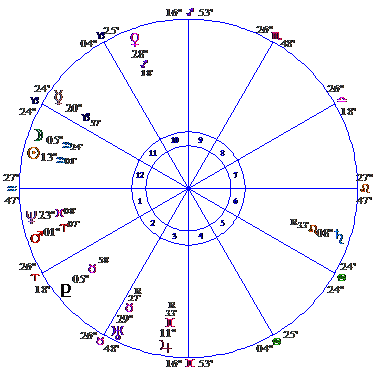
Havelock Ellis – author

The chart-data – with no time, date or place of birth - was presented in 1001 Notable Nativities - #766. The birth data is: February 2, 1859 at 8.15am LMT: Croydon, England (51N23; 00W06). It has a C rating – original source not known. The ascendant was at 27 Aquarius 47 – in the third decanate – and CC Zain commented: And Havelock Ellis, author of 'Sexual Inversion' and other works dealing with sex, was born with this part of the zodiac on the Ascendant. But its validity depends upon the accuracy of the birth time.
Havelock Ellis was a British sexologist, physician and social reformer. His books include:
Studies in the Psychology of Sex (1897-1928 in seven volumes),
The Psychology of Conflict (1919), The Dance of Life (1923) and his autobiography
My Life (1939). In his youth Ellis was inclined to travel, but in April 1879 – aged 20 - he decided to study sex and thought it best to acquire a medical qualification. Then in November 1891 he married Edith Lees – an English writer – but she was a lesbian and they lived apart - he alone in his bachelor rooms in Paddington. Meanwhile his studies into human sexual activity resulted in important new concepts that were later taken up by Sigmund Freud. Ellis died in Ipswich, England on July, 8, 1939 – aged 80.

The Pisces Decanates
The First Decanate of Pisces – sub-rulers Jupiter and Neptune
The astrological message
The Neptune-decanate of Pisces is pictured among the constellations by CEPHEUS – the King – whose foot rests upon the immovable Pole-Star. He holds aloft a scepter cut from the Tree of Life, and his crown is surmounted by seven globes representing the seven planets and septenary law in nature.
People born under this section of the sky are naturally interested in understanding Nature, particularly in its psychic and spiritual aspects. They are mystics, to the manor born, and seek truth not so much through the methods of exact science and reason as through the exercise of their psychic faculties. They readily becomes seers, and have a natural aptitude for grasping the esoteric interpretation of all phenomena. This ability to recognize the truth through the 'inner response' becomes of value in the world of affairs in connection with secret-service work of all kinds. They are detectives of the highest order, whether their talents be directed to social conditions, or to the wider mysteries of universal relations.
It is the decanate of VERITY
Verity is truth – the quality of being true or in accordance with fact or reality. It's a true, genuine, valid or bona fide statement, principle, belief, doctrine or idea.
Pisces – first decanate Sun
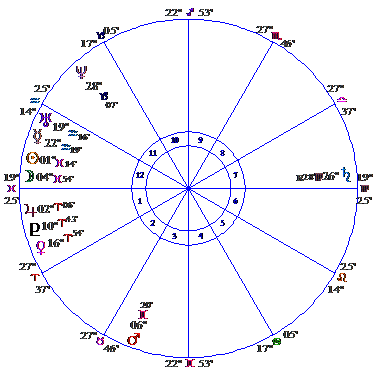
Ramakrishna – Indian mystic and religious leader

This is an incorrect decanate reference. The chart-data – with no time, date or place of birth - was presented in 1001 Notable Nativities - #367. The birth data is: February 20, 1833 at 7.30am LMT: Karmarpukar, India (25N15; 87E52). The (12th house) Sun was at 1 Pisces 14 – in the first decanate – and CC Zain commented: Ramkrishna, the famous Yogi, whose influence over the Vedanta Philosophy, was so great and beneficial, was born when the Sun was here: But the birth date is incorrect. Astro Databank gives February 18, 1836 at 5.00am (sunrise?) - quoting 'Sri Ramakrishna. The Great Master, Vol 2' – and this puts the Sun at 28 Aquarius 23 – in the third decanate. Internet sources also give this date. It has a B – for biography - rating.
Sri Ramakrishna Paramahamsa was a famous Indian mystic whose religious school of thought – the Vedanta philosophy - led to the formation of the Ramakrishna Mission by his chief disciple Swami Vivekananda – see page 130. His ideas based on the ancient Verdic scriptures stress the unity of religion. He took over as the priest of the Kali temple in Calcutta in 1856 – at age 20 – and went on to play an influential role in the revitalization of India and the Hindu renaissance of the 19th and 20th centuries. Many of his disciples consider him an avatar - or incarnation of God. He died of throat cancer in Calcutta, India on August 16, 1886 – aged 50.
Pisces – first decanate Moon
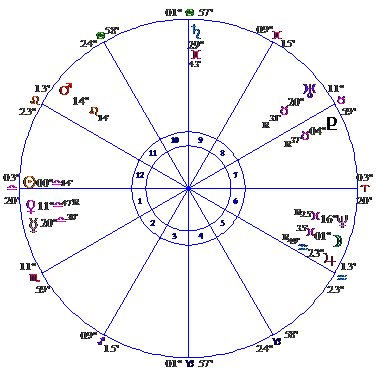
Richard Hodgson – psychic investigator

This is an uncertain decanate reference. The chart-data – with no time, date or place of birth - was presented in 1001 Notable Nativities - #372. Alan Leo noted: time approximate. The birth data is: September 24, 1855 at 6.00am LMT: Adelaide, South Australia (34S55; 138E35). It has a C rating. The Moon was in 1 Pisces 35 – in the first decanate - and CC Zain commented: Dr. Richard Hodgson, whose psychical – not physical – researches led him to investigate the phenomena associated with H P Blavatsky, was born when the Moon was in this decanate. But the Moon moved from Aquarius to Pisces at 3.19am – 2 hours and 41 minutes before the approximate time of birth – so its validity hinges on the accuracy of the birth time.
Richard Hodgson was a psychic researcher who, as the Secretary of the Society of Psychical Research, scientifically investigated trance mediums and the paranormal phenomena they produced. Helena Blavatsky – see page 68 - was a medium who claimed to have demonstrated levitation, clairvoyance, out-of-the body projection, telepathy and clairaudience and in 1885 Hodgson investigated her psychic abilities and concluded that she was a fraud. But in 1986 the Society of Psychical Research had his original report re-examined by Dr Vernon Harrison who concluded that Blavatsky had been unjustly condemned. Hodgson died suddenly in 1905 – aged 49.
Pisces – first decanate Ascendant
William Lilly – horary astrologer and author

There's some uncertainty with this decanate reference. The chart-data – with no time, date or place of birth - was presented in 1001 Notable Nativities - #617. Alan Leo noted: according to Gadbury : b. 30. 4. 1602 OS. The birth data is: May 11, 1602 at 2.08am LMT: Diseworth, England (52N50; 1W16). The ascendant was at 5 Pisces – in the first decanate – and CC Zain commented: And Wm. Lilly, best of the older authorities on horary astrology, had this portion of the zodiac on the ascendant at his birth. But the validity of the decanate reference hinges on the birth time and Astro Databank gives 2.00am – quoting Lilly's letter to his friend Elias Ashmole – see Nell Gwyn page 53. The 2.00am time, which gets an A rating, puts 2 Pisces 04 on the ascendant, but Lilly's letter indicates the time is rectified so it's all a little bit dodgy. Due to the birth year – 1602 – no chart can be presented.
The chart data is:
The ascendant was in the first decanate of Pisces and Pluto was in the 1st house. The Sun was in the 2nd house at 19 Taurus 59 – in the second decanate - trine, Moon, conjunction Venus, opposition Saturn and square Neptune. The Moon was in the 11th house at 14 Capricorn 51 – in the second decanate – square Jupiter and sextile Uranus: And Mercury was in the 2nd house at 4 Taurus 15R – in the first decanate – conjunction Uranus. The Sun, Mercury, Venus and Uranus were in the 2nd house; Neptune was in the 6th; Mars and Jupiter were in the 7th; and Saturn was in the 8th.
William Lilly was a famed English astrologer and occultist who specialized in horary astrology. He received a basic classical education and in 1619 – aged 17 – went to London and found employment as an aid to an elderly couple. Then, in 1627, when his master died Lilly married his widow and in 1633 - when she died - she left him a legacy - about 1,000 pounds - which gave him financial independence and the time to study astrology. At the start he was just a dabbler, but in 1642 he got serious and carefully revised all his previous reading. In 1644 he published his first almanac – and then a new one each year until his death. It was the most popular of all the predictive manuals. His most comprehensive book – Christian Astrology (in three volumes) – was published in 1647 and in 1985 a facsimile of the original edition was published. In 1666 he was involved in a controversy for allegedly predicting the Great Fire of London fourteen years before it occurred. William Lilly - who made a remarkable number of right predictions - died in Hersham, Surrey on June 9, 1681 – aged 79.
The Second Decanate of Pisces – sub-ruler Moon
The astrological message
The second decanate of Pisces is pictured among the constellations by ANDROMEDA – the Princess chained to the rock for the sea-monster to devour. It symbolizes the earth-bound conditions of the human soul that passes to the spirit side of life obsessed with the desire for material reincarnation. It also represents those noblest of all mankind who suffer persecution and imprisonment that the rest of humanity may prosper.
The lives of persons born under this section of the sky are usually filled with restrictions and limitations. Often these conditions are assumed voluntarily as the price enacted by the world for the sake of assisting in its progress. When living at their best they are readily impressed by those on the spirit side of life, and are often chosen to carry out some important mission on earth. They grasp more readily than others the true meaning of universal brotherhood, and they get the most out of life through alleviating the physical and mental suffering of their fellow man.
It is the decanate of SELF-SACRIFICE
Self-sacrifice is the surrendering or giving up of one's interests, desires, happiness etc, as for duty or the good, or sake, of another.
Mercury – the planet of intellect and expression - is exalted in the 15th degree of Aquarius
Pisces – second decanate Sun
Nicolaus Copernicus – astronomer

The chart-data – with no time, date or place of birth - was presented in 1001 Notable Nativities - #469. Alan Leo noted – b. 19.2.1473 OS. The birth data is: February 28, 1473 at 5.00pm LMT: Torun, Poland (53N02; 18E35). The Sun was in 10 Pisces 11 – in the second decanate – and CC Zain commented: Nicholas Copernicus, who was largely responsible for the adoption of the present system of astronomy, and suffered for his apparent heresy, was born with the Sun here. Astro Databank gives the same data quoting 'Nicolas Copernicus' by J. Scperkowicz - 'data from astrologers present at his birth', but states that the birth time was recorded in Local Apparent Time (LAT), which converts to 5.13pm LMT – but it won't be precise. It was no doubt rounded-off to 5.00pm LAT. Astro Databank gives February 28, 1473 at 5.13pm LMT a AA rating. Due to the birth year – 1473 – no chart can be presented.
The chart data is:
The Ascendant was at 4 Virgo 02 – in the first decanate – and Pluto was in the 1st house. The Sun was in the 7th house at 10 Pisces 11 – square Moon and Jupiter, trine Uranus and opposition Pluto. The Moon was in the 4th house at 5 Sagittarius 23 – in the first decanate – trine Venus and conjunct Jupiter: And Mercury was in the 8th house at 26 Pisces 30 – in the third decanate. Uranus and Neptune were in the 3rd house; the Moon and Jupiter were in the 4th; Mars was in the 6th; Mercury and Venus were in the 8th; and Saturn was in the 10th.
Nicolaus Copernicus was a Polish mathematician, astronomer, physician, classical scholar, translator, artist, jurist, governor, military leader, diplomat and economist who viewed astronomy – the field in which he made his greatest contribution – as little more than an avocation. He first told his friends of his theory - that the Earth rotates on its axis and the planets - in their orbits - revolve around the Sun in 1514: And then he set to work to gather and document the hard evidence to prove it. Twenty-two years later, in 1536, De revolutionibus orbium coelestium - On the Revolutions of the Celestial Spheres - was more or less complete, but despite the insistence of friends and associates he refused to publish – probably because he feared religious objection. Then in 1543 – just before his death - he eventually published the book that many regard as the starting point of modern astronomy. Nicolaus Copernicus - the man who with one great stupendous thought displaced the Earth from the center of the universe - died in Frombork on May 25, 1543 – aged 70.
Pisces – second decanate Moon
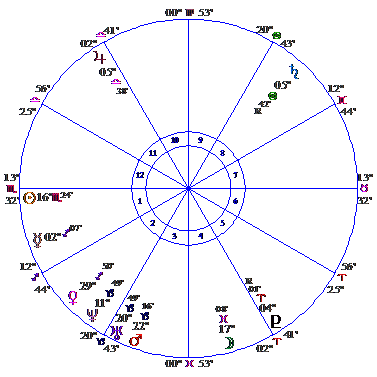
Charubel (John Thomas) – seer, mystic and astrologer

The chart-data – with no time, date or place of birth - was presented in 1001 Notable Nativities - #105. The birth data is: November 9, 1826 at 7.00am LMT: Montgomery, Wales (52N33; 3W03). Fagan quotes the Family Bible so the data has a AA rating. The (4th house) Moon was at 17 Pisces 08 – in the second decanate – and CC Zain commented: Charubel, author of 'Degrees of the Zodiac Symbolized', a seer and worker in behalf of the esoteric wisdom, had his Mentality in this decanate.
Charubel - John Thomas – was a Welsh seer and mystic. He first worked as a psychic – and then he formed an occult order called the Celestial Brotherhood – became Charubel – healed the sick (Scorpio) – edited several journals – had little interest in money - married twice – and in 1890 got into dire financial difficulties, which he failed to foresee. His contribution to astrology - Degrees of the Zodiac Symbolized - was published in Alan Leo's Astrological Manual No V11 in 1898. He obtained the degree descriptions psychically to help rectify the birthchart's ascendant. Thomas, who claimed to have second sight or precognition, dedicated his life to studying the laws of nature and the laws of life – but his spirit contacts were not always reliable. He died in Manchester, England on November 11, 1908 – age 82 years and 2 days.
Pisces – second decanate Ascendant
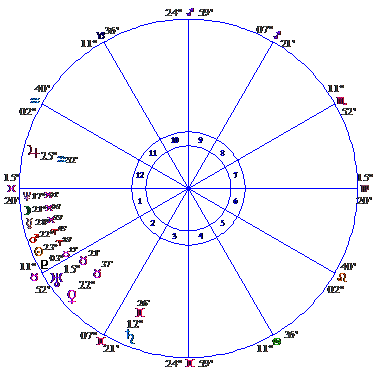
TH Burgoyne – author and adept

This chart is presented on page 2 of Brotherhood of Light Course 1 – The Laws of Occultism. The birth data given there is: April 14, 1855 at 4.11am 3 W; 54 N. The ascendant was at 15 Pisces 20 – in the second decanate – and CC Zain commented: And T H Burgoyne, author of 'Light of Egypt' and adept in the highest sense of the word, who suffered persecution for his views, was born with this part of the zodiac on the ascendant. But the co-ordinates 3 W; 54 N put the birth place in the Irish Sea and the birth time could have been GMT not LMT. Astro Databank states Lancaster – 54N03; 2W48. The data has a AA rating.
Thomas Henry Burgoyne – the co-founder of the Hermetic Brotherhood of Luxor - was a seer, adept, astrologer and writer. As a child he made contact with the Brotherhood of Light – a discarnate group of spiritual beings who attempt to guide the destiny of humankind – and in his books - Light of Egypt (1889), The Language of the Stars (1892) and Celestial Dynamics (1896) – he introduced the Brotherhood's teachings to the wider-world. They exist today as The Brotherhood of Light lessons written by CC Zain – see page 120. Thomas Burgoyne died in Humboldt Country, California in March 1894 – aged 38 – and his books Celestial Dynamics and Light of Egypt Volume 11 were published posthumously.
The Third Decanate of Pisces – sub-rulers Mars and Pluto
The astrological message
The last decanate of Pisces is pictured among the constellations by CASSIOPEIA – the Queen on her thrown. It is the sex-decanate of the sign of imprisonment, and mythology attributes the imprisonment of her daughter to the pride of this queen to her beauty. However, in another story she is the queen who furnished her children with the Ram that bore the golden fleece and carried them to heaven.
Therefore, we find those born under this influence to have eventful lives, and to be capable of entering upon and succeeding in a wide variety of careers. It is the last section of the zodiac, and they seem often to recapitulate in their lives the events and conditions we expect from many other decanates. They are unusually adaptable, are likeable people, and require excitement and change. They reach their highest value in psychical research, and in adopting and advocating such a life as will prepare man for existence after the change called death.
It is the decanate of VICISSITUDES
Vicissitude is change as a natural process or tendency. Vicissitudes are changes in circumstance – uncertainties or variations of fortune or outcome.
Venus – planet of love - is exalted in the 27th degree of Pisces.
Pisces – third decanate Sun
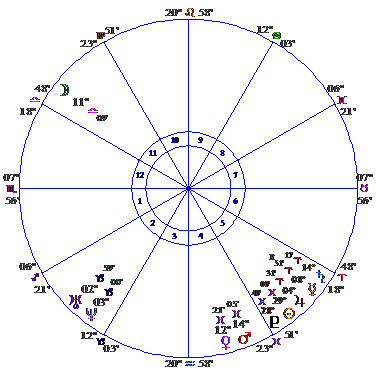
Sir Richard Burton – explorer-author and linguist

The chart-data – with no time, date or place of birth - was presented in 1001 Notable Nativities - #356. Alan Leo noted: time approximate, rectified. The birth data is: March 19, 1821 at 9.45pm LMT: Torquay, England (3W30; 50N28). The Sun was at 29 Pisces 00 – in the third decanate – and CC Zain commented: Sir Richard Burton, the famous traveler, who was so expert at disguise and as a linguist that he passed as a native in many lands, was born when the Sun was here. But there's a birth time update, which doesn't affect the Sun's decanate position. Astro Databank gives 9.30pm quoting his biography 'Pioneer to Poet' – but the birthplace Hertford, is incorrect. Burton was born at Torquay, Devon. This data has a B rating.
Sir Richard Francis Burton was an English explorer, translator, writer, soldier, orientalist, ethnologist, linguist, poet, hypnotist, fencer and diplomat. He's most widely known for his travels and explorations - within Asia and Africa - and his extraordinary knowledge of languages and cultures, but his translations of Eastern erotica in The Kama Sutra, The Arabian Nights and The Perfumed Garden shocked England's delicate Victorian society. He died in Trieste, Austria-Hungary on October 20, 1890 of a heart attack – aged 69: And after his death his wife, Isabel, burned many of his manuscripts. Her actions were widely condemned.
Pisces – third decanate Moon
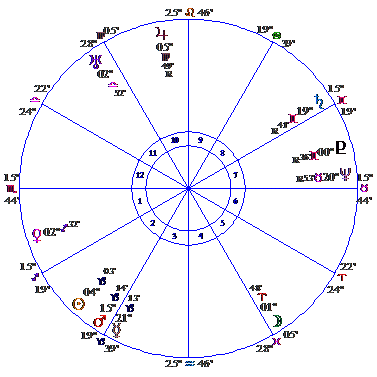
Evelyn Nesbitt Thaw – actress

This is an uncertain decanate reference. The chart-data – with no time, date or place of birth - was presented in 1001 Notable Nativities - #704. Alan Leo noted: born 24.2.1778. The birth data is: February 25, 1778 at 9.00pm LMT; London, England presumed (51N30; 00W06). It has a C rating – original source not known. The (4th house) Moon was at 20 Aquarius 34 – in the third decanate – and CC Zain commented: John Cooper, who did work of great value toward human enlightenment in translating the 'Primum Mobile' of Placidus was born with the Moon here. But the birth time is uncertain and if Cooper was born before 8.00pm - one hour before the time used to calculate the chart - the Moon was in the second decanate of Aquarius.
Evelyn Nesbitt was an American actress, artists' model, chorus girl and homicide witness whose life was marred by alcoholism, drug addiction and (failed) suicide attempts. The shooting of Stanford White - referred to by CC Zain - occurred on June 25, 1906. Harry Thaw – Nesbitt's husband – shot White three times in the face, killing him instantly. At the trial Thaw pleaded temporary insanity and got acquitted – and Evelyn got a divorce. She died in Santa Monica on January 17, 1967 – aged 82.
Pisces – third decanate ascendant
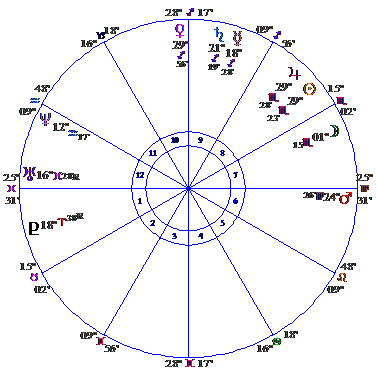
Empress Frederick of Germany

The chart-data – with no time, date or place of birth - was presented in 1001 Notable Nativities - #045. The birth data is: November 21, 1840 at 1.50pm LMT: Buckingham Palace (51N30); 00W08). The data - from an official Palace announcement - has an A rating. The ascendant was at 25 Pisces 31 – in the third decanate – and CC Zain commented: And Empress Frederick of Germany, mother of Kaiser Wilhelm of world-war notoriety, was born with this section of the zodiac on the ascendant.
Empress Frederick-Victoria was the eldest child and daughter of Queen Victoria of the United Kingdom and Prince Albert of Saxe-Coburg. She was created Princess Royal of the United Kingdom in 1841: And her marriage to Prince William of Prussia – on January 25, 1858 - at age seventeen – was both a love match and a dynastic alliance. On January 27, 1859 - at 3.00pm LMT – Potsdam, Germany (13E04; 52N23) – she gave birth to Kaiser Wilhelm – of World-War 1 notoriety – the first of their eight children. Her husband ascended the throne as Emperor Frederick 111 on March 9, 1888, but he was terminally ill with throat cancer and died after reigning 99 days. She then became known as the Empress Frederick. In 1899 Frederick-Victoria was diagnosed with inoperable breast cancer. She died on August 5, 1901 – aged 60.

|
|
|


























































































